
家がないとはどういうことか?
What do you think about Homelessness?

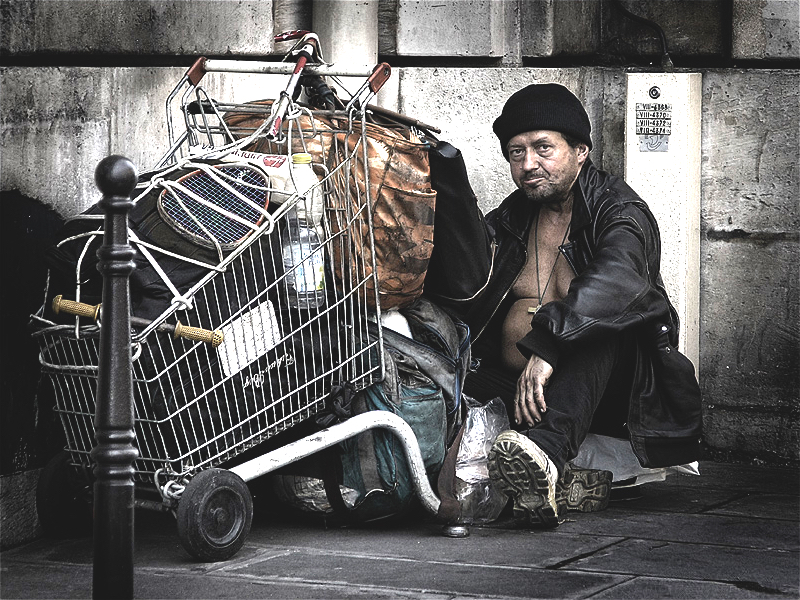
A
homeless man
in Paris
☆ ホームレス(Homelessness or houselessness)とは、安定した安全で機能的な住居を持たない状態のことである。この一般的なカテゴリーには、路上生活 者、家族や友人など一時的な宿泊施設を転々とする者、住居の保証がない寄宿舎に住む者、内紛のために居住地を離れ、国内で難民となった者など、さまざまな 状況が含まれる。 ホームレスの法的地位は地域によって異なる。米国政府のホームレス人口調査では、公共の場所や私的な場所であっても、人間の通常の寝床として設計されてい ない場所で寝泊まりする人々も含まれる。ホームレスと貧困は相互に関連している。ホームレスの数を数え、彼らのニーズを特定する方法論についてはコンセン サスが得られていないため、ほとんどの都市ではホームレスの推定人口しか把握されていない。 2005年には、世界で推定1億人がホームレスとなり、10億人(当時は6.5人に1人)が不法占拠者、難民、または一時的なシェルターで生活している。 旅する無宿者は、過去には浮浪者と呼ばれていた。Bumは、定住するホームレスの一般的な蔑称である。
★bum ; of poor quality or nature, not valid or deserved, not pleasant or enjoyable. - Merriam-Webster.
| Homelessness or
houselessness – also known as a state of being unhoused or
unsheltered
– is the condition of lacking stable, safe, and functional housing. The
general category includes disparate situations, such as living on the
streets, moving between temporary accommodation such as family or
friends, living in boarding houses with no security of tenure,[1] and
people who leave their domiciles because of civil conflict and are
refugees within their country. The legal status of homeless people varies from place to place.[2] United States government homeless enumeration studies[3][4] also include people who sleep in a public or private place, which is not designed for use as a regular sleeping accommodation for human beings.[5][6] Homelessness and poverty are interrelated.[1] There is no methodological consensus on counting homeless people and identifying their needs; therefore, in most cities, only estimated homeless populations are known.[7] In 2005, an estimated 100 million people worldwide were homeless, and as many as one billion people (one in 6.5 at the time) live as squatters, refugees, or in temporary shelters.[8][9][10] Unhoused persons who travel have been termed vagrants in the past; of those, persons looking for work are hobos, whereas those who don't are tramps. Bum is a general term of disparagement for a stationary homeless person. |
ホームレスとは、安定した安全で機能的な住居を持たない状態のことであ
る。この一般的なカテゴリーには、路上生活者、家族や友人など一時的な宿泊施設を転々とする者、住居の保証がない寄宿舎に住む者[1]、内紛のために居住
地を離れ、国内で難民となった者など、さまざまな状況が含まれる。 ホームレスの法的地位は地域によって異なる[2]。米国政府のホームレス人口調査[3][4]では、公共の場所や私的な場所であっても、人間の通常の寝床 として設計されていない場所で寝泊まりする人々も含まれる[5][6]。 ホームレスと貧困は相互に関連している[1]。ホームレスの数を数え、彼らのニーズを特定する方法論についてはコンセンサスが得られていないため、ほとん どの都市ではホームレスの推定人口しか把握されていない[7]。 2005年には、世界で推定1億人がホームレスとなり、10億人(当時は6.5人に1人)が不法占拠者、難民、または一時的なシェルターで生活している [8][9][10]。旅する無宿者は、過去には浮浪者と呼ばれていた。Bumは、定住するホームレスの一般的な蔑称である。 |
| United Nations definition In 2004, the United Nations sector of Economic and Social Affairs defined a homeless household as those households without a shelter that would fall within the scope of living quarters due to a lack of a steady income. The affected people carry their few possessions with them, sleeping in the streets, in doorways or on piers, or in another space, on a more or less random basis.[11] In 2009, at the United Nations Economic Commission for Europe Conference of European Statisticians (CES), the Group of Experts on Population and Housing Censuses defined homelessness as: In its Recommendations for the Censuses of Population and Housing, the CES identifies homeless people under two broad groups: Primary homelessness (or rooflessness). This category includes persons living in the streets without a shelter that would fall within the scope of living quarters Secondary homelessness. This category may include persons with no place of usual residence who move frequently between various types of accommodations (including dwellings, shelters, and institutions for the homeless or other living quarters). This category includes persons living in private dwellings but reporting 'no usual address on their census form. The CES acknowledges that the above approach does not provide a full definition of the 'homeless'.[12] Article 25 of the Universal Declaration of Human Rights, adopted 10 December 1948 by the UN General Assembly, contains this text regarding housing and quality of living: Everyone has the right to a standard of living adequate for the health and well-being of himself and of his family, including food, clothing, housing, and medical care and necessary social services, and the right to security in the event of unemployment, sickness, disability, widowhood, old age or other lack of livelihood in circumstances beyond his control.[13] The ETHOS Typology of Homelessness and Housing Exclusion was developed as a means of improving the understanding and measurement of homelessness in Europe, and to provide a common "language" for transnational exchanges on homelessness. The ETHOS approach says homelessness is a process (rather than a static phenomenon) that affects many vulnerable households at different points in their lives.[14] The typology was launched in 2005 and is used for different purposes: as a framework for debate,[15] for data collection purposes, policy purposes, monitoring purposes, and in the media. This typology is an open exercise that makes abstraction of existing legal definitions in the EU member states. It exists in 25 language versions, the translations being provided mainly by volunteer translators. Many countries and individuals do not consider housing as a human right. Former U.S. President Jimmy Carter addressed this issue in a 2017 interview, saying, "A lot of people don't look at housing as a human right, but it is." His view contrasts with many Americans who do not believe housing is a basic human right.[16] |
国連の定義 2004年、国連の経済社会問題部門は、ホームレス世帯を、安定した収入がないために、居住区に該当するようなシェルターを持たない世帯と定義した [11]。被災者はわずかな所持品を持ち歩き、多かれ少なかれ不規則に、路上や玄関、橋脚の上、あるいは別の空間で寝泊まりしている[11]。 2009年、国連欧州経済委員会の欧州統計家会議(CES)において、人口・住宅統計に関する専門家グループはホームレスを次のように定義した: 人口・住宅統計に関する勧告の中で、CESはホームレスの人々を2つのグループに分類している: 第一次ホームレス(または屋根なし)。このカテゴリーには、住居に該当するようなシェルターのない路上生活者が含まれる。 二次的ホームレス。このカテゴリーには、さまざまなタイプの宿泊施設(住居、シェルター、ホームレスのための施設、その他の居住施設を含む)を頻繁に行き 来する、通常の居住地を持たない人が含まれる。このカテゴリーには、民間の住居に住んでいるが、国勢調査用紙に「通常の住所がない」と報告した人も含まれ る。 CESは、上記のアプローチが「ホームレス」の完全な定義を提供するものではないことを認めている[12]。 1948年12月10日に国連総会で採択された世界人権宣言の第25条には、住居と生活の質に関して次のような記述がある: すべての人は、食糧、衣服、住居、医療及び必要な社会サービスを含め、自己及び家族の健康及び福祉に十分な生活水準を確保する権利、並びに失業、病気、障 害、寡婦、老齢その他自己の支配の及ばない状況において生計を維持することができない場合の保障を受ける権利を有する」[13]。 ETHOS Typology of Homelessness and Housing Exclusion(ホームレスと住宅排除のETHOS類型論)は、ヨーロッパにおけるホームレスの理解と測定を改善し、ホームレスに関する国境を越えた 交流に共通の「言語」を提供する手段として開発された。ETHOSのアプローチでは、ホームレスとは(静的な現象ではなく)人生のさまざまな局面で多くの 脆弱な世帯に影響を与えるプロセスであるとしている[14]。 この類型論は2005年に発表され、議論の枠組みとして、データ収集目的、政策目的、モニタリング目的、メディア[15]など、さまざまな目的で利用され ている。この類型論は、EU加盟国における既存の法的定義を抽象化した、オープンな演習である。25の言語版があり、翻訳は主にボランティア翻訳者によっ て行われている。 多くの国や個人は、住宅を人権とみなしていない。ジミー・カーター元米大統領は2017年のインタビューでこの問題を取り上げ、「多くの人は住宅を人権と は見ていないが、人権である」と述べた。彼の見解は、住宅が基本的人権であると信じていない多くのアメリカ人とは対照的である[16]。 |
| Other terms Recent[when?] homeless enumeration survey documentation utilizes the term unsheltered homeless. The common colloquial term "street people" does not fully encompass all unsheltered people, in that many such persons do not spend their time in urban street environments. Many shun such locales, because homeless people in urban environments may face the risk of being robbed or assaulted. Some people convert unoccupied or abandoned buildings ("squatting"), or inhabit mountainous areas or, more often, lowland meadows, creek banks, and beaches.[17] Many jurisdictions have developed programs to provide short-term emergency shelter during particularly cold spells, often in churches or other institutional properties. These are referred to as warming centers, and are credited by their advocates as lifesaving.[18] |
その他の用語 最近[いつ?]のホームレス人口調査文書では、unsheltered homelessという用語が使われている。一般的に「路上生活者」と口語で呼ばれるホームレスの多くは、都市部の路上で過ごしているわけではない。都市 環境にいるホームレスの人々は、強盗や暴行に遭う危険性があるため、そのような場所を敬遠する人が多い。無人の建物や放棄された建物を改造したり(「スク ワット」)、山間部や、より頻繁には低地の草原、小川の堤防、海岸に居住する人もいる[17]。 多くの管轄区域では、特に寒い時期に短期間の緊急避難所を提供するプログラムを開発しており、多くの場合、教会やその他の施設の敷地内に設置されている。 これらはウォーミングセンターと呼ばれ、その擁護者たちは人命救助につながると信じている[18]。 |
| History This section possibly contains original research. Please improve it by verifying the claims made and adding inline citations. Statements consisting only of original research should be removed. (February 2011) (Learn how and when to remove this template message) Early history through the 19th century Further information: Homelessness in England and Homelessness in the United States  The Bowery Mission in New York City, c. 1800s 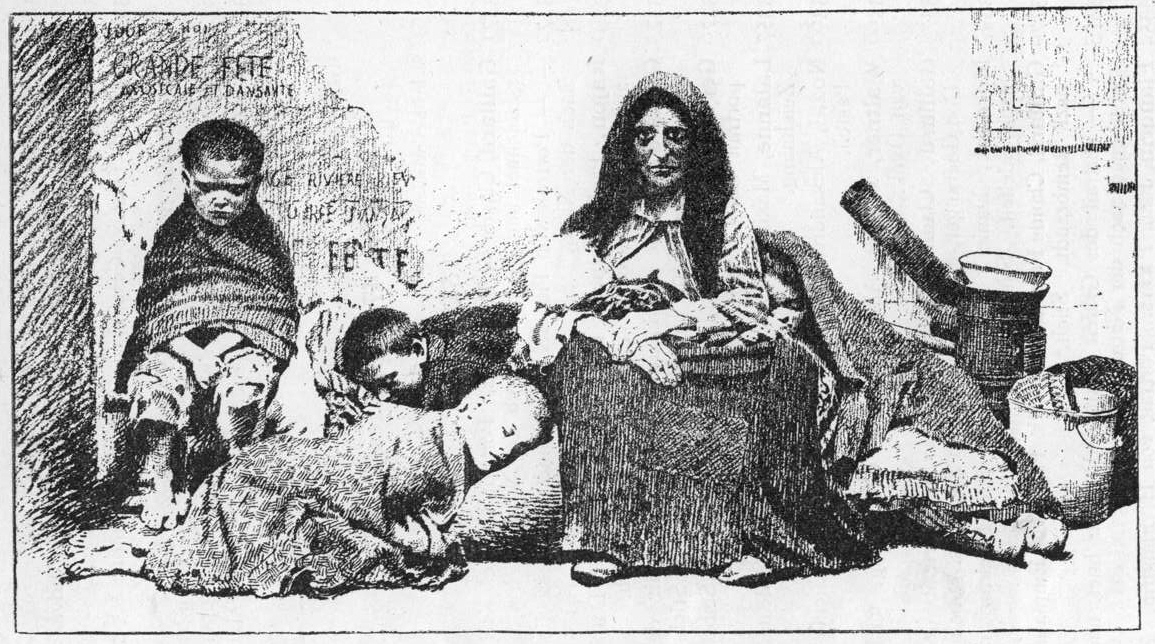 German illustration of a homeless mother and her children in the street, before 1883 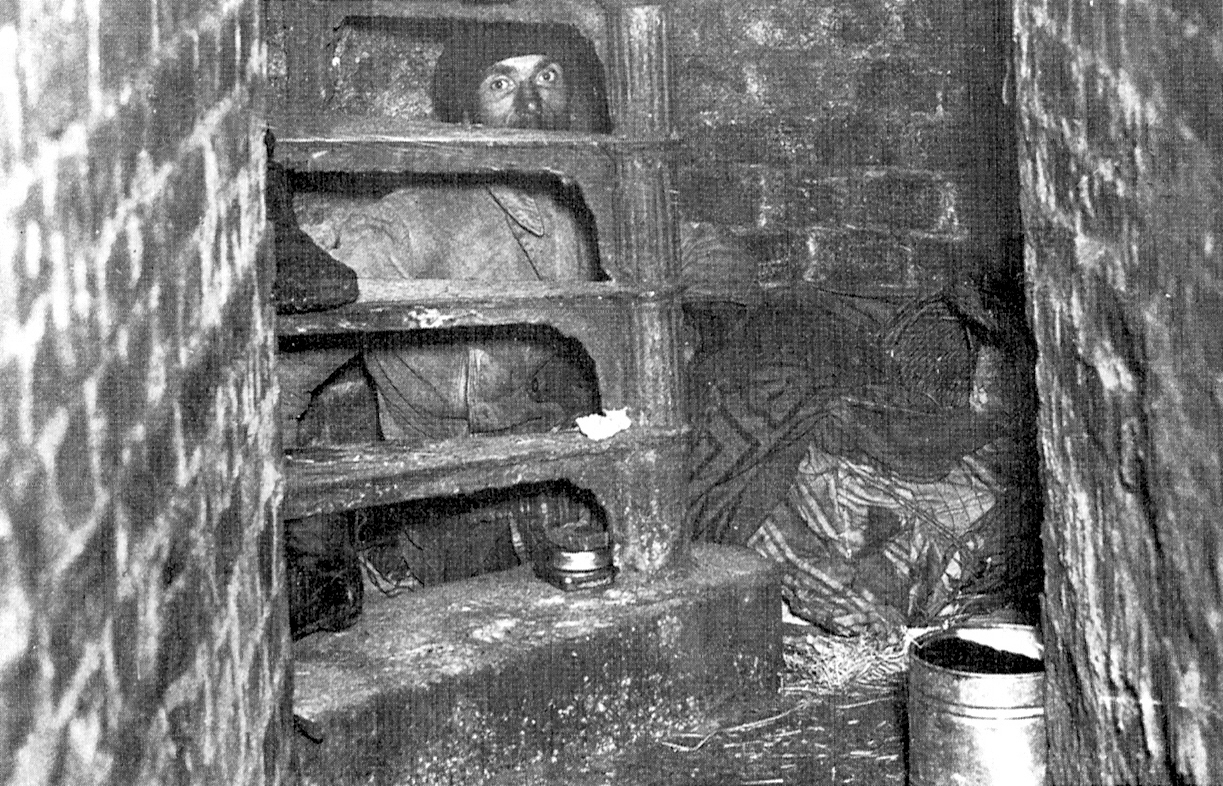 A homeless man living in a sewer, Vienna, Austria, c. 1900 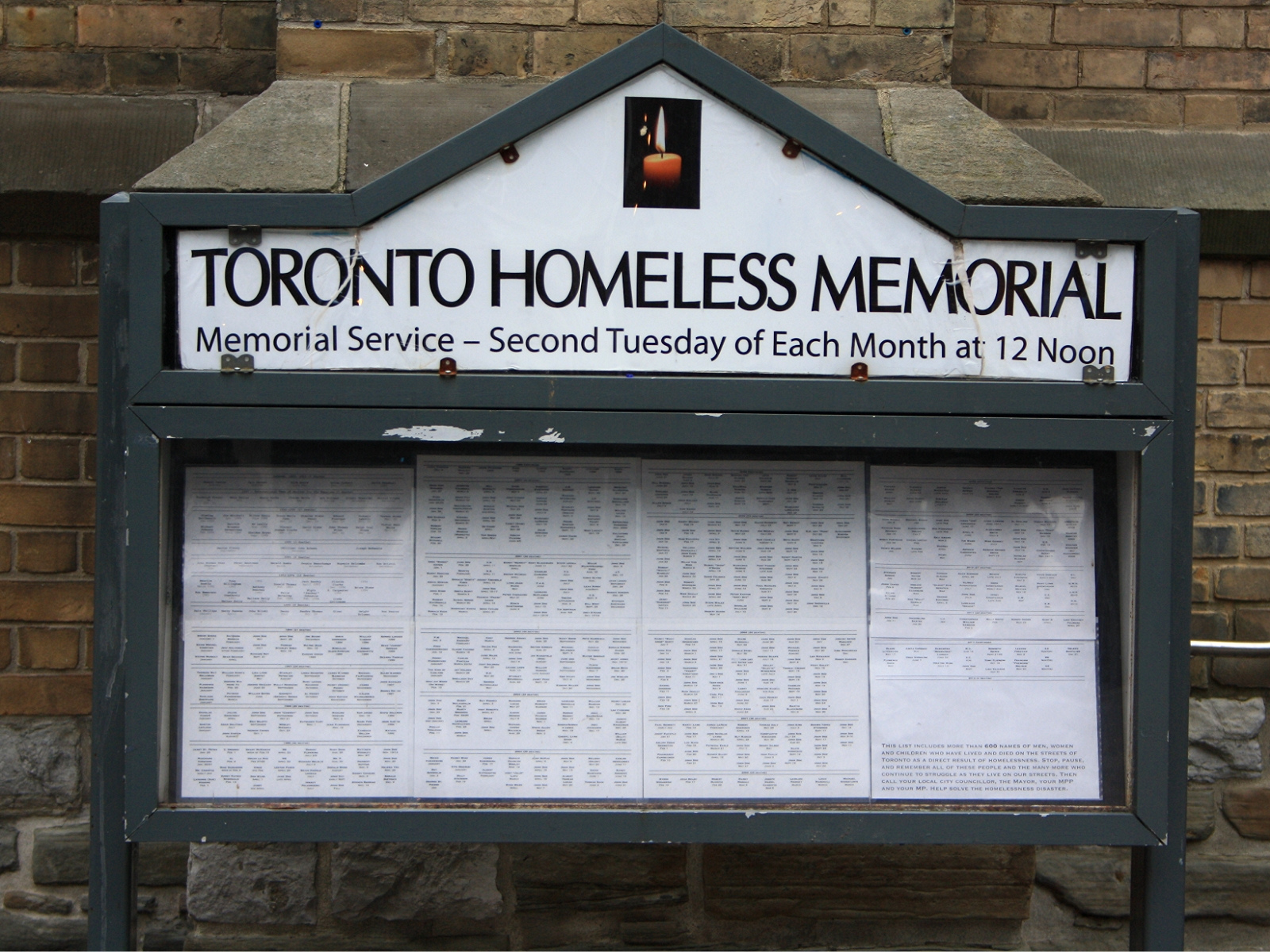 A memorial to homeless people in Toronto, Canada United Kingdom Following the Peasants' Revolt, English constables were authorized under 1383 English Poor Laws to collar vagabonds and force them to show support; if they could not, the penalty was gaol.[19] Vagabonds could be sentenced to the stocks for three days and nights; in 1530, whipping was added. The presumption was that vagabonds were unlicensed beggars.[19] In 1547, a bill was passed that subjected vagrants to more provisions of the criminal law, namely two years servitude and branding with a "V" as the penalty for the first offense and death for the second. Many vagabonds were among the convicts transported to the American colonies in the 18th century.[20] During the 16th century in England, the state first tried to give housing to vagrants instead of punishing them, by introducing bridewells to take vagrants and train them for a profession. In the 17th and 18th centuries, these were replaced by workhouses but these were intended to discourage too much reliance on state help.[citation needed] United States In the Antebellum South, the availability of enslaved labor made it difficult for poor white people to find work. To prevent them from cooperating with enslaved black people, slaveowners policed poor whites with vagrancy laws.[21] After the American Civil War, a large number (by the hundreds or thousands) of homeless men formed part of a counterculture known as "hobohemia" all over the United States. In smaller towns, hobos temporarily lived near train tracks and hopped onto trains to various destinations.[22][23] The growing movement toward social concern sparked the development of rescue missions, such as the U.S. first rescue mission, the New York City Rescue Mission, founded in 1872 by Jerry and Maria McAuley.[24][25] Modern 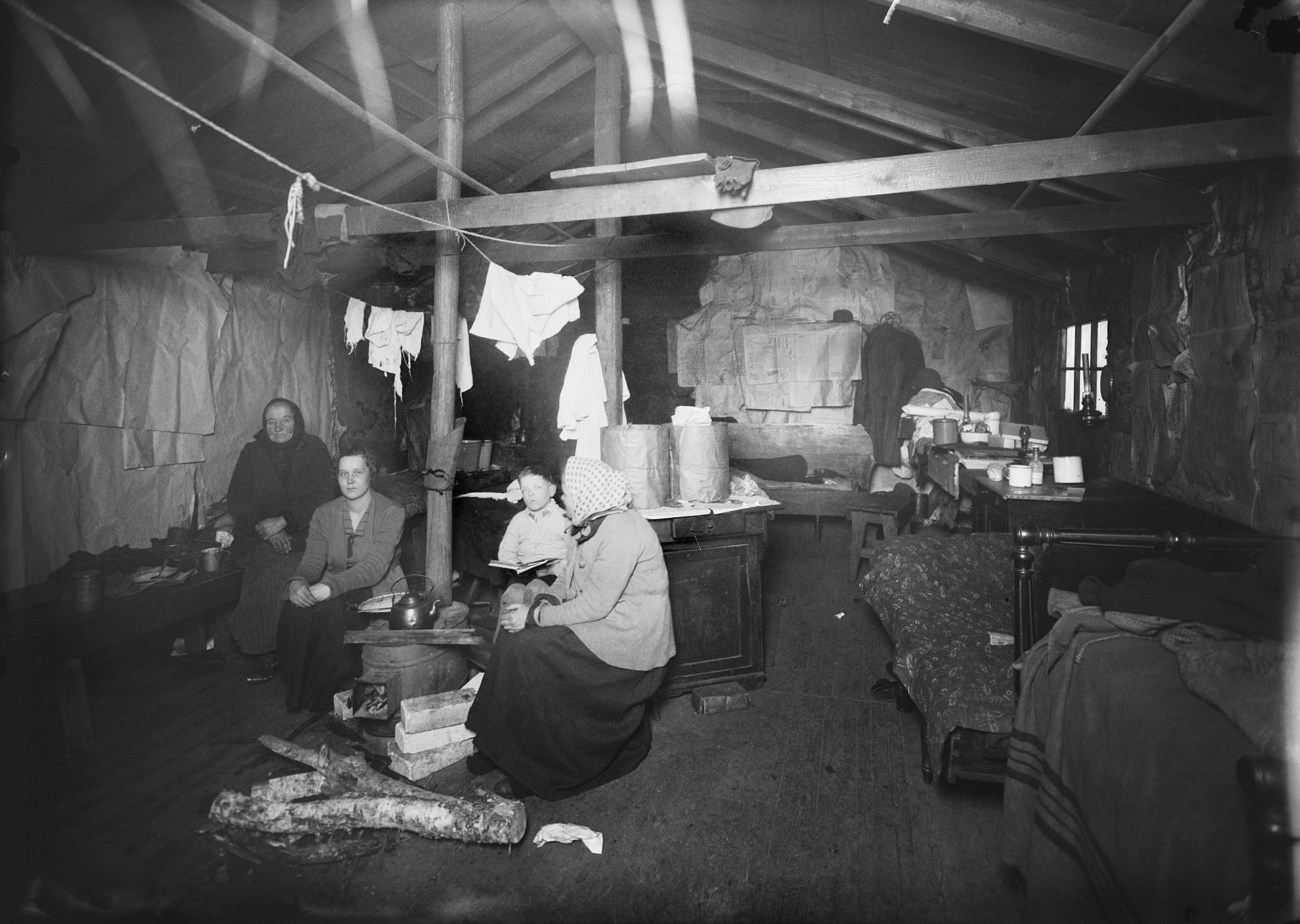 Temporary housing for those evicted from their apartments in Sörnäinen, Helsinki, Finland in 1924 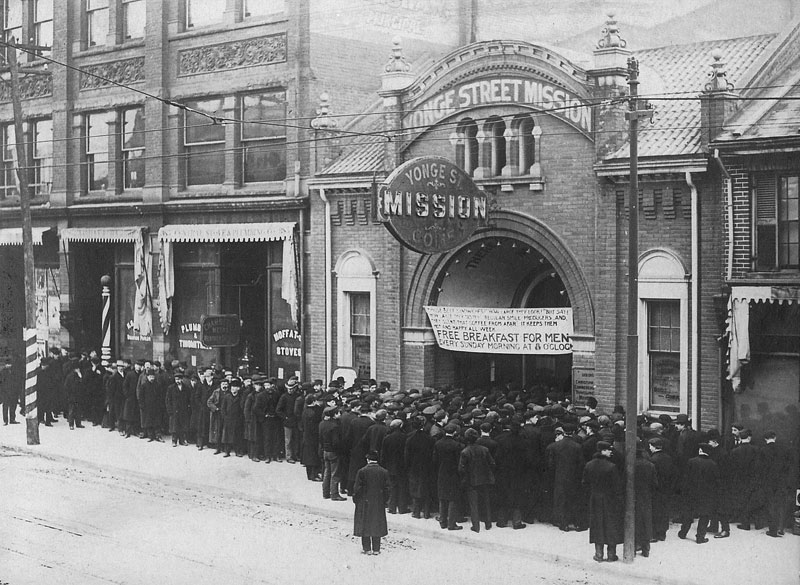 Food line at the Yonge Street Mission, Yonge Street, Toronto, Canada, in the 1930s 20th century Further information: Homelessness in the United States § Historical_background The U.S. Great Depression of the 1930s caused an epidemic of poverty, hunger, and homelessness in the United States. When Franklin D. Roosevelt took over the presidency from Herbert Hoover in 1933, he signed the New Deal, which expanded social welfare, including providing funds to build public housing.[26] How the Other Half Lives and Jack London's The People of the Abyss (1903) discussed homelessness and raised public awareness, which caused some changes in building codes and some social conditions. In England, dormitory housing called "spikes" was provided by local boroughs. By the 1930s in England, 30,000 people were living in these facilities. In 1933, George Orwell wrote about poverty in London and Paris, in his book Down and Out in Paris and London. In general, in most countries, many towns and cities had an area that contained the poor, transients, and afflicted, such as a "skid row". In New York City, for example, there was "the Bowery" – traditionally, where people with an alcohol use disorder were to be found sleeping on the streets, bottle in hand. In the 1960s in the U.K., the nature and growing problem of homelessness changed in England as public concern grew. The number of people living "rough" in the streets had increased dramatically. However, beginning with the Conservative administration's Rough Sleeper Initiative,[when?] the number of people sleeping rough in London fell dramatically. This initiative was supported further by the incoming Labour administration from 2009 onwards with the publication of the 'Coming in from the Cold' strategy published by the Rough Sleepers Unit, which proposed and delivered a massive increase in the number of hostel bed spaces in the capital and an increase in funding for street outreach teams, who work with rough sleepers to enable them to access services.[27] Scotland saw a slightly different picture, with the impact of the right to buy ending in a significant drop in available social housing. The 1980s and the 1990s resulted in an ever-increasing picture of people becoming homeless.[citation needed] 2000s In 2001, the Scottish Parliament came into place. It was agreed by all parties that a ten-year plan to eradicate homelessness by the end of 2012 would be implemented. The Minister of Housing[who?] met with the third sector and Local Authorities every six weeks, checking on progress, whilst consultations brought about legislative change, alongside work to prevent homelessness. There was a peak in applications around 2005, but from there onwards figures dropped year on year for the next eight years. However, with a focus on the broader numbers of people experiencing homelessness, many people with higher levels of need got caught in the system. Work from 2017 started to address this, with a framework put in place to work towards a day where everyone in Scotland has a home suitable to meet their needs.[citation needed] In 2002, research showed that children and families were the largest growing segment of the homeless population in the United States,[28][29] and this has presented new challenges to agencies. In the U.S., the government asked many major cities to come up with a ten-year plan to end homelessness.[when?] One of the results of this was a "Housing First" solution. The Housing First program offers homeless people access to housing without having to undergo tests for sobriety and drug usage. The Housing First program seems to benefit homeless people in every aspect except for substance abuse, for which the program offers little accountability.[30] An emerging consensus is that the Housing First program still gives clients a higher chance at retaining their housing once they get it.[31] A few critical voices[who?] argue that it misuses resources and does more harm than good; they suggest that it encourages rent-seeking and that there is not yet enough evidence-based research on the effects of this program on the homeless population.[32] Some formerly homeless people, who were finally able to obtain housing and other assets which helped to return to a normal lifestyle, have donated money and volunteer services to the organizations that provided aid to them during their homelessness.[33] Alternatively, some social service entities that help homeless people now employ formerly homeless individuals to assist in the care process. 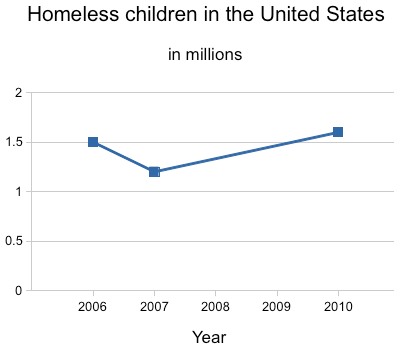 Homeless children in the United States.[34] The number of homeless children reached record highs in 2011,[35] 2012,[36] and 2013[37] at about three times their number in 1983.[36] Homelessness has migrated toward rural and suburban areas. The number of homeless people has not changed dramatically but the number of homeless families has increased according to a report by HUD.[38] The United States Congress appropriated $25 million in the McKinney-Vento Homeless Assistance Grants for 2008 to show the effectiveness of Rapid Re-housing programs in reducing family homelessness.[39][40][41] In February 2009, President Obama signed the American Recovery and Reinvestment Act of 2009, part of which addressed homelessness prevention, allocating $1.5 billion for a Homeless Prevention Fund. The Emergency Shelter Grant (ESG) program's name was changed to Emergency Solution Grant (ESG) program, and funds were reallocated to assist with homeless prevention and rapid re-housing for families and individuals.[42] In January 2024 the United States Supreme Court agreed to make a decision on whether city laws that punish individuals to limit the growth of homeless encampments are in violation of the Constitution's limits for cruel and unusual punishment.[43] |
沿革 このセクションにはオリジナルの研究が含まれている可能性があります。主張を検証し、インライン引用を追加することで改善してください。独創的な研究のみ からなる記述は削除してください。(2011年2月) (このテンプレートメッセージを削除する方法とタイミングを学ぶ) 19世紀までの初期の歴史 その他の情報 イギリスのホームレス問題とアメリカのホームレス問題  ニューヨークのバワリー・ミッション(1800年代頃  路上のホームレスの母親と子供たちを描いたドイツのイラスト(1883年以前  下水道で生活するホームレスの男性(1900年頃、オーストリア・ウィーン  カナダ、トロントのホームレス追悼碑 イギリス 農民反乱の後、イギリスの警官は1383年のイギリス貧民法の下で、浮浪者に首輪をつけ、扶養を示すよう強制する権限を与えられた。1547年、浮浪者に さらに刑法の規定を課す法案が可決され、初犯は2年の隷属と「V」の烙印、再犯は死刑とされた[19]。18世紀にアメリカの植民地に移送された囚人の中 には、多くの浮浪者が含まれていた[20]。 16世紀のイギリスでは、国家が浮浪者を処罰する代わりに住居を与えようとしたのが最初で、浮浪者を受け入れて職業訓練を行うブライドウェルを導入した。 17世紀から18世紀にかけて、これらはワークハウスに取って代わられたが、国家の援助に頼りすぎることを抑制することが目的であった[要出典]。 アメリカ合衆国 前世紀南部では、奴隷労働力が利用可能であったため、貧しい白人が仕事を見つけることは困難であった。奴隷化された黒人と協力することを防ぐために、奴隷 所有者は浮浪者法で貧しい白人を取り締まった[21]。 アメリカ南北戦争後、多数の(数百から数千人の)ホームレスの男たちが、アメリカ全土で「ホーボヘミア」として知られるカウンターカルチャーの一部を形成 した。小さな町では、ホーボーは一時的に線路の近くに住み、様々な目的地へ向かう列車に飛び乗った[22][23]。 社会的関心の高まりは、1872年にジェリーとマリア・マコーリーによって設立された米国初のレスキュー・ミッションであるニューヨーク・シティ・レス キュー・ミッションのようなレスキュー・ミッションの発展に火をつけた[24][25]。 近代  1924年、フィンランドのヘルシンキ、ソルナイネンのアパートから追い出された人々のための仮設住宅。  1930年代、カナダ、トロントのヨンジー・ストリートにあるヨンジー・ストリート・ミッションの食料配給ライン 20世紀 さらなる情報 米国のホームレス問題 § 歴史的背景 1930年代の米国大恐慌は、米国に貧困、飢餓、ホームレスの蔓延を引き起こした。1933年にハーバート・フーバーから大統領職を引き継いだフランクリ ン・D・ルーズベルトはニューディールに署名し、公営住宅の建設資金を提供するなど社会福祉を拡大した[26]。 How the Other Half Lives』やジャック・ロンドンの『The People of the Abyss』(1903年)はホームレスについて論じ、人々の意識を高め、建築基準法やいくつかの社会状況に変化をもたらした。イギリスでは、「スパイ ク」と呼ばれる寄宿舎が自治体によって提供された。イギリスでは1930年代までに、3万人がこうした施設に住んでいた。1933年、ジョージ・オーウェ ルは著書『Down and Out in Paris and London』の中で、ロンドンとパリの貧困について書いている。一般的に、ほとんどの国では、多くの町や都市に「スキッドロウ」のような貧困層、過渡的 な生活者、苦悩を抱えた人々を収容する地域があった。たとえばニューヨークには「バワリー」があり、伝統的にアルコール依存症の人々がボトル片手に路上で 寝泊まりしていた。 1960年代のイギリスでは、社会的関心が高まるにつれ、ホームレス問題の性質と深刻さが変化した。路上で "ラフ "に暮らす人々の数が劇的に増加したのだ。しかし、保守党政権のラフ・スリーパー・イニシアチブを皮切りに[いつから?]、ロンドンで寝泊まりする人の数 は劇的に減少した。このイニシアチブは、2009年以降の次期労働党政権によって、ラフ・スリーパー・ユニット(Rough Sleepers Unit)が発表した「寒さの中からやってくる(Coming in from the Cold)」戦略によってさらに支援され、首都におけるホステルのベッド数の大幅な増加と、路上生活者がサービスを利用できるようにするための路上支援 チームへの資金増額が提案され、実現した[27]。 スコットランドでは少し様相が異なり、購入権の影響により、利用可能な社会的住宅が大幅に減少した。1980年代と1990年代は、ホームレスになる人々 が増え続ける結果となった[要出典]。 2000s 2001年、スコットランド議会が発足。2012年末までにホームレスを撲滅するための10年計画を実施することが全政党によって合意された。住宅大臣は 6週間ごとに第三セクターや自治体と面会し、進捗状況を確認する一方、ホームレス対策と並行して法改正のための協議が行われた。申請件数は2005年頃に ピークを迎えたが、その後8年間は年々減少していた。しかし、ホームレス状態にある人々の幅広い数に焦点を当てた結果、より高いレベルのニーズを持つ多く の人々が制度に巻き込まれた。2017年からはこれに対処するための取り組みが開始され、スコットランドに住むすべての人が、それぞれのニーズを満たすに ふさわしい住まいを持つ日を目指して取り組む枠組みが導入された[要出典]。 2002年、米国ではホームレス人口の中で最も増加しているのが子どもと家族であるという調査結果が発表され[28][29]、これは機関にとって新たな 課題となった。 米国では、政府が多くの主要都市に対し、ホームレス状態をなくすための10年計画を策定するよう要請した。ハウジング・ファースト・プログラムは、ホーム レスの人々に、酒気帯び検査や薬物使用検査を受けることなく住居を提供するものである。ハウジング・ファースト・プログラムは、薬物乱用以外のあらゆる面 でホームレスの人々に恩恵をもたらしているようだが、このプログラムではほとんど説明責任を果たしていない[30]。 ハウジング・ファースト・プログラムは、いったん住居を確保すれば、より高い確率でその住居を維持できるというのが、新たなコンセンサスである[31]。 少数の批判的な声[誰?]は、このプログラムは資源を悪用し、利益よりも害をもたらすと主張している。 [32]最終的に住宅やその他の資産を手に入れることができ、普通の生活に戻ることができた元ホームレスの人々の中には、ホームレス時代に援助をしてくれ た団体に寄付をしたり、ボランティアサービスを提供したりする人もいる[33]。  アメリカのホームレスの子どもたち[34]。ホームレスの子どもの数は2011年、[35]2012年、[36]2013年[37]に過去最高を記録し、 1983年の約3倍となった[36]。 ホームレスの数は農村部や郊外へと移動している。HUDの報告書によると、ホームレスの数は劇的に変化していないが、ホームレスの家族の数は増加している [38]。米国議会は、家族ホームレスの減少におけるラピッド・リハウジング・プログラムの効果を示すために、2008年のマッキニー=ヴェントホームレ ス支援補助金に2500万ドルを計上した[39][40][41]。 2009年2月、オバマ大統領は2009年アメリカ復興・再投資法に署名し、その一部としてホームレス予防に取り組み、ホームレス予防基金に15億ドルを 割り当てた。緊急シェルター補助金(ESG)プログラムの名称は、緊急解決補助金(ESG)プログラムに変更され、資金はホームレス予防と家族・個人の迅 速な再入居を支援するために再配分された[42]。 2024年1月、アメリカ合衆国最高裁判所は、ホームレスの野宿者の増加を制限するために個人を罰する市の法律が、残酷で異常な刑罰に対する憲法の制限に 違反しているかどうかについて判断を下すことに合意した[43]。 |
| Causes Major reasons for homelessness include:[44][45][46][47][48] Rent and eviction Gentrification is a process in which a formerly affordable neighborhood becomes popular with wealthier people, raising housing prices and pushing poorer residents out. Gentrification can cause or influence evictions, foreclosures, and rent regulation. Increased wealth disparity and income inequality cause distortions in the housing market that push rent burdens higher, making housing unaffordable.[49][original research?] In many countries, people lose their homes by government orders to make way for newer upscale high-rise buildings, roadways, and other governmental needs.[50] The compensation may be minimal, in which case the former occupants cannot find appropriate new housing and become homeless. Mortgage foreclosures where mortgage holders see the best solution to a loan default is to take and sell the house to pay off the debt can leave people homeless.[51] Foreclosures on landlords often lead to the eviction of their tenants. "The Sarasota, Florida, Herald Tribune noted that, by some estimates, more than 311,000 tenants nationwide have been evicted from homes this year after lenders took over the properties."[44][52] Rent regulation also has a small effect on shelter and street populations.[53] This is largely due to rent control reducing the quality and quantity of housing. For example, a 2019 study found that San Francisco's rent control laws reduced tenant displacement from rent-controlled units in the short-term, but resulted in landlords removing thirty percent of the rent-controlled units from the rental market, (by conversion to condos or TICs) which led to a fifteen percent citywide decrease in total rental units, and a seven percent increase in citywide rents.[54] Economics Lack of jobs that pay living wages, lack of affordable housing, and lack of health and social services can lead to poverty and homelessness.[55] Factors that can lead to economic struggle include neighborhood gentrification (as previously discussed), job loss, debt, loss of money or assets due to divorce, death of breadwinning spouse, being denied jobs due to discrimination, and many others. Moreover, the absence of accessible health and social services further compounds the economic struggle for many. Inadequate healthcare can lead to untreated illnesses, making it difficult for individuals to maintain employment, perpetuating a cycle of poverty. Social services, including mental health support and addiction treatment, are essential for addressing the root causes of economic hardship. However, limited access to these services leaves vulnerable populations without the necessary support systems, hindering their ability to escape poverty.[56] Poverty Poverty is a significant factor in homelessness. Alleviation of poverty, as a result, plays an essential role in eliminating homelessness. Some non-governmental organizations (NGOs) have studied 'unconditional cash transfers' (UCTs) to low-income families and individuals to reduce poverty in developing countries. Despite their initial concern about UCT's potentially negative effects on the recipients, the researchers found promising results. The study in Kenya found that assisted households increased their consumption and savings. While the families spent more on their food and food security, they did not incur any expenses on unnecessary goods or services.[57] This study shows that a proper approach to poverty could effectively eliminate this factor as part of a solution to homelessness. Providing access to education and employment to low-income families and individuals must also be considered to combat poverty and prevent homelessness.[58][59] Physical and mental health Homelessness is closely connected to declines in physical and mental health.[60] Most people who use homeless shelters frequently, face multiple disadvantages, such as the increased prevalence of physical and mental health problems, disabilities, addiction, poverty, and discrimination.[61] Studies show that preventive and primary care (which homeless people are not receiving) substantially lower overall healthcare costs.[62] In terms of providing adequate treatment to homeless people for their mental illness, the healthcare system's performance has not been promising, either.[63][64][60] Disabilities, especially where disability services are non-existent, inconvenient, or poorly performing can impact a person's ability to support house payments, mortgages, or rent, especially if they are unable to work.[65] Traumatic brain injury is one main disability that can account for homelessness. According to a Canadian survey,[when?] traumatic brain injury is widespread among homeless people and, for around 70 percent of respondents, can be attributed to a time "before the onset of homelessness"[66] Lack of housing serves as a social determinant of mental health. Being afflicted with a mental disorder, including substance use disorders, where mental health services are unavailable or difficult to access can also drive homelessness for the same reasons as disabilities.[67] A United States federal survey in 2005 indicated that at least one-third of homeless men and women had serious psychiatric disorders or problems. Autism spectrum disorders and schizophrenia are the top two common mental disabilities among the U.S. homeless. Personality disorders are also very prevalent, especially Cluster A.[68][69] Discrimination A history of experiencing domestic violence can also attribute to homelessness. Compared to housed women, homeless women were more likely to report childhood histories of abuse, as well as more current physical abuse by male partners.[70] Gender disparities also influence the demographics of homelessness. The experiences of homeless women and women in poverty are often overlooked, however, they experience specific gender-based victimization. As individuals with little to no physical or material capital, homeless women are particularly targeted by male law enforcement, and men living on the street. It has been found that "street-based homelessness dominates mainstream understanding of homelessness and it is indeed an environment in which males have far greater power (O'Grady and Gaietz, 2004)."[71] Women on the street are often motivated to gain capital through affiliation and relationships with men, rather than facing homelessness alone. Within these relationships, women are still likely to be physically and sexually abused.[71] Social exclusion related to sexual orientation, gender identity or expression, or sex characteristics can also attribute to homelessness based on discrimination. Relationship breakdown, particularly with young people and their parents, such as disownment due to sexuality or gender identity is one example.[72][73] Human and natural disasters Natural disasters, including but not limited to earthquakes, hurricanes, tsunamis, tornadoes, and volcanic eruptions can cause homelessness. An example is the 1999 Athens earthquake in Greece, in which many middle class people became homeless, with some of them living in containers, especially in the Nea Ionia earthquake survivors container city provided by the government; in most cases, their only property that survived the quake was their car. Such people are known in Greece as seismopathis, meaning earthquake-struck.[citation needed] War or armed conflict can create refugees fleeing the violence. Whether they be either domestic or foreign to the country, the number of migrants can outstrip the supply of affordable housing, leaving some sections of this population to be homeless. Foster care Transitions from foster care and other public systems can also impact homelessness; specifically, youth who have been involved in, or are a part of the foster care system, are more likely to become homeless. Most leaving the system have no support and no income, making it nearly impossible to break the cycle, and forcing them to live on the streets. There is also a lack of shelter beds for youth; various shelters have stringent admissions policies.[74] Choice Although incredibly uncommon, there do exist some who choose to be homeless as a personal choice.[75] |
原因 ホームレスの主な原因は以下の通り[44][45][46][47][48]。 家賃と立ち退き ジェントリフィケーション(高級化)とは、以前は手頃な価格だった地域が富裕層に人気となり、住宅価格が上昇し、貧しい住民が追い出されるプロセスを指 す。ジェントリフィケーションは、立ち退き、差し押さえ、家賃規制を引き起こしたり、影響を与えたりする。 貧富の格差や所得格差の拡大は、住宅市場の歪みを引き起こし、家賃負担を押し上げ、住宅を手の届かないものにする[49][原文ママ]。 多くの国で、人々は、より新しい高級な高層ビルや道路、その他の政府の必要性を満たすために、政府の命令によって家を失う[50]。 抵当権者が、債務不履行に対する最善の解決策は家を取り上げて売却し、負債を返済することだと考える住宅ローンの差し押さえは、人々をホームレスにする可 能性がある[51]。「フロリダ州サラソタのヘラルド・トリビューン紙は、ある推計によれば、貸主が物件を引き継いだ後、今年全国で31万1,000人以 上の借家人が家から追い出されたと指摘している[44][52]。 家賃規制はシェルターや路上生活者の人口にも少なからず影響を与えている[53]。 これは家賃規制が住宅の質と量を低下させることが主な原因である。例えば、2019年の調査によれば、サンフランシスコの家賃管理法は、短期的には家賃管 理された住戸からの入居者の追い出しを減少させたが、その結果、大家は(コンドミニアムやTICへの転換によって)家賃管理された住戸の30%を賃貸市場 から撤去し、その結果、市全体の総賃貸戸数は15%減少し、市全体の家賃は7%上昇した[54]。 経済 生活賃金を支払う仕事の欠如、手頃な価格の住居の欠如、医療・社会サービスの欠如は、貧困やホームレスにつながる可能性がある[55]。経済的苦境につな がる要因としては、近隣の高級化(前述のとおり)、失業、借金、離婚による金銭や資産の喪失、生計を維持する配偶者の死、差別による仕事の拒否、その他多 数が挙げられる。 さらに、利用しやすい医療サービスや社会サービスがないことが、多くの人々の経済的苦境をさらに悪化させている。不十分な医療は未治療の病気を引き起こ し、個人が雇用を維持することを困難にし、貧困の連鎖を永続させる。メンタルヘルス支援や依存症治療などの社会サービスは、経済的苦難の根本原因に対処す るために不可欠である。しかし、こうしたサービスへのアクセスが制限されているため、社会的弱者は必要な支援システムを持たず、貧困から抜け出す能力を妨 げられている[56]。 貧困 貧困はホームレスの重要な要因である。その結果、貧困の緩和はホームレスの解消に不可欠な役割を果たす。非政府組織(NGO)の中には、開発途上国の貧困 を削減するために、低所得の家庭や個人に対する「無条件現金給付」(UCT)を研究しているところもある。UCTが受給者に悪影響を及ぼすのではないかと いう当初の懸念にもかかわらず、研究者たちは有望な結果を発見した。ケニアでの調査では、支援世帯の消費と貯蓄が増加した。この研究は、貧困に対する適切 なアプローチが、ホームレス問題の解決策の一環として、この要因を効果的に排除できることを示している[57]。貧困と闘い、ホームレス状態を予防するた めには、低所得の家族や個人に教育や雇用へのアクセスを提供することも考慮されなければならない[58][59]。 身体的・精神的健康 ホームレス状態は、身体的・精神的健康の低下と密接な関係がある[60]。ホームレス・シェルターを頻繁に利用する人の多くは、身体的・精神的健康問題の 有病率の増加、障害、依存症、貧困、差別など、複数の不利益に直面している[61]。 ホームレスの人々が受けていない予防医療やプライマリーケアは、医療費全体を大幅に削減するという研究結果もある[62]。 障害、特に障害者サービスが存在しない、不便である、あるいはパフォーマンスが低い場合、特に働くことができない場合、家の支払い、住宅ローン、家賃を支 える人の能力に影響を与える可能性がある[65]。外傷性脳損傷は、ホームレスの原因となりうる主な障害のひとつである。カナダの調査によれば、[い つ?]外傷性脳損傷はホームレスの間に広く見られ、回答者の約70%は「ホームレス状態になる前」の時期に起因している[66]。 住居の欠如は精神衛生の社会的決定要因として機能する。物質使用障害を含む精神障害に罹患しており、メンタルヘルスサービスが利用できない、あるいは利用 が困難であることも、障害と同じ理由でホームレス化を促進する可能性がある[67]。2005年の米国連邦政府の調査では、ホームレスの男女の少なくとも 3分の1が深刻な精神障害や問題を抱えていることが示された。自閉症スペクトラム障害と統合失調症は、米国のホームレスによく見られる精神障害の上位2つ である。人格障害も非常に多く、特にクラスターAが多い[68][69]。 差別 家庭内暴力の経験歴もホームレスの原因となる。収容されている女性と比較して、ホームレスの女性は幼少期の虐待歴を報告する可能性が高く、また男性パート ナーからの身体的虐待を現在受けている可能性も高い[70]。 男女間の格差もホームレスの人口統計に影響を与える。ホームレスの女性や貧困状態にある女性の経験は見過ごされがちであるが、彼女たちはジェンダーに基づ く特有の被害を受けている。物的・物的資本をほとんど持たないホームレスの女性は、特に男性の法執行機関や路上生活者に狙われる。路上でのホームレス生活 は、ホームレス生活の理解の主流を占めており、男性がはるかに大きな力を持っている環境である(O'Grady and Gaietz, 2004)」[71]。路上で生活する女性は、一人でホームレス生活に直面するよりも、男性との関係や所属を通じて資本を得ようとすることが多い。こうし た関係の中で、女性はやはり身体的・性的虐待を受ける可能性が高い[71]。 性的指向、性自認や性表現、性特性に関連する社会的排除も、差別に基づくホームレスの原因となりうる。セクシュアリティや性自認による縁切りなど、特に若 者とその親との関係の断絶はその一例である[72][73]。 人的災害と自然災害 地震、ハリケーン、津波、竜巻、火山噴火などの自然災害はホームレスの原因となる。1999年のギリシャのアテネ地震では、多くの中産階級の人々がホーム レスとなり、特に政府が提供したネア・イオニア地震被災者用コンテナ都市では、コンテナで生活する人々もいた。このような人々は、ギリシャでは地震に襲わ れたという意味のseismopathisとして知られている[要出典]。 戦争や武力紛争は、暴力から逃れる難民を生み出す可能性がある。難民が国内であれ国外であれ、移民の数が手ごろな価格の住宅の供給を上回り、このような人 々の一部がホームレスとなる可能性がある。 児童養護施設 児童養護施設やその他の公的制度からの移行もホームレスに影響を与える可能性がある。具体的には、児童養護施設に入所したことのある、または入所している 若者はホームレスになる可能性が高い。里親制度から脱退する若者のほとんどは、支援も収入もないため、このサイクルを断ち切ることはほぼ不可能であり、路 上生活を余儀なくされる。また、青少年向けのシェルターのベッド数も不足しており、さまざまなシェルターが厳しい入所規定を設けている[74]。 選択 非常に珍しいことではあるが、個人的な選択としてホームレスになることを選ぶ者も存在する[75]。 |
| Challenges Main article: Discrimination against homeless people The basic problem of homelessness is the need for personal shelter, warmth, and safety. Other difficulties include: 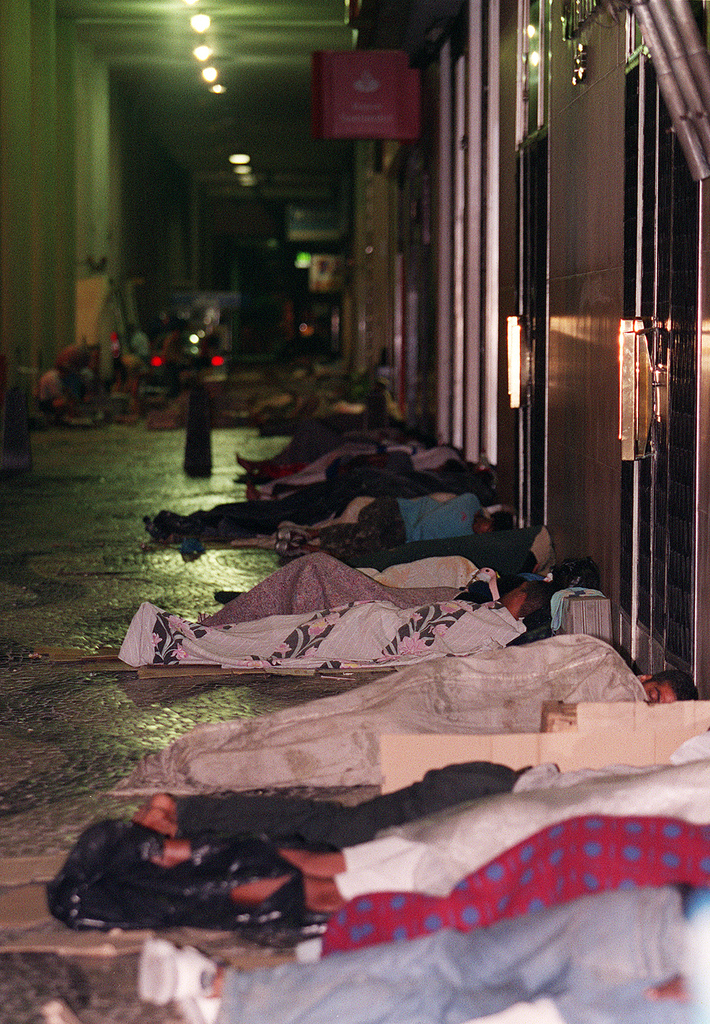 Homeless people in Rio de Janeiro, Brazil Hygiene and sanitary facilities Hostility from the public and laws against urban vagrancy Cleaning and drying of clothes Obtaining, preparing, and storing food Keeping contact with friends, family, and government service providers without a permanent location or mailing address Medical problems, including issues caused by an individual's homeless state (e.g., hypothermia or frostbite from sleeping outside in cold weather), or issues that are exacerbated by homelessness due to lack of access to treatment (e.g., mental health and the individual not having a place to store prescription drugs) Personal security, quiet, and privacy, especially for sleeping, bathing, and other hygiene activities Safekeeping of bedding, clothing, and possessions, which may have to be carried at all times People experiencing homelessness face many problems beyond the lack of a safe and suitable home. They are often faced with reduced access to private and public services and vital necessities:[76] General rejection or discrimination from other people Increased risk of suffering violence and abuse Limited access to education Loss of usual relationships with the mainstream Not being seen as suitable for employment Reduced access to banking services Reduced access to communications technology Reduced access to healthcare and dental services Targeting by municipalities to exclude from public space[77] Implication of hostile architecture[78] Difficulty forming trust with services, systems, and other people; exacerbating pre-existing difficulty accessing aid and escaping homelessness, particularly present in the chronically homeless.[79] Statistics from the past twenty years, in Scotland, demonstrate that the biggest cause of homelessness is varying forms of relationship breakdown. There is sometimes corruption and theft by the employees of a shelter, as evidenced by a 2011 investigative report by FOX 25 TV in Boston, wherein several Boston public shelter employees were found stealing large amounts of from the shelter's kitchen for their private use and catering over time.[80][81] Homeless people are often obliged to adopt various strategies of self-presentation to maintain a sense of dignity, which constrains their interaction with passers-by, and leads to suspicion and stigmatization by the mainstream public.[82] Homelessness is also a risk factor for depression caused by prejudice. When someone is prejudiced against people who are homeless and then becomes homeless themselves, their anti-homelessness prejudice turns inward, causing depression. "Mental disorders, physical disability, homelessness, and having a sexually transmitted infection are all stigmatized statuses someone can gain despite having negative stereotypes about those groups."[83] Difficulties can compound exponentially. A study found that in the city of Hong Kong over half of the homeless people in the city (56%) had some degree of mental illness. Only 13 percent of the 56 percent were receiving treatment for their condition leaving a huge portion of homeless untreated for their mental illness.[84] The issue of anti-homeless architecture came to light in 2014, after a photo displayed hostile features (spikes on the floor) in London, and took social media by storm. The photo of an anti-homeless structure was a classic example of hostile architecture, in an attempt to discourage people from attempting to access or use public space in irregular ways. However, although this has only recently[when?] came to light, hostile architecture has been around for a long time in many places.[85]: 68 An example of this is a low overpass that was put in place between New York City and Long Island. Robert Moses, an urban planner, designed it this way in an attempt to prevent public buses from being able to pass through it.[86] Healthcare 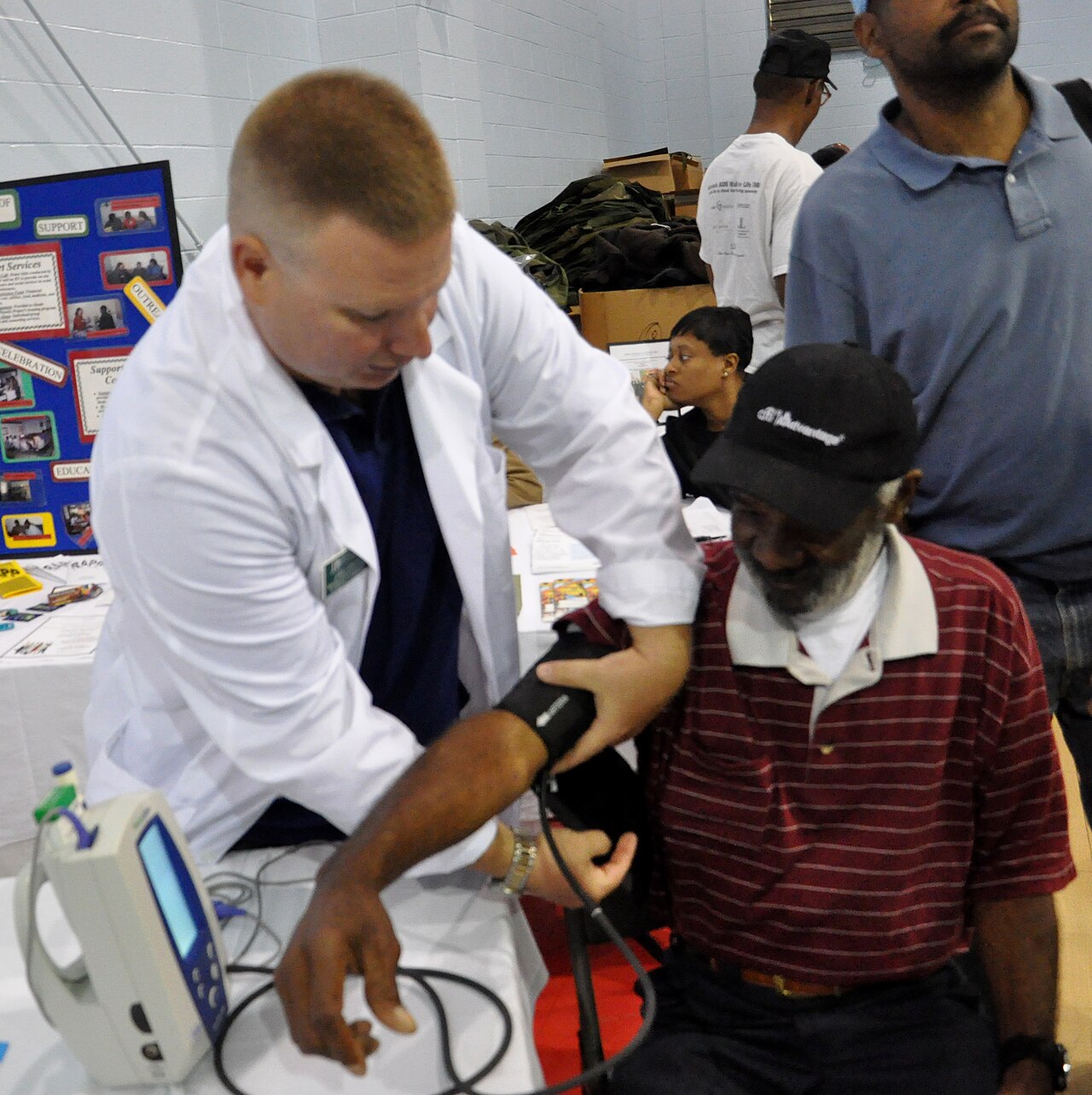 Student nurse at Jacksonville University School of Nursing takes the blood pressure of a homeless veteran during the annual Stand Down for Homelessness activity in Savannah, Georgia. Health care for homeless people is a major public health challenge. When compared to the general population, people who are homeless experience higher rates of adverse physical and mental health outcomes. Chronic disease severity, respiratory conditions, rates of mental health illnesses, and substance use are all often greater in homeless populations than in the general population.[87][88] Homelessness is also associated with a high risk of suicide attempts.[89][90] Homeless people are more likely to suffer injuries and medical problems from their lifestyle on the street, which includes poor nutrition,[91] exposure to the severe elements of weather, and higher exposure to violence. Yet at the same time, they have reduced access to public medical services or clinics,[92] in part because they often lack identification or registration for public healthcare services. There are significant challenges in treating homeless people who have psychiatric disorders because clinical appointments may not be kept, their continuing whereabouts are unknown, their medicines may not be taken as prescribed, medical and psychiatric histories are not accurate, and other reasons. Because many homeless people have mental illnesses, this has presented a care crisis.[67][93][94] The conditions affecting homeless people are somewhat specialized and have opened a new area of medicine tailored to this population. Skin conditions, including scabies, are common, because homeless people are exposed to extreme cold in the winter, and have little access to bathing facilities. They have problems caring for their feet,[95] and have more severe dental problems than the general population.[96] Diabetes, especially untreated, is widespread in the homeless population.[97] Specialized medical textbooks have been written to address this for providers.[98] Due to the demand for free medical services by homeless people, it might take months to get a minimal dental appointment in a free-care clinic. Communicable diseases are of great concern, especially tuberculosis, which spreads more easily in crowded homeless shelters in high-density urban settings.[99] There has been ongoing concern and studies about the health and wellness of the older homeless population, typically ages 50 to 64 and older, as to whether they are significantly more sickly than their younger counterparts, and if they are under-served.[100][101] A 2011 study led by Dr. Rebecca T. Brown in Boston, conducted by the Institute for Aging Research (an affiliate of Harvard Medical School), Beth Israel Deaconess Medical Center, and the Boston Health Care for the Homeless Program found the elderly homeless population had "higher rates of geriatric syndromes, including functional decline, falls, frailty, and depression than seniors in the general population, and that many of these conditions may be easily treated if detected". The report was published in the Journal of Geriatric Internal Medicine.[102] There are government avenues which provide resources for the development of healthcare for homeless people. In the United States, the Bureau of Primary Health Care has a program that provides grants to fund the delivery of healthcare to homeless people.[103] According to 2011 UDS, data community health centers were able to provide service to 1,087,431 homeless individuals.[104] Many nonprofit and religious organizations provide healthcare services to homeless people. These organizations help meet the large need which exists for expanding healthcare for homeless people. There have been significant numbers of unsheltered persons dying of hypothermia, adding impetus to the trend of establishing warming centers, as well as extending enumeration surveys with vulnerability indexes.[105][106] Effect on life expectancy In 1999, Dr. Susan Barrow of the Columbia University Center for Homelessness Prevention Studies reported in a study that the "age-adjusted death rates of homeless men and women were four times those of the general U.S. population and two to three times those of the general population of New York City".[107] A report commissioned by homeless charity Crisis in 2011 found that on average, homeless people in the U.K. have a life expectancy of 47 years, 30 years younger than the rest of the population.[108] Health impacts of extreme weather events See also: Climate change and poverty People experiencing homelessness are at a significantly increased risk of the effects of extreme weather events. Such weather events include extreme heat and cold, floods, storm surges, heavy rain, and droughts. While there are many contributing factors to these events, climate change is driving an increasing frequency and intensity of these events.[109] The homeless population is considerably more vulnerable to these weather events, due to their higher rates of chronic disease, and lower socioeconomic status. Despite having a minimal carbon footprint, homeless people, unfortunately, experience a disproportionate burden of the effects of climate change.[110] Homeless persons have increased vulnerability to extreme weather events for many reasons. They are disadvantaged in most social determinants of health, including lack of housing and access to adequate food and water, reduced access to health care, and difficulty in maintaining health care.[110] They have significantly higher rates of chronic disease including respiratory disease and infections, gastrointestinal disease, musculoskeletal problems, and mental health disease.[111] In fact, self-reported rates of respiratory diseases (including asthma, chronic bronchitis, and emphysema) are double that of the general population.[110] The homeless population often lives in higher-risk urban areas, with increased exposure and little protection from the elements. They also have limited access to clean drinking water and other methods of cooling down.[111] The built environment in urban areas also contributes to the "heat island effect", the phenomenon whereby cities experience higher temperatures due to the predominance of dark, paved surfaces, and lack of vegetation.[112] Homeless populations are often excluded from disaster planning efforts, further increasing their vulnerability when these events occur.[113] Without the means to escape extreme temperatures and seek proper shelter, and cooling or warming resources, homeless people are often left to suffer the brunt of the extreme weather. The health effects that result from extreme weather include exacerbation of chronic diseases and acute illnesses. Pre-existing conditions can be greatly exacerbated by extreme heat and cold, including cardiovascular, respiratory, skin, and renal disease, often resulting in higher morbidity and mortality during extreme weather. Acute conditions such as sunburn, dehydration, heat stroke, and allergic reactions are also common. In addition, a rise in insect bites can lead to vector-borne infections.[111] Mental health conditions can also be impacted by extreme weather events as a result of lack of sleep, increased alcohol consumption, reduced access to resources, and reduced ability to adjust to environmental changes.[111] Pre-existing psychiatric illness has been shown to triple the risk of death from extreme heat.[114] Overall, extreme weather events appear to have a "magnifying effect" in exacerbating the underlying prevalent mental and physical health conditions of homeless populations.[113] Case study: Hurricane Katrina In 2005, Hurricane Katrina, a category-5 hurricane, made landfall in Florida and Louisiana. It particularly affected the city of New Orleans and the surrounding areas. Hurricane Katrina was the deadliest hurricane in the US in seven decades, with more than 1,600 confirmed deaths, and more than 1,000 people missing. The hurricane disproportionately affected marginalized individuals, and individuals with lower socioeconomic status (i.e., 93% of shelter residents were African–American, 32 percent had household incomes below $10,000/year and 54 percent were uninsured).[110] The storm nearly doubled the number of homeless people in New Orleans. While in most cities, homeless people account for one percent of the population, in New Orleans', the homeless account for four percent of the population. In addition to its devastating effects on infrastructure and the economy, the estimated prevalence of mental illness and the incidence of West Nile virus more than doubled after Hurricane Katrina in the hurricane-affected regions.[110] Legal documentation Homeless people may find it difficult to document their date of birth or their address. Because homeless people usually have no place to store possessions, they often lose their belongings, including identification and other documents, or find them destroyed by police or others. Without a photo ID, homeless persons cannot get a job or access many social services, including healthcare. They can be denied access to even the most basic assistance: clothing closets, food pantries, certain public benefits, and in some cases, emergency shelters. Obtaining replacement identification is difficult. Without an address, birth certificates cannot be mailed. Fees may be cost-prohibitive for impoverished persons. And some states will not issue birth certificates unless the person has photo identification, creating a Catch-22.[115] This problem is far less acute in countries that provide free-at-use health care, such as the U.K., where hospitals are open-access day and night and make no charges for treatment. In the U.S., free-care clinics for homeless people and other people do exist in major cities, but often attract more demand than they can meet.[116] Victimization by violent crimes Homeless people are often the victims of violent crime. A 2007 study found that the rate of violent crimes against homeless people in the United States is increasing.[117] A study of women veterans found that homelessness is associated with domestic violence, both directly, as the result of leaving an abusive partner, and indirectly, due to trauma, mental health conditions, and substance abuse.[118] Stigma Conditions such as alcoholism and mental illness are often associated with homelessness.[119] Many people fear homeless people, due to the stigma surrounding the homeless community. Surveys have revealed that before spending time with homeless people, most people fear them, but after spending time with homeless people, that fear is lessened or is no longer there.[120] Another effect of this stigma is isolation.[121] The stigmas of homelessness can thus be divided into three major categories in general: Attributing homelessness to personal incompetency and health conditions (e.g., unemployment, mental health issues, substance abuse, etc.);[122] Seeing homeless people as posing threats to one's safety;[122] De-sanitizing homeless people (i.e., seeing them as pathogens).[123][124] Past research has shown that those types of stigmas are being reinforced through the fact that one is homeless and have a negative impact on effective public policymaking in terms of reducing homelessness.[122][123] When a person lives on a street, many aspects of their personal situations, such as mental health issues and alcoholism, are more likely to be exposed to the public as compared to people who are not homeless and have access to resources that will help improve their personal crises.[122] Such lack of privacy inevitably reinforces stigma by increasing observations of stereotypes for the public. Furthermore, the media often attributes those personal crises to the direct cause of crimes, further leading the public to believe that homeless people are a threat to their safety. Many also believe that contacts with homeless people increase their chance of contracting diseases given that they lack access to stable, sanitary living conditions.[123] Those types of stigmas are intertwined with each other when shaping public opinions on policies related to the homeless population, resulting in many ineffective policies that do not reduce homelessness at all. An example of such ineffective but somewhat popular policies is imposing bans on sleeping on the streets.[123] Relying on the famous contact hypothesis, researchers argue that increasing contact between the homeless population and non-homeless population is likely to change public opinions on this out-group and make the public more well-informed when it comes to policymaking.[125][126] While some believe that the contact hypothesis is only valid on the condition that the context and type of contact are specified, in the case of reducing discrimination against the homelessness population, some survey data indicate that the context (e.g., the proportion of the homeless population in one's city) and type of contact (e.g., TV shows about the homeless population or interpersonal conversations about homelessness) do not produce many variations as they all increase positive attitudes towards homeless people and public policies that aid this group.[122] Given that the restrictions of contexts and types of contact to reduce stigma are minimal, this finding is informative and significant to the government when it comes to making policies to offer institutional support for reducing discrimination in a country and for gauging public opinions on their proposed policies to reduce homelessness.[125][127] |
チャレンジ 主な記事 ホームレス差別 ホームレスの基本的な問題は、個人的なシェルター、暖かさ、安全の必要性である。その他にも以下のような困難がある:  ブラジル、リオデジャネイロのホームレスの人々 衛生設備 一般市民からの敵意と都市部の浮浪を禁止する法律 衣類の洗濯と乾燥 食料の入手、準備、保存 定住地や住所のない友人、家族、行政サービス提供者との連絡の維持 個人のホームレス状態に起因する問題(例:寒い時期に外で寝たことによる低体温症や凍傷)や、治療が受けられないためにホームレス状態によって悪化する問 題(例:精神衛生、処方薬を保管する場所がない)など、医学的問題。 特に睡眠、入浴、その他の衛生活動のための個人的な安全、静けさ、プライバシー 寝具、衣類、所持品の安全な管理(常に携帯しなければならない場合もある ホームレス状態にある人々は、安全で適切な住居がないだけでなく、多くの問題に直面している。彼らはしばしば、民間や公共のサービスや重要な必需品へのア クセスの低下に直面する[76]。 他人からの拒絶や差別 暴力や虐待を受けるリスクの増加 教育へのアクセスが制限される 主流派との通常の関係の喪失 雇用に適していないとみなされる 銀行サービスへのアクセスが制限される 通信技術へのアクセスが減る 医療・歯科サービスへのアクセスの低下 公共空間から排除するための自治体による標的化[77]。 敵対的建築[78]の暗示 サービスやシステム、他の人々との信頼関係の形成が困難で、特に慢性的なホームレスに見られる、援助へのアクセスやホームレス状態からの脱却が以前から困 難であったことを悪化させる[79]。 スコットランドの過去20年間の統計によると、ホームレス状態の最大の原因は、様々な形の人間関係の破綻である。 2011年にボストンのFOX25TVが調査報道した、ボストンの公的シェルターの従業員数名がシェルターの厨房から大量の食料を盗み、長期にわたって私 的利用やケータリングのために使用していたことが発見された事件で証明されているように、シェルターの従業員による汚職や窃盗が行われることもある [80][81]。ホームレスの人々は尊厳の感覚を維持するために様々な自己呈示の戦略を取らざるを得ないことが多く、そのため通行人との交流が制限さ れ、一般の人々から疑惑や汚名を着せられることになる[82]。 ホームレスはまた、偏見によって引き起こされるうつ病の危険因子でもある。ホームレスの人々に対して偏見を持っている人が、自分もホームレスになると、そ の反ホームレス的偏見が内向きになり、うつ病を引き起こす。「精神障害、身体障害、ホームレス、性感染症はすべて、そのようなグループに対する否定的な固 定観念を持っているにもかかわらず、誰かが得ることのできるスティグマ化されたステータスである」[83]。ある調査によると、香港ではホームレスの半数 以上(56%)が何らかの精神疾患を抱えていた。56%のうち治療を受けているのはわずか13%で、ホームレスの大部分は精神疾患の治療を受けていない [84]。 反ホームレス建築の問題は、2014年にロンドンで敵対的な特徴(床にトゲトゲ)が表示された写真をきっかけに明るみになり、ソーシャルメディアを席巻し た。反ホームレス建築の写真は敵対的建築の典型的な例であり、不規則な方法で公共空間にアクセスしたり利用しようとしたりする人々の意欲を削ごうとするも のであった。しかし、このことが明るみに出たのはつい最近だが[85]: 68 敵対的建築物は、ニューヨーク市とロングアイランドの間に設置された低い陸橋がその例である。都市計画家であるロバート・モーゼスは、公共バスが通れない ようにしようと、このように設計した[86]。 ヘルスケア  ジョージア州サバンナで毎年開催される「Stand Down for Homelessness」活動で、ホームレスの退役軍人の血圧を測るジャクソンビル大学看護学部の学生看護師。 ホームレスの人々の健康管理は、公衆衛生上の大きな課題である。一般人口と比較すると、ホームレスの人々は身体的・精神的に不利な結果を経験する割合が高 い。慢性疾患の重症度、呼吸器疾患、精神疾患の罹患率、薬物使用率はすべて、一般集団よりもホームレス集団の方が高いことが多い[87][88]。ホーム レスは自殺未遂のリスクも高い[89][90]。 ホームレスの人々は、栄養状態が悪く[91]、天候の厳しい要素にさらされ、暴力にさらされやすいなど、路上での生活習慣から怪我や医学的問題を抱える可 能性が高い。しかし同時に、公的医療サービスを受けるための身分証明書や登録証がないことが多いこともあり、公的医療サービスや診療所へのアクセスが減少 している[92]。臨床の予約が守られない、居場所がわからない、薬が処方通りに服用されない、病歴や精神科歴が正確でないなどの理由から、精神疾患を抱 えるホームレスの人々の治療には大きな課題がある。多くのホームレスが精神疾患を抱えているため、これはケアの危機を示している[67][93] [94]。 ホームレスの人々が罹患する疾患はやや特殊であり、このような人々に合わせた新たな医療分野が開拓されている。ホームレスの人々は、冬には極寒にさらさ れ、入浴施設をほとんど利用できないため、疥癬を含む皮膚疾患が一般的である。彼らは足のケアに問題があり[95]、一般の人々よりも深刻な歯の問題を抱 えている[96]。糖尿病、特に未治療の糖尿病は、ホームレスの人々に広がっている[97]。医療提供者向けに、これに対処するための専門的な医学教科書 が書かれている[98]。 ホームレスの人々の無料医療サービスに対する需要のため、無料医療クリニックで最低限の歯科診療の予約を取るのに数ヶ月かかることもある。伝染病は大きな 懸念事項であり、特に結核は、高密度の都市環境にある混雑したホームレスシェルターで蔓延しやすい[99]。高齢のホームレス人口(一般的に50歳から 64歳以上)の健康とウェルネスについて、彼らが若年層のホームレス人口よりも著しく病弱であるかどうか、彼らが十分なサービスを受けていないかどうかに ついて、継続的な懸念と研究がなされている[100][101]。 ハーバード大学医学部の関連機関である加齢研究所、ベス・イスラエル・ディーコネス医療センター、ボストン・ヘルスケア・フォー・ザ・ホームレス・プログ ラムが実施した、ボストンのレベッカ・T・ブラウン博士率いる2011年の研究によると、高齢のホームレス集団は、「機能低下、転倒、虚弱、うつ病を含む 老年症候群の割合が一般集団の高齢者よりも高く、これらの症状の多くは、発見されれば容易に治療できる可能性がある」ことがわかった。この報告は Journal of Geriatric Internal Medicine誌に掲載された[102]。 ホームレスのための医療を発展させるための資源を提供する政府の手段もある。2011年のUDSによると、地域保健センターは1,087,431人のホー ムレスの人々にサービスを提供することができた。これらの団体は、ホームレスの人々の医療を拡大するために存在する大きなニーズを満たすのに役立ってい る。 低体温症で死亡するホームレスが相当数いることから、ウォーミングセンターの設置や、脆弱性指標を用いた人口調査の拡大に拍車がかかっている[105] [106]。 平均余命への影響 1999年、コロンビア大学ホームレス予防研究センターのスーザン・バロー博士は、「ホームレスの男女の年齢調整死亡率は、米国の一般人口の4倍、ニュー ヨーク市の一般人口の2~3倍である」という研究報告を行った[107]。2011年にホームレスの慈善団体クライシスが委託した報告書によると、英国の ホームレスの平均寿命は47歳であり、他の人口よりも30歳若い[108]。 異常気象による健康への影響 以下も参照: 気候変動と貧困 ホームレス状態にある人々は、異常気象の影響を受けるリスクが著しく高まる。このような気象現象には、極端な暑さや寒さ、洪水、高潮、豪雨、干ばつなどが ある。これらの現象には多くの要因があるが、気候変動はこれらの現象の頻度と強度を増加させている[109]。ホームレスの人々は慢性疾患の割合が高く、 社会経済的地位が低いため、これらの気象現象に対してかなり脆弱である。二酸化炭素排出量はごくわずかであるにもかかわらず、残念ながらホームレスの人々 は、気候変動の影響による不釣り合いな負担を経験している[110]。 ホームレスの人々は、多くの理由から、異常気象に対する脆弱性を高めている。彼らは、住居の不足、適切な食料と水へのアクセス、医療へのアクセスの低下、 医療維持の困難さなど、健康の社会的決定要因のほとんどにおいて不利な立場に置かれている[110]。呼吸器疾患や感染症、消化器疾患、筋骨格系の問題、 精神疾患を含む慢性疾患の罹患率が著しく高い[111]。実際、自己申告による呼吸器疾患(喘息、慢性気管支炎、肺気腫を含む)の罹患率は、一般人口の2 倍である[110]。 ホームレスの人々は、より危険度の高い都市部に住んでいることが多く、風雨にさらされる機会が多く、風雨から身を守る手段もほとんどない。また、清潔な飲 料水やその他の涼をとる手段へのアクセスも限られている[111]。都市部の建築環境も「ヒートアイランド現象」の一因となっており、暗い舗装された路面 が多く、植生が少ないために都市の気温が高くなる現象である[112]。 ホームレスの人々は、災害計画の取り組みから排除されることが多く、災害発生時の脆弱性をさらに高めている[113]。極端な気温から逃れて適切な避難所 を探したり、冷房や暖房の資源を求めたりする手段を持たないホームレスの人々は、異常気象の矢面に立たされることが多い。 異常気象がもたらす健康への影響には、慢性疾患や急性疾患の悪化がある。心血管疾患、呼吸器疾患、皮膚疾患、腎疾患など、既往症は極端な暑さや寒さによっ て大幅に悪化する可能性があり、異常気象時の罹患率や死亡率が高くなることが多い。日焼け、脱水、熱中症、アレルギー反応などの急性症状もよく見られる。 さらに、虫刺されの増加は、媒介感染症につながる可能性がある[111]。 睡眠不足、アルコール摂取の増加、資源へのアクセスの減少、環境変化への適応能力の低下[111]などの結果、メンタルヘルス状態も異常気象の影響を受け る可能性がある。 既存の精神疾患は、猛暑による死亡リスクを3倍に高めることが示されている[114]。 全体として、異常気象は、ホームレス集団の根底に蔓延している精神的・身体的健康状態を悪化させる「拡大効果」を持つようである[113]。 事例研究 ハリケーン・カトリーナ 2005年、カテゴリー5のハリケーン・カトリーナがフロリダ州とルイジアナ州に上陸した。特にニューオリンズ市とその周辺地域に影響を与えた。ハリケー ン・カトリーナは、米国で過去70年間で最も大きな被害をもたらしたハリケーンであり、死者1,600人以上、行方不明者1,000人以上が確認されてい る。このハリケーンは、社会経済的に疎外された人々や、社会経済的地位の低い人々に不釣り合いな影響を与えた(すなわち、避難所の住民の93%はアフリカ 系アメリカ人であり、32%は世帯収入が年間1万ドル未満であり、54%は無保険であった)[110]。 嵐によって、ニューオーリンズのホームレスの数はほぼ倍増した。ほとんどの都市では、ホームレスは人口の1パーセントを占めるが、ニューオーリンズでは、 ホームレスは人口の4パーセントを占める。インフラと経済への壊滅的な影響に加え、ハリケーン・カトリーナの後、ハリケーン被災地では精神疾患の推定有病 率と西ナイル・ウイルスの発生率が2倍以上になった[110]。 法的文書 ホームレスの人々は、生年月日や住所を記録することが困難な場合がある。ホームレスの人々は通常、所持品を保管する場所がないため、身分証明書やその他の 書類を含む所持品を紛失したり、警察などによって破棄されたりすることが多い。写真付き身分証明書がなければ、ホームレスの人々は仕事に就くことも、医療 を含む多くの社会サービスを利用することもできない。衣料品店、食料配給所、特定の公的給付金、場合によっては緊急シェルターなど、最も基本的な支援への アクセスさえ拒否されることもある。身分証明書の再発行は難しい。住所がないと出生証明書を郵送できない。貧しい人々にとっては、手数料が費用の負担にな ることもある。また、州によっては、写真付きの身分証明書がなければ出生証明書を発行しないところもあり、このようなキャッチ・ツー・カップが生じる [115]。この問題は、昼夜を問わず病院が開放され、治療費が無料である英国のような、自由診療の医療を提供する国でははるかに深刻ではない。アメリカ では、ホームレスやその他の人々のための無料診療所が大都市に存在するが、しばしば対応しきれないほどの需要を集めている[116]。 暴力犯罪による被害 ホームレスの人々はしばしば暴力犯罪の被害者となる。2007年の調査では、アメリカではホームレスに対する暴力犯罪の割合が増加していることがわかった [117]。退役軍人の女性を対象とした調査では、ホームレス状態が、虐待するパートナーとの別れという直接的な理由と、トラウマ、精神状態、薬物乱用に よる間接的な理由の両方において、家庭内暴力と関連していることがわかった[118]。 スティグマ アルコール依存症や精神疾患などの疾患は、しばしばホームレス状態と関連している[119]。ホームレス社会を取り巻くスティグマにより、多くの人々が ホームレスの人々を恐れている。調査によると、ホームレスの人々と過ごす前は、ほとんどの人が彼らを恐れているが、ホームレスの人々と過ごした後は、その 恐怖は軽減されるか、もはや存在しなくなる[120]。このスティグマのもう一つの影響は孤立である[121]。 このようにホームレスのスティグマは、一般的に3つの大きなカテゴリーに分けることができる: ホームレスの原因を個人の無能や健康状態(失業、精神衛生上の問題、薬物乱用など)とすること[122]。 ホームレスの人々を自分の安全を脅かす存在とみなすこと[122]。 ホームレスの人々を除菌すること(すなわち、 過去の研究によって、ホームレスであるという事実を通じて、このようなスティグマが強化され、ホームレスの減少という点で、効果的な公共政策の立案に悪影 響を及ぼすことが示されている[123][124]。 [122][123]路上で生活している場合、精神衛生上の問題やアルコール依存症など、個人的な状況の多くの側面が、ホームレスでなく、個人的な危機を 改善するための資源を利用できる人と比べて、公衆にさらされる可能性が高い[122]。このようなプライバシーの欠如は、公衆に対するステレオタイプの観 察を増加させることによって、スティグマを必然的に強化する。さらに、メディアはしばしばそのような個人的危機を犯罪の直接の原因とし、ホームレスの人々 が自分たちの安全を脅かす存在であると一般大衆をさらに信じ込ませる。また、ホームレスが安定した衛生的な生活環境にアクセスできないことから、ホームレ スと接触することで病気に感染する可能性が高まると考える人も多い[123]。ホームレス人口に関連する政策に対する世論を形成する際、このような種類の スティグマは互いに絡み合い、その結果、ホームレスの数をまったく減らせない、効果のない政策が多く生み出される。そのような効果のない、しかしある程度 人気のある政策の例として、路上での寝泊まりを禁止することが挙げられる[123]。 有名な接触仮説に依拠して、研究者たちは、ホームレス集団と非ホームレス集団との接触を増やすことは、この非集団に対する世論を変化させ、政策立案に関し て世論をよりよく理解させる可能性が高いと主張している[125][126]。接触仮説は、文脈と接触の種類が特定されている場合にのみ有効であるという 考え方もあるが、ホームレス集団に対する差別の削減の場合、いくつかの調査データによれば、文脈(例.ホームレス人口に対する差別を減らす場合、いくつか の調査データによると、文脈(例えば、自分の住む都市におけるホームレス人口の割合)と接触のタイプ(例えば スティグマを減少させるための文脈や接触のタイプの制限が最小限であることを考えると、この発見は、政府にとって、その国における差別を減少させるための 制度的支援を提供するための政策を立てるときや、ホームレス状態を減少させるために提案された政策に対する国民の意見を測定するときに有益であり、重要で ある[125][127]。 |
| Homelessness by country Further information: List of countries by homeless population Africa Egypt Main article: Homelessness in Egypt Homelessness in Egypt is a significant social issue affecting some 12 million people in the country. Egypt has over 1,200 areas designated for irregular dwellings that do not conform to standard building laws, allowing homeless people to build shacks and other shelters for themselves.[128] Reportedly, in Egypt, homelessness is defined to include those living in marginal housing.[129] Some scholars have stated that there is no agreed-upon definition of homelessness in Egypt due to the difficulties government would face if an official definition were accepted.[130] According to UNICEF, there are one million children living on the streets in Egypt.[131] Other researchers estimate the number to be some three million.[132] Homelessness NGOs assisting street children include those such as Hope Village Society,[131] and NAFAS.[129] Other NGOs, such as Plan International Egypt, work to reintegrate street children back into their families.[133] South Africa Main article: Homelessness in South Africa Homelessness in South Africa dates back to the apartheid period.[134] Increasing unemployment, lack of affordable housing, social disintegration, and social and economic policies have all been identified as contributing factors to the issue.[135] Some scholars argue that solutions to homelessness in South Africa lie more within the private sphere than in the legal and political spheres.[136] There is no national census on homeless people in South Africa, researchers instead rely on individual studies of homeless persons in particular cities.[137] The South African homeless population has been estimated at 200,000 people from a diverse range of backgrounds.[138] One study found that three out of four South African metropolitan municipalities viewed homelessness primarily as a social dependency issue, responding with social interventions. At the same time, homeless South Africans indicated that the most important thing the municipality could assist them with was employment and well-located affordable housing.[139] 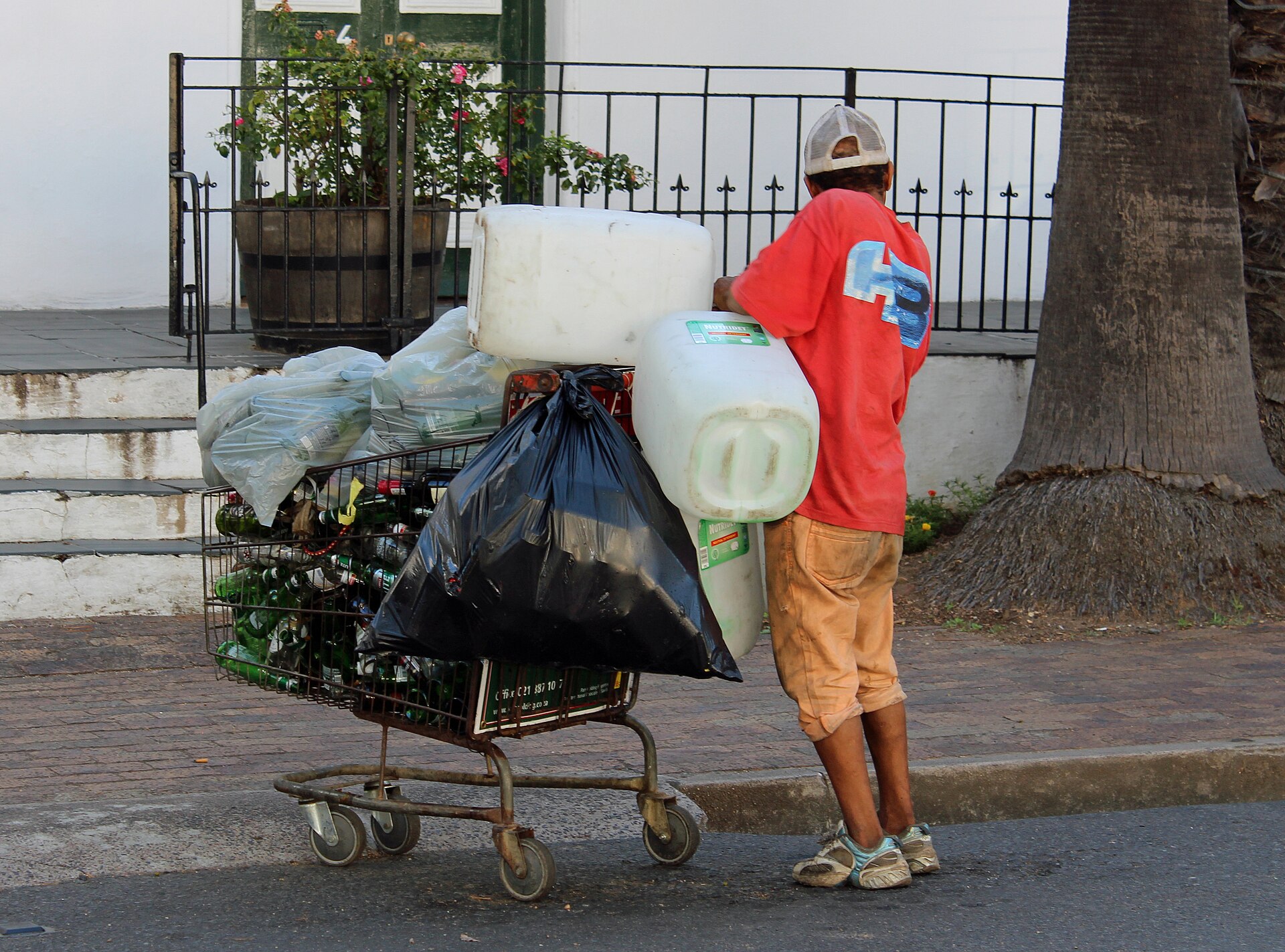 A homeless person collecting recyclable materials in Stellenbosch, South Africa Asia China Main article: Homelessness in China In 2011, there were approximately 2.41 million homeless adults and 179,000 homeless children living in the country.[140] However, one publication estimated that there were one million homeless children in China in 2012.[141] Housing in China is highly regulated by the Hukou system. This gives rise to a large number of migrant workers, numbering 290.77 million in 2019.[142] These migrant workers have rural Hukou, but they move to the cities in order to find better jobs, though due to their rural Hukou they are entitled to fewer privileges than those with urban Hukou.[citation needed] According to Huili et al.,[143] these migrant workers "live in overcrowded and unsanitary conditions" and are always at risk of displacement to make way for new real estate developments. In 2017, the government responded to a deadly fire in a crowded building in Beijing by cracking down on dense illegal shared accommodations and evicting the residents, leaving many migrant laborers homeless.[144] This comes in the context of larger attempts by the government to limit the population increase in Beijing, often targeting migrant laborers.[145] However, according to official government statistics,[142] migrant workers in China have an average of 20.4 square metres (220 square feet) of living space per capita, and the vast majority of migrant workers have basic living facilities such as heating, bathing, refrigerators, and washing machines. Several natural disasters have led to homelessness in China. The 2000 Yunnan earthquake left 92,479 homeless and destroyed over 41,000 homes.[146] Homelessness among people with mental health problems is 'much less common' in China than in high-income countries, due to stronger family ties, but is increasing due to migration within families and as a result of the one-child policy. A study in Xiangtan found at least 2439 schizophrenic people that have been homeless on a total population of 2.8 million. It was found that "homelessness was more common in individuals from rural communities (where social support services are limited), among those who wander away from their communities (i.e., those not from Xiangtan municipality), and among those with limited education (who are less able to mobilize social supports). Homelessness was also associated with greater age; [the cause] may be that older patients have 'burned their bridges' with relatives and, thus, end up on the streets."[147] During the Cultural Revolution a large part of child welfare homes were closed down, leaving their inhabitants homeless. By the late 1990s, many new homes were set up to accommodate abandoned children. In 1999, the Ministry of Civil Affairs estimated the number of abandoned children in welfare homes to be 66,000.[148] According to the Ministry of Civil Affairs, China had approximately 2,000 shelters and 20,000 social workers to aid approximately three million homeless people in 2014.[149] From 2017 to 2019, the government of Guangdong Province assisted 5,388 homeless people in reuniting with relatives elsewhere in China. The Guangdong government assisted more than 150,000 people over three years.[150] In 2020, in the wake of the COVID-19 pandemic, the Chinese Ministry of Civil Affairs announced several actions of the Central Committee in response to homelessness, including increasing support services and reuniting homeless people with their families.[151] In Wuhan, the situation for homeless people was particularly bad, as the lockdown made it impossible for homeless migrants to return to other parts of the country. The Wuhan Civil Affairs Bureau set up 69 shelters in the city to house 4,843 people.[152] India Main article: Homelessness in India The Universal Declaration of Human Rights defines 'homeless' as those who do not live in a regular residence due to lack of adequate housing, safety, and availability.[153] The United Nations Economic and Social Council Statement has a broader definition for homelessness; it defines homelessness as follows: 'When we are talking about housing, we are not just talking about four walls and a roof. The right to adequate housing is about the security of tenure, affordability, access to services, and cultural adequacy. It is about protection from forced eviction and displacement, fighting homelessness, poverty, and exclusion.[154] India defines 'homeless' as people who do not live in census houses, but rather stay on pavements, roadsides, railway platforms, staircases, temples, streets, in pipes, or other open spaces.[153] There are 1.77 million homeless people in India, or 0.15 percent of the country's total population, according to the 2011 census consisting of single men, women, mothers, the elderly, and the disabled.[153][155] However, it is argued that the numbers are far greater than accounted by the point in time method. For example, while the Census of 2011 counted 46.724 homeless individuals in Delhi, the Indo-Global Social Service Society counted them to be 88,410, and another organization called the Delhi Development Authority counted them to be 150,000.[154] Furthermore, there is a high proportion of mentally ill and street children in the homeless population.[156] There are 18 million street children in India, the largest number of any country in the world, with 11 million being urban.[157][158] Finally, more than three million men and women are homeless in India's capital city of New Delhi; the same population in Canada would make up approximately 30 electoral districts.[159] A family of four members has an average of five homeless generations in India.[153] There is a shortage of 18.78 million houses in the country. The total number of houses has increased from 52.06 million to 78.48 million (as per the 2011 census). However, the country still ranks as the 124th wealthiest country in the world as of 2003.[160] More than 90 million people in India make less than US$1 per day, thus setting them below the global poverty threshold.[160] The ability of the Government of India to tackle urban homelessness and poverty may be affected in the future by both external and internal factors.[160] The number of people living in slums in India has more than doubled in the past two decades and now exceeds the entire population of Britain, the Indian Government has announced.[161] About 78 million people in India live in slums and tenements.[162] Seventeen percent of the world's slum dwellers reside in India.[160] After the release of the feature film Slumdog Millionaire in 2008, Mumbai was a slum tourist destination for slumming where homeless people and slum dwellers alike could be openly viewed by tourists.[163] Indonesia Main article: Homelessness in Indonesia Homelessness in Indonesia refers to the issue of homelessness, a condition wherein people lack a stable and appropriate place of housing. The number of homeless people in Indonesia is estimated to be up to three million people in the country, with over 28,000 in Jakarta alone.[164][165] Several terms are used to describe homeless people in Indonesia, including tunawisma, which is used by the government, and gelandangan, meaning "tramp".[166][167] Squatters and street homeless people are often targeted by police raids who say that homeless people "disturb the attractiveness of the city".[165] One cause of homelessness in Indonesia is forced evictions. According to researchers, between the years 2000 and 2005 over 92,000 people were forcefully evicted from their homes.[168] Iran According to Governor of Isfahan homeless people are an issue, per revised Article 16 of drug combat law the offenders will be forced detained for three to 6 months by either IRGC or privately outsourced.[169][170] The daily cost of a person kept is 28000 toman (50 cent).[171][172] At best five percent return to normal life.[172] They may receive vocational training.[173] Women are kept separate.[174] Iran has a housing crisis with people who sleep in graves called Grave dwellers, buses for 25000 toman per night, rooftops or multiple families renting and sharing one single apartment.[175][176][177][178][179][180][181][182][183] Many renters may want to rent living space in shipping containers too.[184][185] Israel Main article: Homelessness in Israel Homelessness in Israel is a phenomenon that mostly developed after the mid-1980s.[186] Homelessness increased following the wave of Soviet immigration in 1991. As many as 70 percent of homeless people in Tel Aviv are immigrants from the former Soviet Union, nearly all of them men. According to homeless shelter founder Gilad Harish, "when the recession hit Israel in the early 1990s, the principle of 'last in, first out' kicked in, and many Russian immigrants lost their jobs. Being new to the country, they didn't have a strong family support system to fall back on like other Israelis do. Some ended up on the street with nowhere to go."[187] The number of homeless people in Israel grew in the 2000s, and the Association for Civil Rights in Israel claimed that the authorities were ignoring the issue.[188] Some 2,000 families in Israel lose their homes every year after defaulting on their mortgage loans. However, a law amendment passed in 2009 protects the rights of mortgage debtors and ensures that they are not evicted after failing to meet mortgage payments. The amendment is part of a wider reform in the law in the wake of a lengthy battle by the Association for Civil Rights in Israel and other human rights groups.[189] In 2007, the number of homeless youth was on the rise. More than 25 percent of all homeless youth in 2007 were girls, compared to 15 percent in 2004. A report by Elem, a non-profit organization that helps youth at risk, pointed to a five percent rise in the number of youths either homeless or wandering the streets late at night while their parents worked or due to strained relations at home. The organization estimated that in 2007 it provided programs or temporary shelter to roughly 32,000 youths in some 30 locations countrywide.[190] In 2014, the number of homeless individuals in Israel was estimated at 1,831, about 600 of whom were living on the streets of Tel Aviv.[191] This makes up 0.02 percent of the country's population, a low figure compared to other developed nations. In July 2015, the Welfare Ministry estimated the number of homeless people to be between 800 and 900, including 450 receiving services and treatment from their municipalities but continuing to live on the streets. Elem claimed the true figure was much higher. In December 2015, a large study by the Welfare Ministry found that 2,300 people in Israel were homeless.[192][193] Homeless people in Israel are entitled to a monthly government stipend of NIS 1,000.[192] In addition, there are both state-run homeless shelters operated by the Welfare Ministry and privately run shelters. Adi Nes, an Israeli photographer, has brought public attention to the issue by taking pictures of Israel's homeless.[194] Japan Main article: Homelessness in Japan Homelessness in Japan (ホームレス, 浮浪者)) is a social issue primarily affecting middle-aged and elderly males. Homelessness is thought to have peaked in the 1990s as a consequence of the collapse of the Japanese asset price bubble and has largely fallen since then. According to the "Special Act in regards to Supporting the Autonomy of the Homeless Population" (Japanese: ホームレスの自立の支援等に関する特別措置法)), the term "homeless" is defined as "those [people] who utilize city parks, river banks, roads, train stations, and other facilities as their place of stay to live their daily lives".[195] Nicknames for homeless people in Japan include hōmuresu (ホームレス, from the English "homeless"), furousha (浮浪者, meaning "wandering person"), kojiki (乞食, meaning beggar), and runpen (ルンペン, from German "Lumpen"). More recently[when?], nojukusha (野宿者, "person who sleeps outside") and nojuku roudousha (野宿労働者, "laborer who sleeps outside") have been used to avoid negative connotations associated with the word "homeless".[196] Philippines See also: Street children in the Philippines and Squatting in the Philippines There are approximately 4.5 million homeless people in the Philippines, about three million of those are in Manila.[197] Europe At least 895,000 people are estimated to be homeless on any one night, according to the European Federation of National Organisations working with the Homeless (FEANTSA) in research published in September 2023. This was based on the most recent national statistics in 23 European countries, recording 533,054 people as homeless, and applying the average percentage of homeless people in those countries (0.174%) to Europe's total estimated population in 2022 (513 million).[198] Switzerland Main article: Homelessness in Switzerland Homelessness in Switzerland is a known social issue, however, there are few estimates as to the number of Swiss people affected.[199] Homelessness is less visible in Switzerland than in many other Western countries. The majority of homeless people in Geneva are Swiss or French, with a minority from other countries.[200] One Swiss study found that 1.6 percent of all patients admitted to psychiatric wards were homeless. The study reported that social factors and psychopathology are independently contributing to the risk of homelessness.[201] In 2014, Swiss authorities reportedly began allowing homeless people to sleep in fallout shelters built during the Cold War.[200] There are many centers for providing food for homeless people, including the Suneboge community center.[202] United Kingdom Main articles: Homelessness in the United Kingdom, Homelessness in England, and Homelessness in Scotland Homelessness across the U.K. is a devolved matter, resulting in different legislation, frameworks, and even definitions, from country to country. 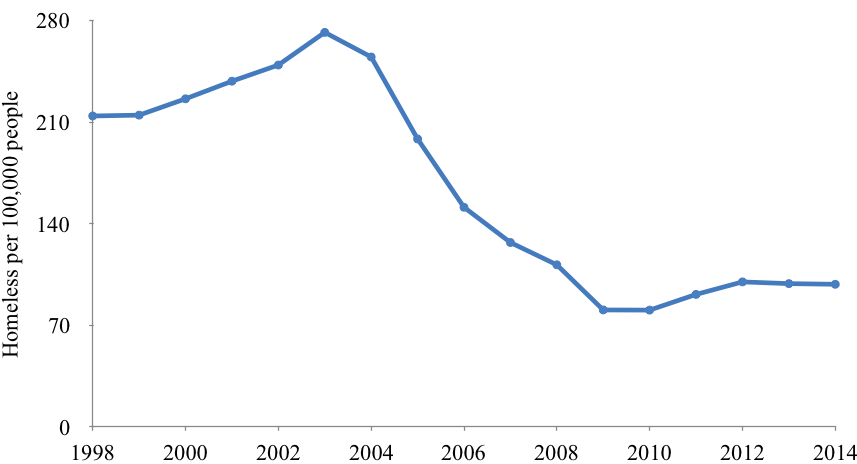 Number of homeless in England per 100,000 people, 1998–2014 Since the late 1990s, housing policy has been a devolved matter, and state support for homeless people, together with legal rights in housing, have therefore diverged to a certain degree. A national service, called Streetlink, was established in 2012 to help members of the public obtain near-immediate assistance for specific rough sleepers, with the support of the Government (as housing is a devolved matter, the service currently only extends to England). The annual number of homeless households in England peaked in 2003–04 at 135,420 before falling to a low of 40,020 in 2009–10.[203] In 2017–18, there were 56,600 homeless households, which was 60 percent below the 2003–04 peak, and 40 percent higher than the 2009–10 low.[204] The UK has more than 120,000 children in temporary accommodation, a number which has increased from 69,050 children in 2010.[205][206] In 2007 the official figures for England were that an average of 498 people slept rough each night, with 248 of those in London.[207] Homelessness in England since 2010 has been rising. By 2016 it is estimated the number sleeping rough had more than doubled since 2010.[208] The National Audit Office said about homelessness in England 2010–17 there has been a 60 percent rise in households living in temporary accommodation and a rise of 134 percent in rough sleepers.[209][210] It is estimated 4,751 people bedded down outside overnight in England in 2017, up 15 percent over the previous year.[211] The housing charity Shelter used data from four sets of official 2016 statistics and calculated 254,514 people in England were homeless.[212] The Homelessness Reduction Bill 2016–17 places a new duty on local authorities in England to assist people threatened with homelessness within 56 days and to assess, prevent and relieve homelessness for all eligible applicants including single homeless people from April 2018.[213] Before the 2017 HRA, homeless households were defined and measured as those who were owed a 'main homelessness duty' by local authorities. But since 2018, the definition of homeless households has broadened as households are owed a new relief duty and a prevention duty. The main homelessness duty definition has not been changed by the 2017 HRA. However, these households are now only owed a main duty if their homelessness has not been successfully prevented or relieved.[214] In 2019–20, 288,470 households were owed the new prevention or relief duties, which is four times the number of households owed the 'main duty' in 2017–18 before implementation of the Homelessness Reduction Act.[204] Research into Women's Homelessness in London has found that the situations people face may vary based on their background and/or experience. This is known as multiple disadvantage. The 'Making Women Count' Report Archived 13 April 2023 at the Wayback Machine, released in March 2023 found over 154 women sleeping rough in just one week. This project was made in collaboration with SHP, St Mungo's, the Women's Development Unit (Solace Women's Aid and The Connection at St Martin's London Councils and the GLA alongside researchers from PraxisCollab. The picture in Scotland is considerably different, with laws that entitle everyone to a roof over their head if they are homeless.[215] This accommodation is often in the form of somewhere temporary until something permanent becomes available. Though across the course of 2022, this will change, reducing the use of temporary accommodation, in line with the Homeless and Rough Sleeping Action Group (HARSAG) recommendations.[216] Currently people are spending an average of 199 days (April 2020 to March 2021) in temporary accommodation before being housed in somewhere permanent.[217] Most recently updated in October 2020, Scotland is working to eradicate homelessness through the 'Ending Homelessness Together' action plan.[218] It is anticipated that with this, alongside a focus on prevention, and Local Authorities working with the third sector on plans known as Rapid Rehousing Transition Plans, that people will no longer be homeless for any length of time. In terms of figures, in 2020–21, there were 42,149 people in homeless households – 30,345 adults and 11,804 children in Scotland.[219] This was a drop of nine percent from the previous year, though it is unclear if this was partly due to statistics being collected differently during the start of the pandemic. North America Canada This section is an excerpt from Homelessness in Canada.[edit] 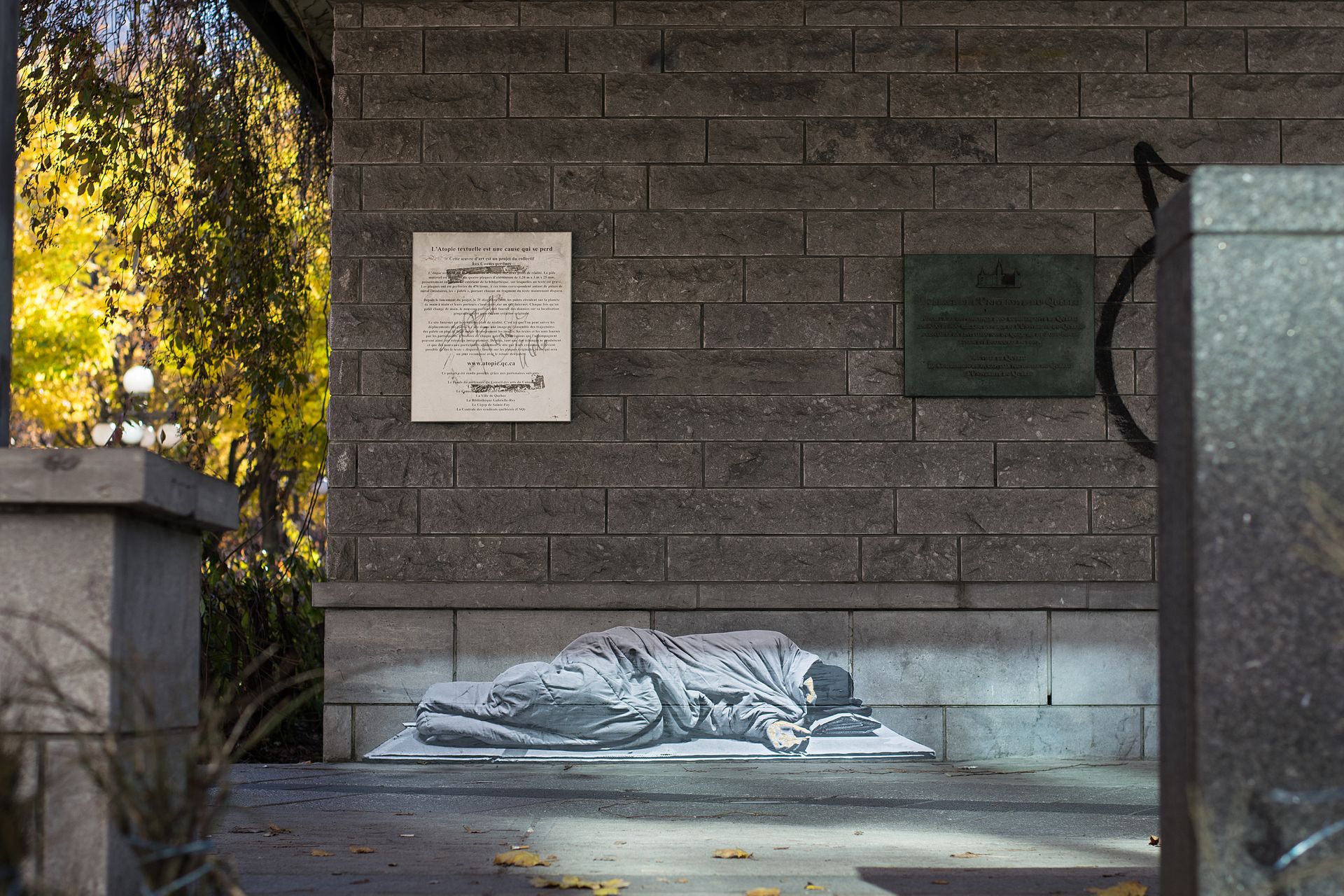 Graffiti of homeless in Quebec City Homelessness in Canada was not a social problem until the 1980s.[220] The Canadian government housing policies and programs in place throughout the 1970s were based on a concept of shelter as a basic need or requirement for survival and of the obligation of government and society to provide adequate housing for everyone.[220][221] Public policies shifted away from rehousing in the 1980s in wealthy Western countries like Canada, which led to a de-housing of households that had previously been housed. By 1987, when the United Nations established the International Year of Shelter for the Homeless (IYSH), homelessness had become a serious social problem in Canada. The report of the major 1987 IYSH conference held in Ottawa said that housing was not a high priority for government, and this was a significant contributor to the homelessness problem. While there was a demand for adequate and affordable housing for low income Canadian families, government funding was not available. In the 1980s a "wider segment of the population" began to experience homelessness for the first time – evident through their use of emergency shelters and soup kitchens. Shelters began to experience overcrowding, and demand for services for the homeless was constantly increasing. A series of cuts were made to national housing programs by the federal government through the mid-1980s and in the 1990s. While Canada's economy was robust, the cuts continued and in some cases accelerated in the 1990s, including cuts to the 1973 national affordable housing program. The government solution for homelessness was to create more homeless shelters and to increase emergency services. In the larger metropolitan areas like Toronto the use of homeless shelters increased by 75% from 1988 to 1998. Urban centres such as Montreal, Laval, Vancouver, Edmonton, and Calgary all experienced increasing homelessness.[222] In Action Plan 2011, the Federal Government of Canada proposed $120 million annually from April 2014 until April 2019—with $70 million in new funding—to renew its Homelessness Partnering Strategy (HPS) with a focus on the Housing First model. Private or public organizations across Canada were eligible for HPS subsidies to implement Housing First programs. United States Main article: Homelessness in the United States See also: Homeless women in the United States, List of tent cities in the United States, and Affordable housing in the U.S. 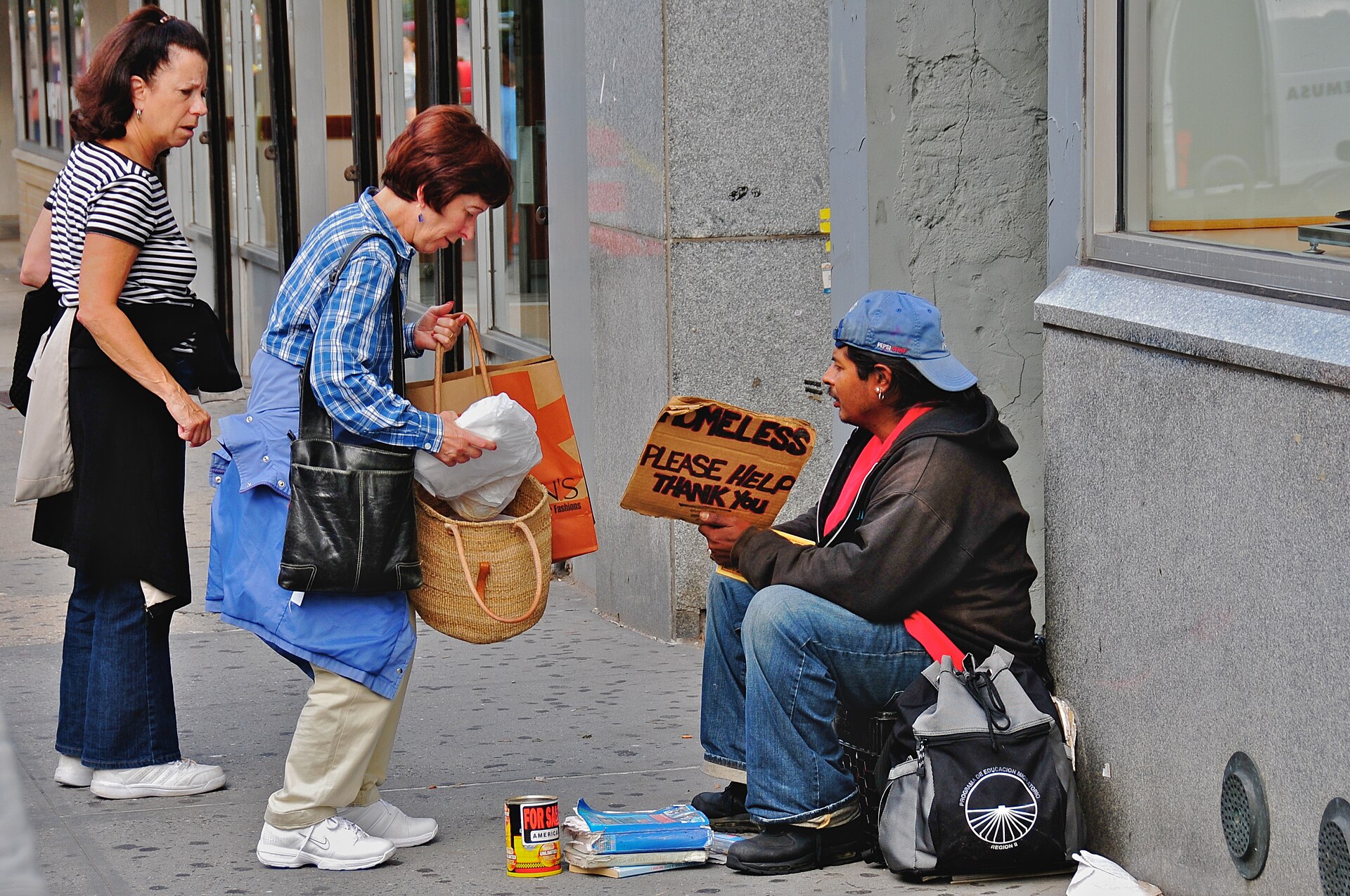 A woman giving a homeless man food in New York City, United States (2008) After Franklin D. Roosevelt took over the presidency from Herbert Hoover in 1933, he oversaw the passage of the New Deal, which greatly expanded social welfare, including providing funds to build public housing. This marked the end of the Great Depression.[26] However, the number of homeless people grew in the 1980s, when Ronald Reagan decimated the public housing budget in the 1980s, including the federally funded affordable housing production put in place by the New Deal.[223] By the mid-1980s, there was a dramatic increase in family homelessness. Tied into this was an increasing number of impoverished and runaway children, teenagers, and young adults, which created a new substratum of the homeless population (street children or street youth).[224] In 2015, the United States reported that there were 564,708 homeless people within its borders, one of the higher reported figures worldwide.[225] Housing First is an initiative to help homeless people reintegrate into society, and out of homeless shelters. It was initiated by the federal government's Interagency Council on Homelessness. It asks cities to come up with a plan to end chronic homelessness. In this direction, there is the belief that if homeless people are given independent housing to start, with some proper social support, then there would be no need for emergency homeless shelters, which it considers a good outcome. However, this is a controversial position.[226][227][228] There is evidence that the Housing First program works more efficiently than Treatment First programs. Studies show that having the stability of housing through the Housing First program will encourage homeless people to focus on other struggles they are facing, such as substance abuse. Meanwhile, Treatment First programs promote an "all or nothing" approach which requires clients to participate in programs applicable to their struggles as a condition for housing assistance. Treatment First utilizes a less individualistic approach than Housing First and solutions are created under one standard rather than fit each client's specific needs.[228] 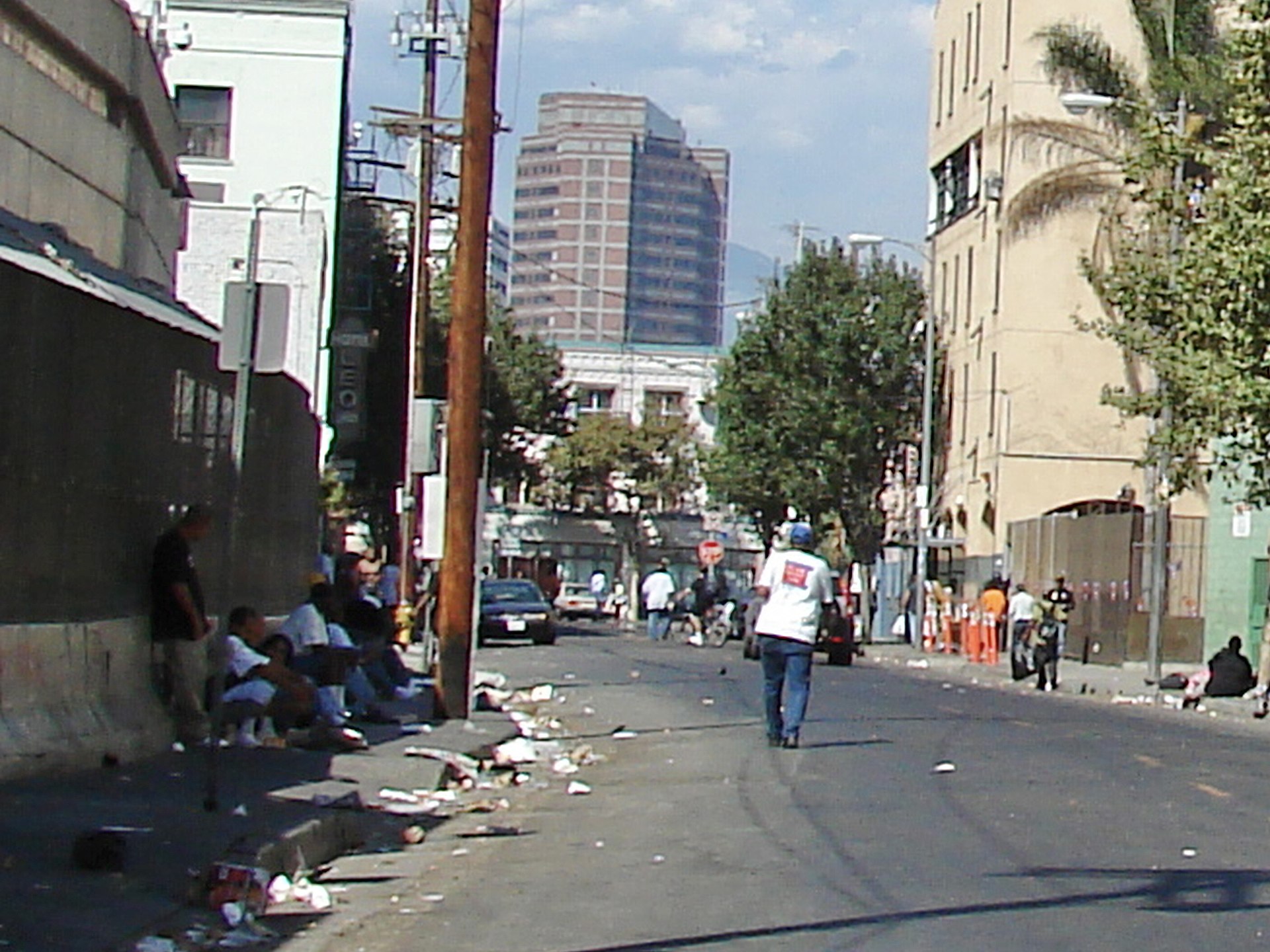 Skid Row, Los Angeles contains one of the largest stable populations, between 5,000 and 8,000, of homeless people in the United States.[229] In 2009 it was estimated that one out of 50 children or 1.5 million children in the United States would experience some form of homelessness each year.[230] In 2010 in New York City, where there were over 36,000 homeless people in 2009,[231] there was a mobile video exhibit in the streets showing a homeless person on a screen and asking onlookers and passersby to text with their cellphones a message for him, and they also could donate money by cellphones to the organization Pathways to Housing.[232][233] In September 2010, it was reported that the Housing First Initiative had significantly reduced the chronic homeless single person population in Boston, Massachusetts, although homeless families were still increasing in number. Some shelters were reducing the number of beds due to lowered numbers of homeless, and some emergency shelter facilities were closing, especially the emergency Boston Night Center.[234] In 2011, the Department of Veterans Affairs Supportive Services for Veterans Families Initiative, SSVF, began funding private non-profit organizations and consumer cooperatives to provide supportive services to very low-income veteran families living in or transitioning to permanent housing.[235] In 2019, in an interview with CBS News, scholar Sara Goldrick-Rab said that her study on college student homelessness found that "[n]early one in ten college students said they were homeless in the last year, meaning they had at least one night where they did not know where they were going to sleep."[236] Puerto Rico According to the count by the Puerto Rico Department of Family, in January 2017 there were 3,501 homeless persons in the territory. The study shows that 26 percent of this population lives in the capital, San Juan. Other municipality's percentage of this population was Ponce at 6.3 percent, Arecibo at six percent, Caguas at 5.3 percent, and Mayagüez at 4.7 percent. Results from the study determined that 76 percent of the homeless population were men and 24 percent were women and that both men and women populations, were on average age, 40 years old. This steadily increasing population might have increased more drastically as a result of Hurricane María which caused over 90 billion dollars in damage to the island of Puerto Rico.[237] Data provided by the Department of Community Social Development of San Juan indicates that in 1988 the number of homeless people in the municipality was 368, while in 2017 there were about 877 persons without a home. While the average age for the overall homeless population is 40 years old for both women and men, in San Juan the median is 48 years for men and 43 years for women. Other data obtained showed that more than 50 percent have university-level education. Also, it revealed that 35 percent of men and 25 percent of women have relapsed more than four times after unsuccessful attempts to reinsert themselves socially. Reasons given for wandering are varied with the most common causes being drug abuse (30.6%), family problems (22.4%), financial or economic problems (15.0%), and others such as unemployment, mental health problems, domestic violence, evictions, or lack of support when released from prison.[238] Oceania Australia Main article: Homelessness in Australia This section needs to be updated. Please help update this article to reflect recent events or newly available information. (May 2023) 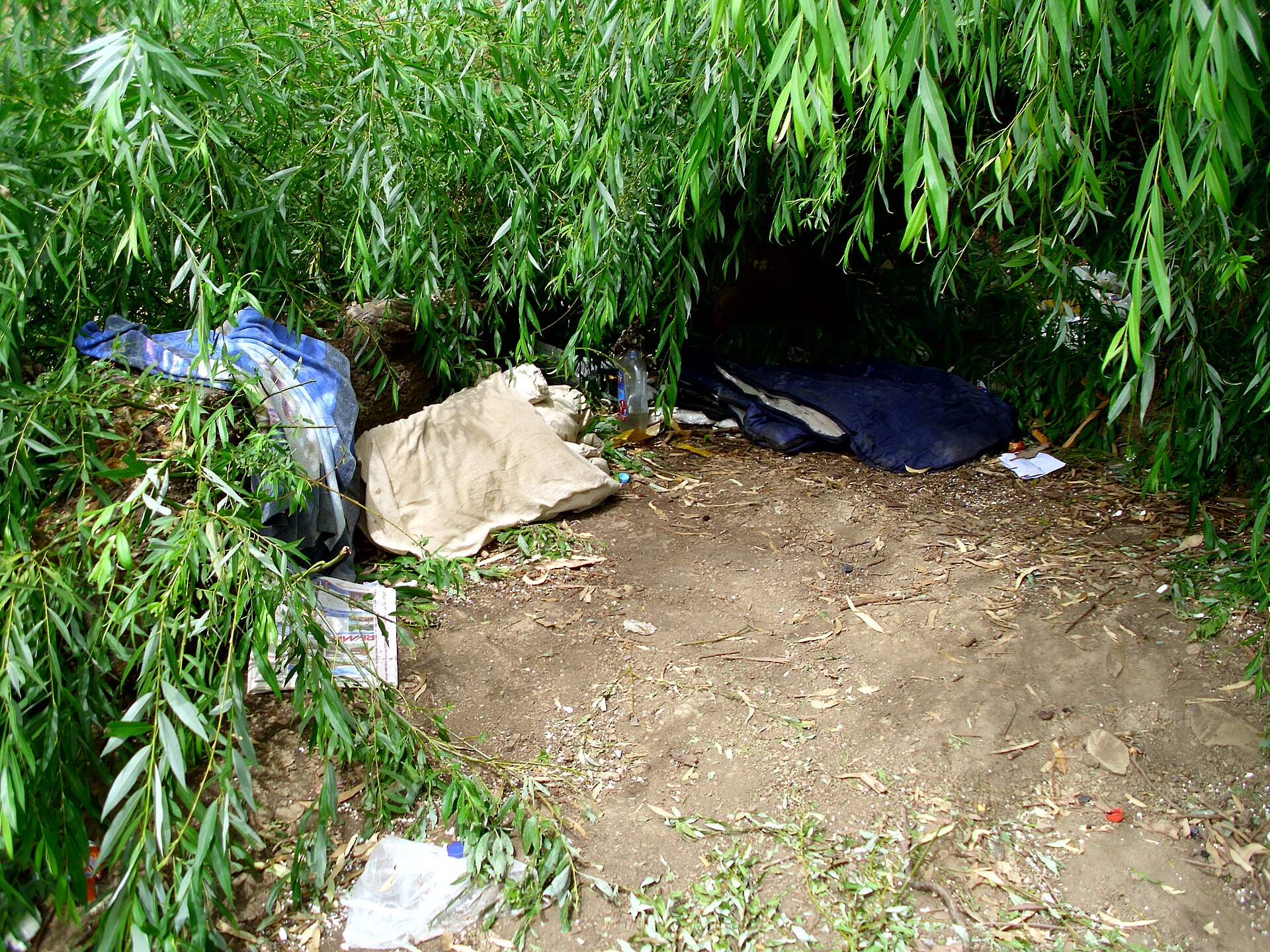 A homeless person's shelter under a fallen willow tree in Australia 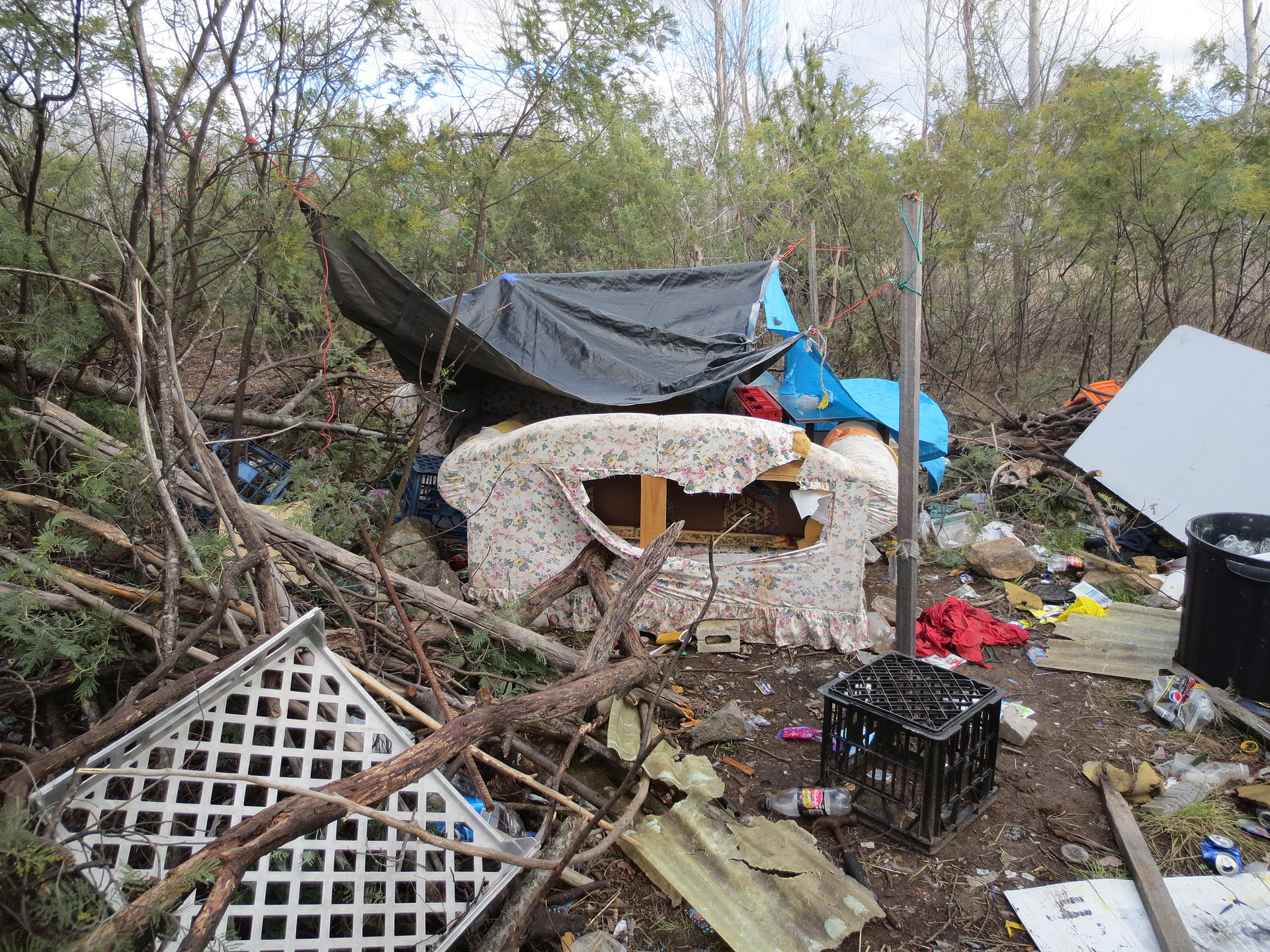 Abandoned transient encampment in Mawson, ACT In Australia, the Supported Accommodation Assistance Program (SAAP) is a joint Commonwealth and state government program which provides funding for more than 1,200 organizations that are aimed to assist homeless people or those in danger of becoming homeless, as well as women and children escaping domestic violence.[239] They provide accommodation such as refuges, shelters, and half-way houses, and offer a range of supported services. The Commonwealth assigned over $800 million between 2000 and 2005 for the continuation of SAAP. The current program, governed by the Supported Assistance Act 1994, specifies that "the overall aim of SAAP is to provide transitional supported accommodation and related support services, to help people who are homeless to achieve the maximum possible degree of self-reliance and independence. This legislation has been established to help the homeless people of the nation and help rebuild the lives of those in need. The cooperation of the states also helps enhance the meaning of the legislation and demonstrates their desire to improve the nation as best they can." In 2011, the Specialist Homelessness Services (SHS) program replaced the SAAP program.[240] New Zealand Main article: Homelessness in New Zealand Homelessness in New Zealand has been linked to the general issue of lack of suitable housing.[241] The population of homeless people is generally measured through the country's census and by universities and other academic centres. In 2009, urban homelessness (rough sleepers or improvised dwellings) were estimated at less than 300, while rural homelessness (improvised dwellings) was estimated at between 500 and 1000. An additional 8,000–20,000 people live in "temporary accommodation unsuited for long-term habitation (caravans, campgrounds, substandard housing, and boarding houses)."[242] Homelessness in New Zealand has traditionally been reduced by the provision of state housing, similar to Germany and other developed countries.[citation needed] Statistical authorities in New Zealand have expanded their definition of homelessness to include 'people living in improvised shelters', 'people staying in camping grounds/motor camps', and 'people sharing accommodation with someone else's household'.[243] The issue is believed to have become increasingly visible in recent[when?] years.[241] Media in New Zealand have published an accusatory account of the presence of homeless people in public spaces, positioning homeless men as disruptive threats. Though community members have shown support by writing opinion pieces.[244] In January 2019, The New York Times reported rising housing prices to be a major factor in the increasing homelessness in New Zealand so that "smaller markets like Tauranga, a coastal city on the North Island with a population of 128,000, had seen an influx of people who had left Auckland in search of more affordable housing. Average property values in Tauranga had risen to $497,000 from $304,000 in the last five years, and Demographia now rated it among the 10 least affordable cities in the world – along with famously expensive locales such as Hong Kong, San Francisco, Sydney and Vancouver, British Columbia."[245] In August 2019, the Associate Housing Minister Kris Faafoi and Social Development Minister Carmel Sepuloni announced that the Government would be launching a NZ$54 million program to tackle homelessness in New Zealand. This includes investing $31 million over the next four years for 67 intensive case managers and navigators to work with homeless people and a further $16 million for the Sustaining Tenancies Programme. This funding complements the Government's Housing First programme.[246][247] Russia and the USSR Main article: Homelessness in Russia After the abolition of serfdom in Russia in 1861, major cities experienced a large influx of former peasants who sought jobs as industrial workers in rapidly developing Russian industry. These people often lived in harsh conditions, sometimes renting a room shared between several families. There also was a large number of shelterless homeless people. Immediately after the October Revolution a special program of "compression" (уплотнение) was enabled: people who had no shelter were settled in flats of those who had large (4, 5, or 6-room) flats with only one room left to previous owners. The flat was declared state property. This led to a large number of shared flats where several families lived simultaneously. Nevertheless, the problem of complete homelessness was mostly solved as anybody could apply for a room or a place in a dormitory (the number of shared flats steadily decreased after the large-scale residential building program was implemented starting in the 1960s). 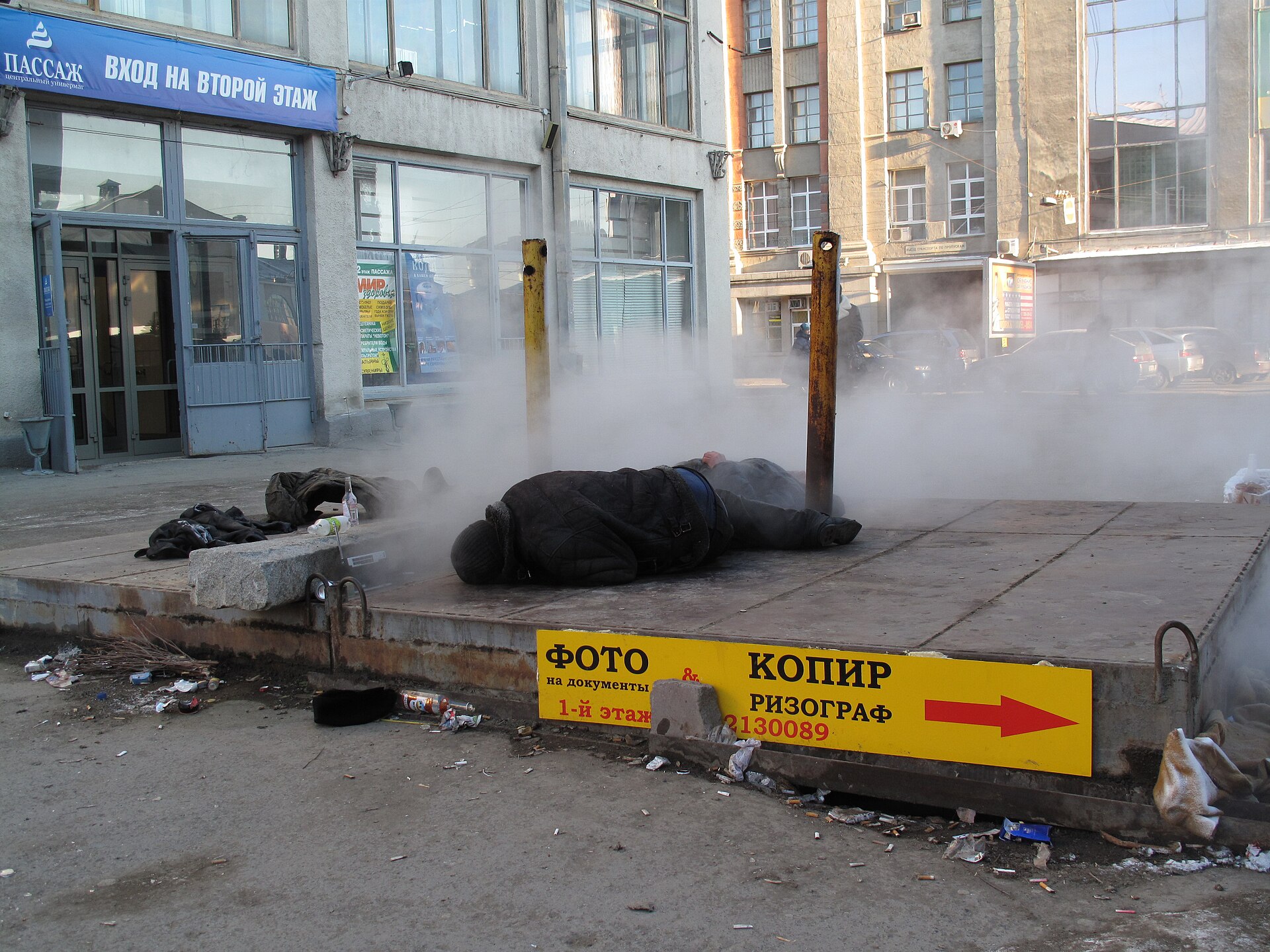 Homeless people sleeping outside in Yekaterinburg By 1922 there were at least seven million homeless children in Russia as a result of nearly a decade of devastation from World War I and the Russian Civil War.[248] This led to the creation of a large number of orphanages. By the 1930s the USSR declared the abolition of homelessness and any citizen was obliged to have a propiska – a place of permanent residency. Nobody could be stripped of propiska without substitution or refuse it without a confirmed permission (called "order") to register in another place. If someone wanted to move to another city or expand their living area, he had to find a partner who wanted to mutually exchange the flats. The right to shelter was secured in the Soviet constitution. Not having permanent residency was considered a crime. After the breakup of the USSR, the problem of homelessness sharpened dramatically, partially because of the legal vacuum of the early 1990s with some laws contradicting each other, and partially because of a high rate of fraud in the realty market. In 1991 articles 198 and 209 of the Russian criminal code which instituted a criminal penalty for not having permanent residence were abolished. In Moscow, the first overnight shelter for homeless people was opened in 1992.[249] In the late 1990s, certain amendments in law were implemented to reduce the rise in homelessness, such as the prohibition of selling last flats with registered children. In 2002, there were 300,000 homeless people in Moscow.[250] Nevertheless, the state is still obliged to give permanent shelter for free to anybody who needs better living conditions or has no permanent registration, because the right to shelter is still included in the constitution. Several projects of special cheap 'social' flats for those who failed to repay mortgages were proposed to facilitate the mortgage market.[251] In 2022, it was reported that Russian authorities were targeting homeless people to conscript them into the war in Ukraine.[252] General demographics 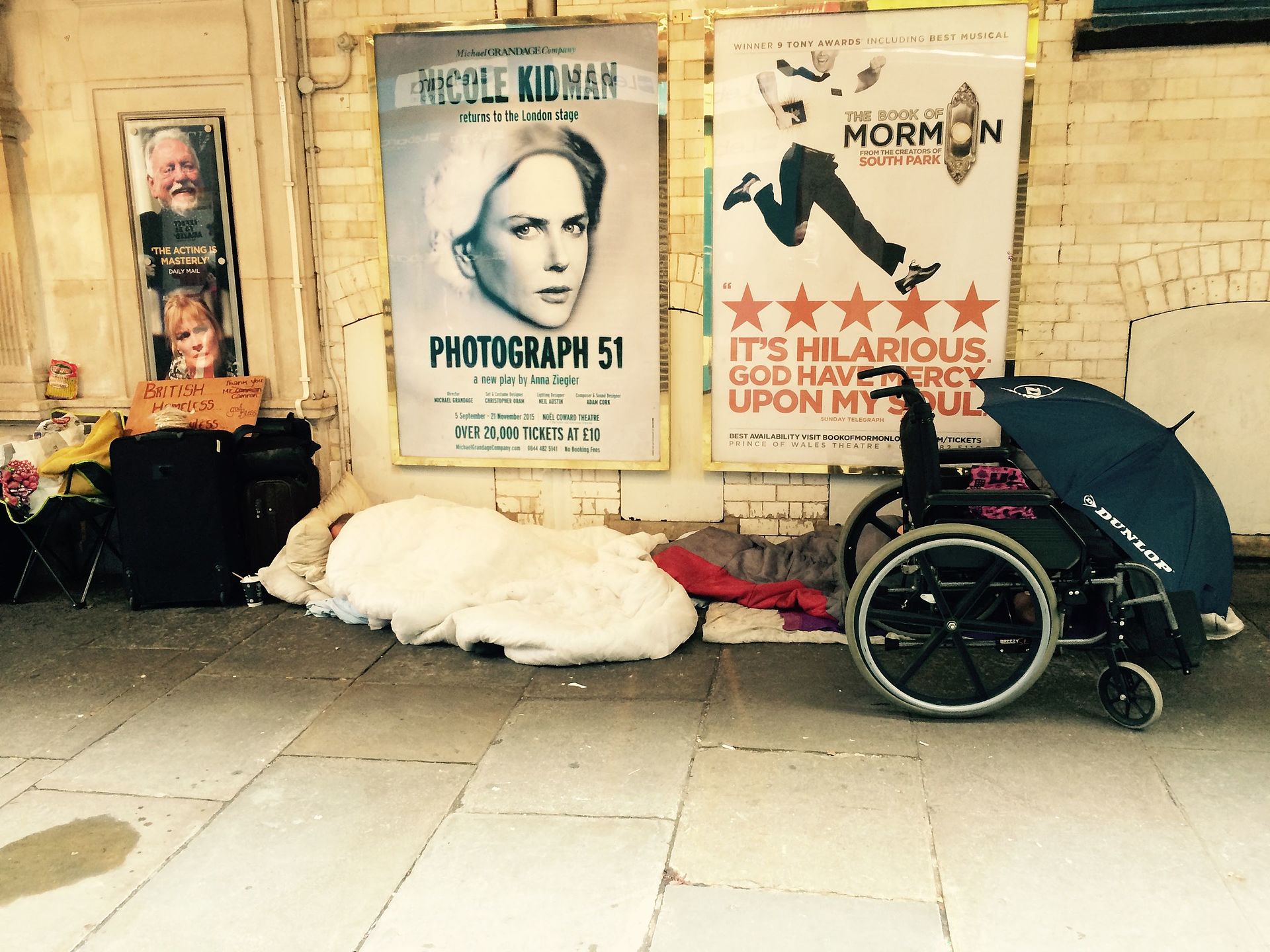 Homeless man sleeping in London, 2015 In western countries such as the United States, the typical homeless person is male and single,[253] with the Netherlands reporting 80 percent of homeless people aged 18–65 to be men. Some cities have particularly high percentages of males in homeless populations, with men comprising 85 percent of the homeless in Dublin, Ireland.[254] Non-white people are also overrepresented in homeless populations, with such groups two and one-half times more likely to be homeless in the U.S. The median age of homeless people is approximately 35.[255] Developed countries In 2005, an estimated 100 million people worldwide were homeless.[256] The following statistics indicate the approximate average number of homeless people at any one time. Each country has a different approach to counting homeless people, and estimates of homelessness made by different organizations vary wildly, so comparisons should be made with caution. European Union: 3,000,000 (UN-HABITAT 2004) England: 11,580 single households were assessed as rough sleeping at the point of approach in 2021, up 39 percent from 2019–20, with 119,400 households owed a prevention duty in 2020–21 [257] Scotland: 27,571 households were assessed as homeless in 2020 – 21, a decrease of 13 percent compared to 2019/20 [219] Canada: 150,000[258] Australia: On census night in 2006 there were 105,000 people homeless across Australia, an increase from the 99,900 Australians who were counted as homeless in the 2001 census[259] 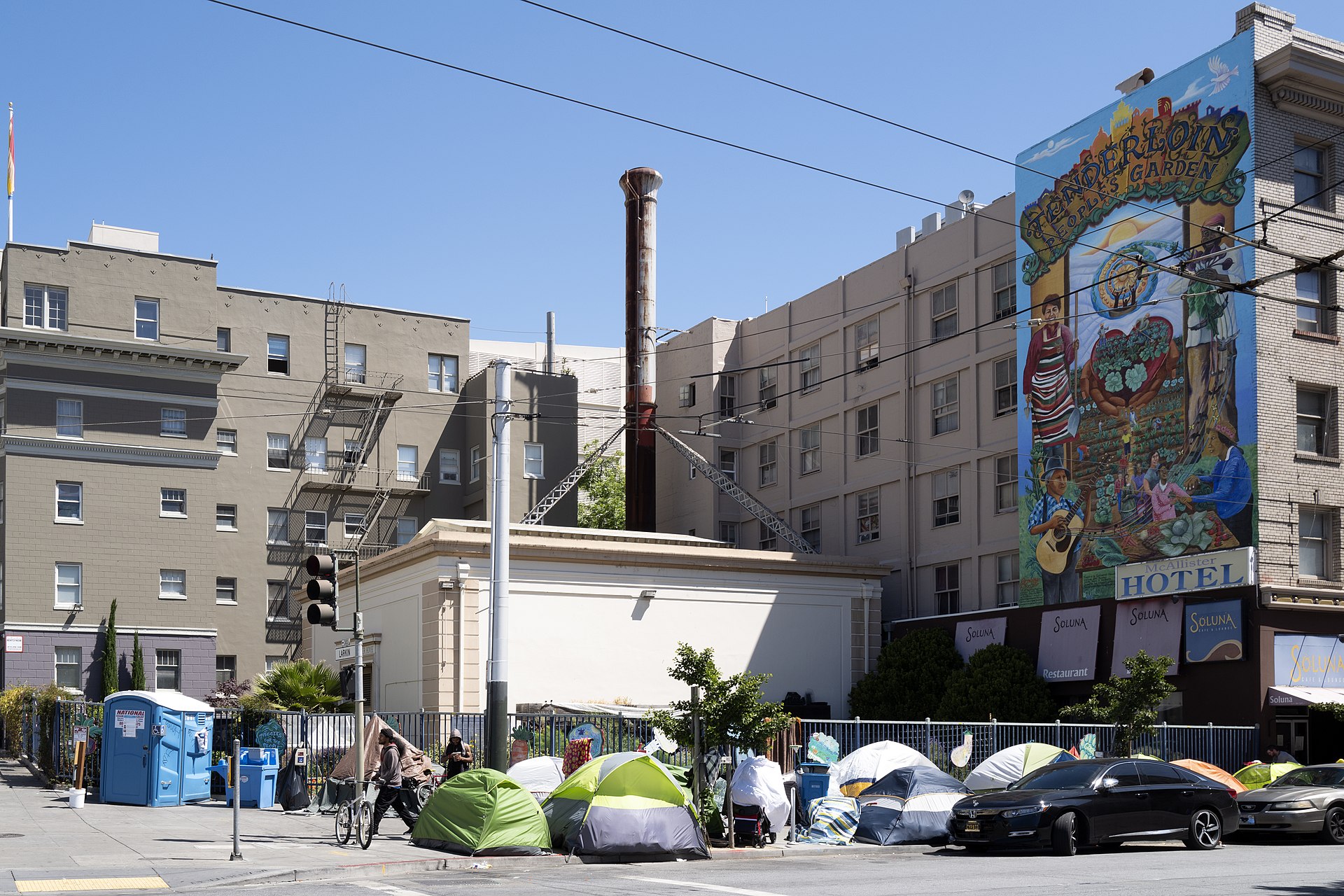 Tents of homeless people in San Francisco, California, May 2020 United States:[260] The HUD 2018 Annual Homeless Assessment Report (AHAR) to Congress reports that in a single night, roughly 553,000 people were experiencing homelessness in the United States.[261] According to HUD's July 2010 fifth Homeless Assessment Report to Congress, in a single night in January 2010, the single-point analysis reported to HUD showed 649,917 people experiencing homelessness. This number had increased from January 2009's 643,067. The unsheltered count increased by 2.8 percent while the sheltered count remained the same. Also, HUD reported the number of chronically homeless people (persons with severe disabilities and long homeless histories) decreased by one percent between 2009 and 2010, from 110,917 to 109,812. Since 2007 this number had decreased by 11 percent. This was mostly due to the expansion of permanent supportive housing programs. The change in numbers has occurred due to the prevalence of homelessness in local communities rather than other changes. According to HUD's July 2010 Homeless Assessment Report to Congress, more than 1.59 million people spent at least one night in an emergency shelter or transitional housing program during the 2010 reporting period, a 2.2 percent increase from 2009. Most users of homeless shelters used only an emergency shelter, while 17 percent used only transitional housing, and less than 5 percent used both during the reporting period. Since 2007, the annual number of those using homeless shelters in cities has decreased from 1.22 million to 1.02 million, a 17 percent decrease. The number of persons using homeless shelters in suburban and rural areas increased by 57 percent, from 367,000 to 576,000.[262] In the U.S., the federal government's HUD agency has required federally-funded organizations to use a computer tracking system for homeless people and their statistics, called HMIS (Homeless Management Information System).[263][264][265] There has been some opposition to this kind of tracking by privacy advocacy groups, such as EPIC.[266] However, HUD considers its reporting techniques to be reasonably accurate for homeless in shelters and programs in its Annual Homeless Assessment Report to Congress.[267][268] Determining and counting the number of homeless is very difficult in general due to their lifestyle habits.[269][270] There are so-called "hidden homeless" out of sight of the normal population and perhaps staying on private property.[271] Various countries, states, and cities have come up with different means and techniques to calculate an approximate count. For example, a one-night "homeless census count", called a point-in-time (PIT) count, usually held in early winter for the year, is a technique used by several American cities, such as Boston.[272][273][274] Los Angeles uses a mixed set of techniques for counting, including the PIT street count.[271][275] In 2003, The United States Department of Housing and Urban Development (HUD) had begun requiring a PIT count in all "Continuum of Care" communities which required them to report a count of people, housing status, and geographic locations of individuals counted. Some communities provide sub-population information to the PIT, such as information on veterans, youth, and elderly individuals, as done in Boston.[276] Japan: 20,000–100,000 (some figures put it at 200,000–400,000).[277] Reports show that homelessness is on the rise in Japan since the mid-1990s.[278] There are more homeless men than homeless women in Japan because it is usually easier for women to get a job and they are less isolated than men. Also, Japanese families usually provide more support for women than they do for men.[279] Developing countries 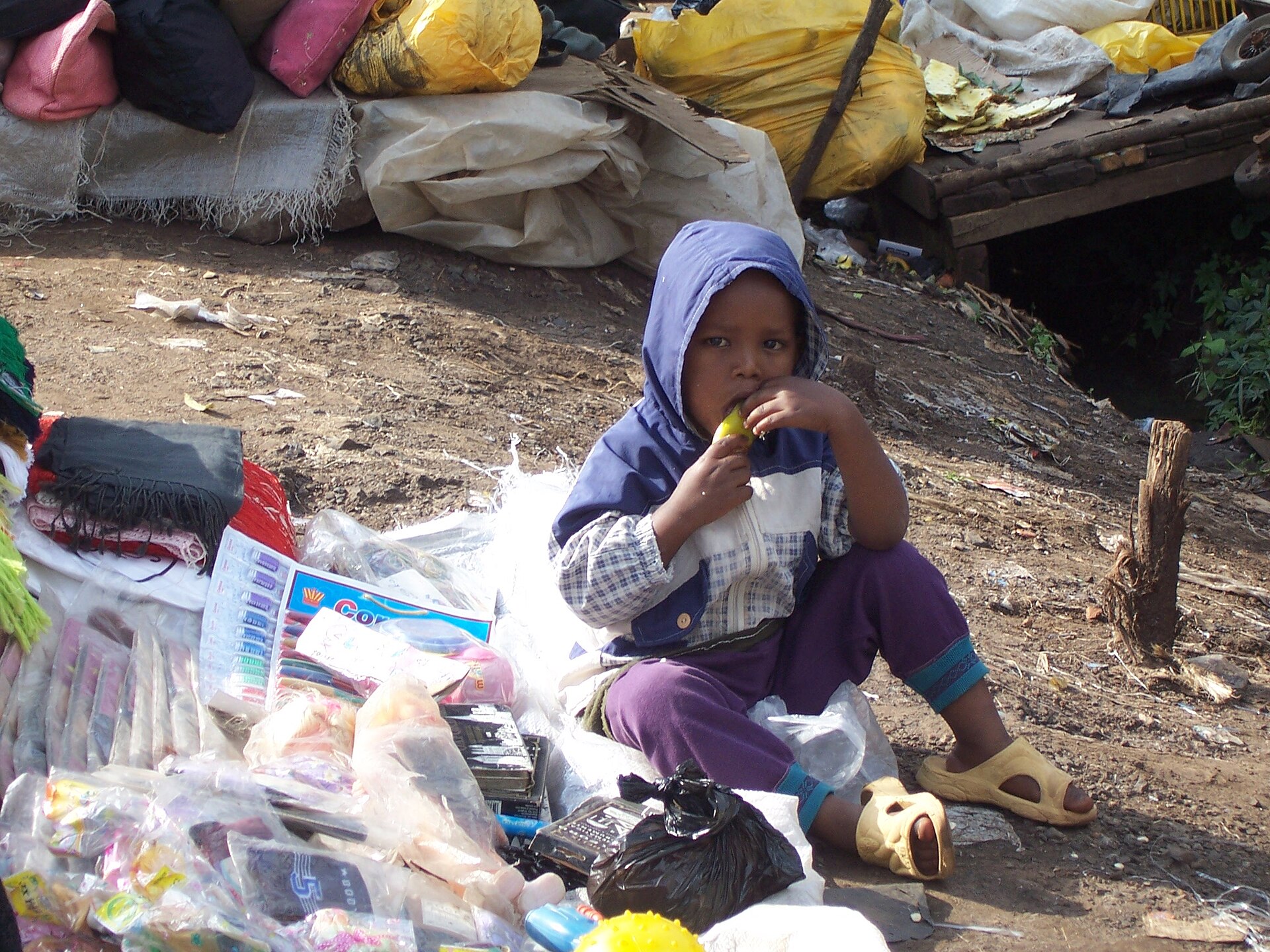 Street child in Kenya The number of homeless people worldwide grew steadily in 2005.[280][281] In some developing countries such as Nigeria and South Africa, homelessness is rampant, with millions of children living and working on the streets.[282][283] Homelessness has become a problem in the countries of China, India, Thailand, Indonesia, and the Philippines despite their growing prosperity, partly due to migrant workers who have trouble finding permanent homes.[284] Determining the true number of homeless people worldwide varies between 100 million and one billion people based on the exact definition used.[285] Refugees, asylum-seekers, and internally displaced persons can also be considered homeless in that they, too, experience "marginalization, minority status, socioeconomic disadvantage, poor physical health, the collapse of social supports, psychological distress, and difficulty adapting to host cultures" such as the domestic homeless.[286] In the past twenty years, scholars such as Tipple and Speak have begun to refer to homelessness as the "antithesis or absence of home" rather than rooflessness or the "lack of physical shelter." This complication in the homelessness debate further delineates the idea that home consists of an adequate shelter, an experienced and dynamic place that serves as a "base" for nurturing human relationships and the "free development of individuals" and their identity.[287] Thus, the home is perceived to be an extension of one's self and identity. In contrast, the homeless experience, according to Moore, constitutes more as a "lack of belonging" and a loss of identity that leads to individuals or communities feeling "out of place" once they can no longer call a place of their own home.[288] This new perspective on homelessness sheds light on the plight of refugees, a population of stateless people who are not normally included in the mainstream definition of homelessness. It has also created problems for researchers because the nature of "counting" homeless people across the globe relies heavily on who is considered a homeless person. Homeless individuals, and by extension refugees, can be seen as lacking lack the "crucible of our modern society" and lacking a way of actively belonging to and engaging with their respective communities or cultures.[289] As Casavant demonstrates, a spectrum of definitions for homelessness, called the "continuum of homelessness", should refer to refugees as homeless individuals because they not only lose their homes, but are also afflicted with a myriad of problems that parallel those affecting the domestic homeless, such as "[a lack of] stable, safe and healthy housing, an extremely low income, adverse discrimination in access to services, with problems of mental health, alcohol, and drug abuse or social disorganization".[290] Refugees, like domestic homeless people, lose their source of identity and way of connecting with their culture for an indefinite period. 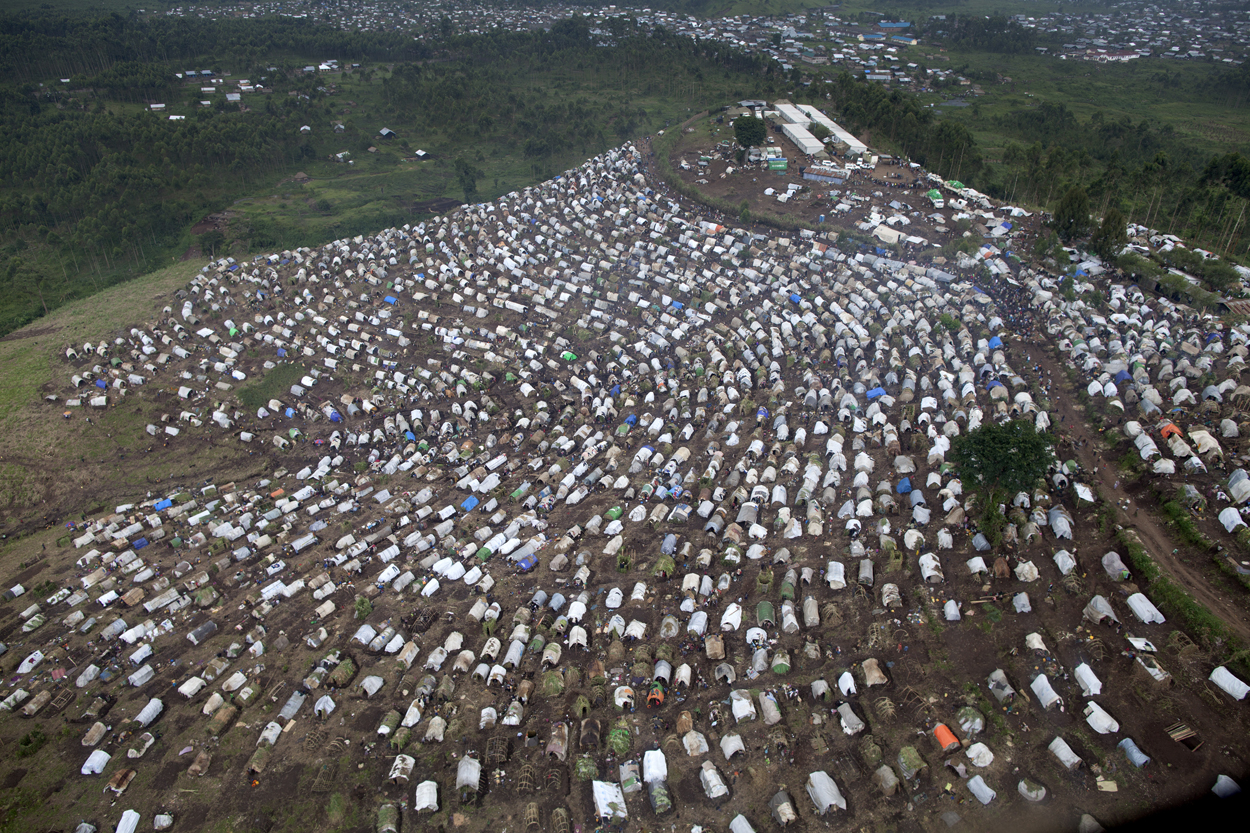 Refugee camp in the Democratic Republic of Congo, 2013 Thus, the current definition of homelessness allows people to simplistically assume that homeless people, including refugees, are merely "without a place to live" when that is not the case. As numerous studies show, forced migration and displacement bring with it another host of problems including socioeconomic instability, "increased stress, isolation, and new responsibilities" in a completely new environment.[291] For people in Russia, especially the youth, alcohol, and substance use is a major cause and reason for becoming and continuing to be homeless.[292] The United Nations Centre for Human Settlements (UN-Habitat) wrote in its Global Report on Human Settlements in 1995: "Homelessness is a problem in developed as well as in developing countries. In London, for example, life expectancy among homeless people is more than 25 years lower than the national average." Poor urban housing conditions are a global problem, but conditions are worst in developing countries. Habitat says that today 600 million people live in life- and health-threatening homes in Africa, Asia, and Latin America. For example, more than three in four young people had insufficient means of shelter and sanitation in some African countries like Malawi.[293] The report further states, "The threat of mass homelessness is greatest in those regions because that is where the population is growing fastest. By 2015, the 10 largest cities in the world will be in Asia, Latin America, and Africa. Nine of them will be in developing countries: Mumbai, India – 27.4 million; Lagos, Nigeria – 24.4; Shanghai, China – 23.4; Jakarta, Indonesia – 21.2; São Paulo, Brazil – 20.8; Karachi, Pakistan – 20.6; Beijing, China – 19.4; Dhaka, Bangladesh – 19; Mexico City, Mexico – 18.8. The only city in a developed country that will be in the top ten is Tokyo, Japan – 28.7 million."[294] In 2008, Dr. Anna Tibaijuka, executive director of UN-HABITAT, referring to the recent report "State of the World's Cities Report 2008/2009",[295] said that the world economic crisis we are in should be viewed as a "housing finance crisis" in which the poorest of the poor were left to fend for themselves.[296] |
国別ホームレス問題 さらに詳しい情報 ホームレス人口国別リスト アフリカ エジプト 主な記事 エジプトのホームレス問題 エジプトにおけるホームレス問題は、国内の約1,200万人に影響を及ぼす重大な社会問題である。エジプトには、標準的な建築法に準拠していない不規則な 住居のために指定された地域が1,200以上あり、ホームレスの人々が自分たちのために掘っ立て小屋やその他の避難所を建てることを可能にしている [128]。 伝えられるところによると、エジプトでは、ホームレスは限界住宅に住む人々を含むと定義されている[129]。一部の学者は、公式の定義が受け入れられた 場合に政府が直面する困難のため、エジプトではホームレスの合意された定義はないと述べている[130]。 ユニセフによると、エジプトには路上で暮らす子どもが100万人いる[131]。 他の研究者は、その数を約300万人と見積もっている[132]。 ストリートチルドレンを支援するホームレス支援NGOには、Hope Village Society、[131]、NAFASなどがある[129]。プラン・インターナショナル・エジプトなどの他のNGOは、ストリートチルドレンを家庭に 復帰させるために活動している[133]。 南アフリカ 主な記事 南アフリカのホームレス問題 南アフリカにおけるホームレスの問題は、アパルトヘイト時代にまでさかのぼる[134]。失業率の増加、手頃な価格の住宅の不足、社会崩壊、社会・経済政 策などが、すべてこの問題の一因であると指摘されている[135]。南アフリカにおけるホームレスの解決策は、法的・政治的な領域よりも私的な領域にある と主張する学者もいる[136]。 南アフリカのホームレスに関する国勢調査はなく、研究者は特定の都市におけるホームレスの個別調査に頼っている[137]。南アフリカのホームレス人口 は、多様な背景を持つ20万人と推定されている[138]。同時に、南アフリカのホームレスは、自治体が支援できる最も重要なことは、雇用と立地の良い手 頃な住宅であると回答している[139]。  南アフリカ、ステレンボッシュでリサイクル可能なものを集めるホームレス アジア 中国 主な記事 中国のホームレス問題 2011年、中国にはホームレスの大人が約241万人、ホームレスの子どもが17万9,000人暮らしていた[140]。 中国の住宅はフクウ制度によって高度に規制されている。このため、2019年には2億9,077万人という大量の出稼ぎ労働者が生まれている[142]。 これらの出稼ぎ労働者は農村部のフクウを持っているが、より良い仕事を見つけるために都市部に移動する。2017年、政府は北京の雑居ビルで発生した致命 的な火災に対応するため、密集した違法な共同宿泊施設を取り締まり、住民を立ち退かせることで、多くの出稼ぎ労働者をホームレスにした[144]。これ は、北京の人口増加を制限するための政府によるより大きな試みの文脈で、しばしば出稼ぎ労働者を標的としている。 [145]しかし、政府の公式統計[142]によれば、中国の出稼ぎ労働者は一人当たり平均20.4平方メートル(220平方フィート)の居住スペースを 持っており、大多数の出稼ぎ労働者は暖房、入浴、冷蔵庫、洗濯機などの基本的な生活設備を持っている。 中国では、いくつかの自然災害によってホームレスが発生している。2000年の雲南大地震では、92,479人が家を失い、41,000戸以上の家屋が倒 壊した[146]。 精神衛生上の問題を抱える人々のホームレスは、中国では家族の絆が強いため、高所得国に比べて「はるかに少ない」が、家族内の移動と一人っ子政策の結果、 増加している。湘潭の調査では、総人口280万人のうち、少なくとも2439人の精神分裂病患者がホームレスになっていることがわかった。その結果、 「ホームレス状態になるのは、社会的支援サービスが限られている農村地域出身者、地域社会から放浪している人(すなわち湘潭市以外の出身者)、教育水準が 低い人(社会的支援を動員する能力が低い人)に多い」ことがわかった。ホームレス状態はまた、年齢が高いこととも関連していた。[その原因は]高齢の患者 が親族との『橋』を燃やしてしまい、その結果、路上に行き着くということかもしれない」[147]。 文化大革命の間、児童福祉施設の大部分は閉鎖され、その住人はホームレスとなった。1990年代後半になると、見捨てられた子どもたちを収容するために、 多くの新しい施設が設立された。1999年、民政部は福祉施設にいる捨て子の数を66,000人と推定した[148]。 民政部によれば、中国は2014年に約300万人のホームレスの人々を支援するために約2,000のシェルターと20,000人のソーシャルワーカーを擁 していた[149]。 2017年から2019年にかけて、広東省政府は5,388人のホームレスが中国の他の場所にいる親族と再会するのを支援した。広東省政府は3年間で15 万人以上を支援した[150]。 2020年、COVID-19の大流行を受け、中国民政部はホームレス問題に対する中央委員会のいくつかの行動を発表し、支援サービスの増加やホームレス とその家族との再会を含む[151]。 武漢では、封鎖によってホームレスの移民が他の地域に戻ることが不可能になったため、ホームレスの状況は特に悪化した。武漢市民政局は市内に69の避難所 を設置し、4,843人を収容した[152]。 インド 主な記事 インドのホームレス問題 世界人権宣言では、「ホームレス」とは、適切な住居、安全性、利用可能性がないために通常の住居に住んでいない者と定義している[153]。国連経済社会 理事会声明は、ホームレスについてより広範な定義を持っており、ホームレスについて次のように定義している: 住宅について語るとき、私たちは単に4つの壁と屋根のことを言っているのではない。適切な住居を得る権利とは、賃借権の保障、経済的な余裕、サービスへの アクセス、文化的な妥当性を意味する。インドでは、「ホームレス」を、国勢調査に基づく家屋に住まず、舗道、道端、鉄道のプラットホーム、階段、寺院、道 路、パイプの中、その他の空き地に滞在する人々と定義している[154]。 [153]。2011年の国勢調査によると、インドには177万人のホームレスがおり、これは国の総人口の0.15%にあたる。例えば、2011年の国勢 調査ではデリーのホームレスの数は46.724人であったが、インドグローバル社会サービス協会では88,410人、デリー開発局と呼ばれる別の組織では 150,000人とカウントされている[154]。 [156]。インドには、世界のどの国よりも多い1,800万人のストリートチルドレンがおり、そのうち1,100万人が都市部に住んでいる[157] [158]。最後に、インドの首都ニューデリーには300万人以上の男女がホームレスとして暮らしている。 国内には1,878万戸の住宅が不足している。総住宅数は5,206万戸から7,848万戸に増加している(2011年国勢調査による)。しかし、 2003年現在、インドは依然として世界で最も裕福な国の第124位にランクされている[160]。インドでは9,000万人以上の人々が1日あたり1米 ドル以下の収入しか得ていないため、世界の貧困基準以下となっている[160]。インド政府が都市部のホームレスと貧困に取り組む能力は、今後、外的要因 と内的要因の両方によって影響を受ける可能性がある。 [160] インドのスラムに住む人々の数は、過去20年間で2倍以上に増加し、現在ではイギリスの全人口を超えているとインド政府は発表している[161]。 [162]世界のスラム居住者の17%がインドに居住している[160]。 2008年に長編映画『スラムドッグ$ミリオネア』が公開された後、ムンバイはホームレスやスラム居住者が観光客に公然と見られるスラムの観光地となった [163]。 インドネシア 主な記事 インドネシアのホームレス問題 インドネシアにおけるホームレス問題とは、安定した適切な住居がない状態を指す。インドネシアのホームレスの数は300万人に上り、ジャカルタだけでも 28,000人以上いると推定されている[164][165]。インドネシアのホームレスを表す用語として、政府によって使用されている tunawismaや、「浮浪者」を意味するgelandanganなど、いくつかの用語が使用されている[166][167]。 不法占拠者や路上ホームレスは、ホームレスが「街の魅力を邪魔している」とする警察の手入れによってしばしば標的にされる[165]。 インドネシアにおけるホームレスの原因のひとつは強制立ち退きである。研究者によると、2000年から2005年の間に92,000人以上が強制的に家を 追い出された[168]。 イラン イスファハン州知事によると、ホームレスが問題になっており、麻薬撲滅法の改正第16条により、犯罪者はIRGCか民間委託により3~6ヶ月間強制収容さ れる[169][170]。 [173]女性は隔離されている[174]。イランでは、墓場の住人と呼ばれる墓場で眠る人々、1泊25000トゥマンのバス、屋上、複数の家族が1つの アパートを借りて共有するなどの住宅危機がある[175][176][177][178][179][180][181][182][183]。多くの賃 借人は、輸送用コンテナにも居住スペースを借りたがることがある[184][185]。 イスラエル 主な記事 イスラエルのホームレス イスラエルにおけるホームレスは、主に1980年代半ば以降に発生した現象である[186]。 ホームレスは1991年のソビエト移民の波を受けて増加した。テルアビブのホームレスの70パーセントは旧ソ連からの移民で、ほぼ全員が男性である。ホー ムレスシェルターの創設者ギラド・ハリシュによれば、「1990年代初頭にイスラエルが不況に見舞われたとき、『最後に入ったら最初に出る』という原則が 働き、多くのロシア系移民が職を失った。イスラエルに来たばかりで、他のイスラエル人のように頼れる家族のサポートがなかった。行き場のない路上生活者に なる者もいた」[187]。 イスラエルでは2000年代にホームレスの数が増加し、イスラエル市民権協会は当局がこの問題を無視していると主張した[188]。 イスラエルでは毎年約2,000世帯が住宅ローンを滞納して家を失っている。しかし、2009年に可決された法改正により、住宅ローン債務者の権利が保護 され、住宅ローンの支払いが滞った後に立ち退きを迫られることはない。この法改正は、イスラエル市民権協会やその他の人権団体による長期にわたる闘争を受 けた、より広範な法改正の一環である[189]。 2007年、ホームレスの若者の数は増加傾向にあった。2004年には15%であったのに対し、2007年にはホームレスの青少年全体の25%以上が少女 であった。危険にさらされている青少年を支援する非営利団体エレムの報告書によると、親が働いている間や家庭内の関係がこじれているために、ホームレスに なったり、深夜に路上をさまよったりする青少年の数が5%増加したと指摘している。同団体は、2007年には全国約30か所でおよそ32,000人の青少 年にプログラムや一時的なシェルターを提供していたと推定している[190]。 2014年、イスラエルにおけるホームレスの数は1,831人と推定され、そのうち約600人がテルアビブの路上で生活していた[191]。これは同国の 人口の0.02パーセントを占め、他の先進国と比べて低い数字である。2015年7月、厚生省はホームレスの数を800~900人と推定しており、その中 には自治体からサービスや治療を受けながらも路上生活を続けている450人も含まれている。エレムは、本当の数字はもっと多いと主張した。2015年12 月、福祉省による大規模な調査で、イスラエルでは2,300人がホームレスであることが判明した[192][193]。 さらに、福祉省が運営する国営のホームレスシェルターと民間が運営するシェルターが存在する[192]。 イスラエルの写真家であるアディ・ネスは、イスラエルのホームレスの写真を撮影することで、この問題に世間の注目を集めた[194]。 日本 主な記事 日本のホームレス問題 日本のホームレス問題は、主に中高年男性に影響を与える社会問題である。ホームレス問題は、バブル崩壊後の1990年代にピークを迎え、その後は減少傾向 にある。 ホームレスの自立の支援等に関する特別法」(以下「特別法」という: ホームレスの自立の支援等に関する特別措置法)」によれば、「ホームレス」とは、「都市公園、河川敷、道路、駅その他の施設を滞在場所として日常生活を営 む者」と定義されている。 [195] 日本におけるホームレスの愛称には、「ホームレス」、「放浪者」、「乞食」、「ルンペン」などがある。最近では[いつから]、野宿者(のじゅくしゃ、「外 で寝る人」)や野宿労働者(のじゅくろうどうしゃ、「外で寝る労働者」)が、「ホームレス」という言葉から連想される否定的な意味合いを避けるために使わ れている[196]。 フィリピン 以下も参照: フィリピンのストリートチルドレン、フィリピンのスクワッティング フィリピンには約450万人のホームレスがおり、そのうち約300万人がマニラに住んでいる[197]。 ヨーロッパ 2023年9月に発表された欧州ホームレス支援全国組織連合(FEANTSA)の調査によると、少なくとも895,000人が一晩中ホームレス状態にある と推定されている。これは、ヨーロッパ23カ国の最新の国内統計に基づくもので、533,054人がホームレスとして記録されており、2022年のヨー ロッパの推定総人口(5億1,300万人)に対するこれらの国のホームレスの平均割合(0.174%)を当てはめたものである[198]。 スイス 主な記事 スイスのホームレス問題 スイスのホームレス問題は、社会問題として知られているが、その数はあまり知られていない[199]。ジュネーヴのホームレスの大半はスイス人とフランス 人であり、その他の国の人は少数派である[200]。 スイスのある研究によると、精神科病棟に入院している患者の1.6%がホームレスであった。この研究は、社会的要因と精神病理学が独立してホームレスのリ スクに寄与していると報告している[201]。 2014年、スイス当局は、ホームレスの人々が冷戦時代に建設された放射性降下物シェルターで寝泊まりすることを許可し始めたと報じられている [200]。 スネボゲ・コミュニティ・センターなど、ホームレスの人々に食料を提供するセンターも多い[202]。 イギリス 主な記事 イギリスのホームレス問題、イングランドのホームレス問題、スコットランドのホームレス問題 イギリス全土のホームレス問題は地方分権に委ねられているため、国によって法律や枠組み、定義さえも異なる。  イングランドにおける人口10万人当たりのホームレス数(1998~2014年) 1990年代後半以降、住宅政策は地方分権に委ねられており、ホームレスの人々に対する国の支援は、住宅に関する法的権利とともに、ある程度乖離してい る。ストリートリンクと呼ばれる全国的なサービスが2012年に設立され、政府の支援を受けて、一般の人々が特定のラフ・スリーパーに対して、ほぼ即座に 支援を受けられるようになった(住宅は地方分権の問題であるため、このサービスは現在イングランドにしか及んでいない)。 イングランドにおけるホームレスの年間世帯数は、2003-04年の135,420世帯をピークに、2009-10年には40,020世帯まで減少した [203]。2017-18年のホームレス世帯数は56,600世帯であり、2003-04年のピークを60%下回り、2009-10年の最低を40%上 回った[204]。 英国には一時的な宿泊施設にいる子どもが12万人以上おり、その数は2010年の69,050人から増加している[205][206]。 2007年のイングランドの公式発表では、毎晩平均498人が路上で寝ており、そのうち248人がロンドンで寝ていた[207]。 2010年以降、イングランドのホームレスは増加している。2016年までに、ラフに寝ている人の数は2010年の2倍以上になったと推定されている [208]。 会計検査院は、2010年から17年のイングランドのホームレスについて、一時的な宿泊施設で暮らす世帯が60パーセント増加し、ラフ・スリーパーが 134パーセント増加したと述べている[209][210]。 2017年にイングランドで一晩中外で寝泊まりした人は4,751人で、前年より15パーセント増加したと推定されている[211]。 住宅慈善団体シェルターは、2016年の公式統計の4つのセットのデータを使用し、イングランドで254,514人がホームレスであると計算した [212]。 ホームレス削減法案2016-17は、イングランドの地方自治体に対して、ホームレスの恐れがある人々を56日以内に支援し、2018年4月から単身ホー ムレスを含むすべての適格な申請者に対してホームレスの査定、予防、救済を行う新たな義務を課している[213]。 2017年のHRA以前は、ホームレス世帯は地方自治体によって「主なホームレス義務」を負っている世帯として定義され、測定されていた。しかし2018 年以降、ホームレス世帯は新たに救済義務と予防義務を負うことになり、ホームレス世帯の定義は広がった。主なホームレス支援義務の定義は、2017年の HRAによって変更されていない。しかし、これらの世帯が主義務を負うのは、ホームレス状態の予防や救済に成功していない場合に限られるようになった [214]。2019-20年には、288,470世帯が新たな予防義務や救済義務を負っており、これはホームレス削減法施行前の2017-18年に「主 義務」を負っていた世帯数の4倍である[204]。 ロンドンにおける女性のホームレスに関する調査では、人々が直面する状況は、その背景や経験によって異なる可能性があることが判明している。これは多重不 利と呼ばれている。2023年3月に発表された'Making Women Count' Report Archived 13 April 2023 at the Wayback Machineによると、たった1週間で154人以上の女性が寝泊まりしていることがわかった。このプロジェクトは、SHP、St Mungo's、Women's Development Unit(Solace Women's Aid、The Connection at St Martin's London Councils)、GLAと共同で、PraxisCollabの研究者とともに行われた。 スコットランドの状況はかなり異なっており、ホームレスになった場合、誰にでも屋根が与えられる法律がある[215]。しかし、2022年の間に、この状 況は変化し、HARSAG(Homeless and Rough Sleeping Action Group)の勧告に沿って、一時的な宿泊施設の利用が減少する予定である[216]。現在、人々は、恒久的な場所に収容されるまでの平均199日間 (2020年4月から2021年3月まで)を一時的な宿泊施設で過ごしている[217]。 直近では、2020年10月に更新された「Ending Homelessness Together」行動計画を通じて、スコットランドはホームレスの撲滅に取り組んでいる[218]。予防に重点を置くとともに、自治体が第三セクターと 協力して「Rapid Rehousing Transition Plans」として知られる計画に取り組むことで、ホームレスになる期間がなくなることが期待されている。 数字で見ると、2020-21年には、ホームレス世帯の人数は42,149人(スコットランドでは大人30,345人、子ども11,804人)であった [219]。これは前年から9%減少しているが、パンデミック開始時に統計の取り方が異なっていたことが一因かどうかは不明である。 北米 カナダ このセクションはカナダのホームレス問題からの抜粋である[編集]。  ケベック市のホームレスの落書き カナダにおけるホームレス問題は、1980年代までは社会問題ではなかった[220]。 1970年代を通じて実施されていたカナダ政府の住宅政策とプログラムは、シェルターは生存のための基本的な必要条件であり、政府と社会はすべての人に適 切な住宅を提供する義務があるという概念に基づいていた[220][221]。1980年代にカナダのような裕福な欧米諸国では、公共政策がリハウジング からシフトし、それまで収容されていた世帯の非収容につながった。国連が国際ホームレス・シェルター年(IYSH)を定めた1987年までに、カナダでは ホームレス問題が深刻な社会問題となった。1987年にオタワで開催されたIYSHの主要会議の報告書によると、住宅は政府にとって優先順位の高いもので はなく、これがホームレス問題の大きな要因となっている。カナダの低所得世帯のために、適切で手ごろな価格の住宅が求められていたにもかかわらず、政府か らの資金援助は得られなかったのである。1980年代には、「より幅広い層」が初めてホームレス状態を経験するようになり、緊急シェルターや炊き出しを利 用するようになった。シェルターは過密状態になり始め、ホームレスのためのサービスに対する需要は増加の一途をたどった。1980年代半ばから1990年 代にかけて、連邦政府は国の住宅プログラムを相次いで削減した。カナダ経済が好調だった1990年代も削減は続き、1973年の国営住宅プログラムの削減 など、場合によってはさらに加速した。ホームレス問題に対する政府の解決策は、ホームレスシェルターを増設し、緊急サービスを強化することだった。トロン トのような大都市圏では、ホームレスシェルターの利用が1988年から1998年にかけて75%増加した。モントリオール、ラヴァル、バンクーバー、エド モントン、カルガリーなどの都市部では、ホームレスの増加が見られた[222]。 アクションプラン2011において、カナダ連邦政府は、2014年4月から2019年4月まで毎年1億2,000万ドル(うち7,000万ドルは新規資 金)を、住宅第一モデルに焦点を当てたホームレス支援戦略(HPS)の更新に充てることを提案した。カナダ全土の民間または公的機関が、ハウジング・ ファースト・プログラムを実施するためにHPSの補助金を受けることができる。 米国 主な記事 米国のホームレス問題 以下も参照: 米国のホームレス女性、米国のテント村一覧、米国の手頃な住宅も参照のこと。  ホームレスの男性に食事を与える女性(2008年、アメリカ・ニューヨーク市にて) 1933年にハーバート・フーバーから大統領職を引き継いだフランクリン・D・ルーズベルトは、ニューディールの成立を監督し、公共住宅の建設資金を提供 するなど、社会福祉を大幅に拡大した。しかし、1980年代にロナルド・レーガンが、ニューディール政策によって連邦政府が資金提供した手頃な価格の住宅 建設を含む公共住宅予算を削減したため、ホームレスの数は増加した[223]。これに結びついたのが、貧困にあえぎ家出する子どもやティーンエイジャー、 若者の増加であり、ホームレスの新たな基層(ストリートチルドレンやストリートユース)を生み出した[224]。 2015年、米国は国境内に564,708人のホームレスがいると報告しており、これは世界的に報告されている数値の中でも高い部類に入る[225]。 ハウジング・ファーストは、ホームレスの人々が社会復帰し、ホームレスシェルターから出ることを支援する取り組みである。連邦政府のホームレス問題省庁間 協議会(Interagency Council on Homelessness)によって始められた。慢性的なホームレス状態を解消するための計画を立てるよう各都市に求めている。この方向性では、ホームレ スの人々に自立した住居が与えられ、適切な社会的支援があれば、緊急のホームレス・シェルターは必要なくなるという考えがあり、これは良い結果だと考えら れている。しかし、これは議論のある立場である[226][227][228]。 住宅第一プログラムが治療第一プログラムよりも効率的に機能しているという証拠がある。研究によれば、ハウジング・ファースト・プログラムによって住居が 安定することで、ホームレスの人々は薬物乱用など、直面している他の闘いに集中するようになる。一方、トリートメント・ファースト・プログラムは、「オー ル・オア・ナッシング」のアプローチを推進し、住宅斡旋の条件として、クライエントが直面している問題に該当するプログラムに参加することを要求する。ト リートメント・ファーストは、ハウジング・ファーストよりも個人主義的なアプローチを用いず、それぞれのクライアントの特定のニーズに合わせるのではな く、一つの基準の下で解決策が作られる[228]。  ロサンゼルスのスキッドロウには、5,000人から8,000人という、アメリカでも最大規模のホームレスが安定して暮らしている[229]。 2009年には、アメリカでは子どもの50人に1人、150万人の子どもが毎年何らかの形でホームレス状態を経験すると推定された[230]。 2009年に36,000人以上のホームレスがいたニューヨーク市では、2010年、街頭でホームレスがスクリーンに映し出され、見物人や通行人に彼への メッセージを携帯電話でメールするよう求める移動式のビデオ展示が行われ[231]、Pathways to Housingという団体に携帯電話で寄付をすることもできた[232][233]。 2010年9月、マサチューセッツ州ボストンでは、ホームレスの家族は依然として増加しているものの、ハウジング・ファースト・イニシアチブによって慢性 的なホームレスの単身者が大幅に減少したと報告された。いくつかのシェルターはホームレスの数の減少のためにベッド数を減らしており、いくつかの緊急シェ ルター施設は、特に緊急のボストンナイトセンターを閉鎖していた[234]。 2011年、退役軍人省の退役軍人の家族のための支援サービスイニシアチブ、SSVFは、恒久的な住宅に住んでいるか、移行している非常に低所得の退役軍 人の家族に支援サービスを提供するために、民間の非営利団体や消費者協同組合に資金を提供し始めた[235]。 2019年、CBSニュースのインタビューで、学者のサラ・ゴールドリック=ラブは、大学生のホームレスに関する研究で、「大学生の10人に1人以上が、 過去1年間にホームレスになったと回答しており、少なくとも1回は、どこで寝るかわからない夜を過ごしたことになる」と述べた[236]。 プエルトリコ プエルトリコ家族省によるカウントによると、2017年1月、同領土には3,501人のホームレスがいた。調査によると、この人口の26%が首都サンフア ンに住んでいる。その他の自治体のこの人口の割合は、ポンセが6.3%、アレシボが6%、カグアスが5.3%、マヤグエスが4.7%であった。調査の結 果、ホームレス人口の76パーセントが男性、24パーセントが女性で、男女とも平均年齢は40歳であった。この着実に増加している人口は、プエルトリコ島 に900億ドル以上の被害をもたらしたハリケーン「マリア」の結果、より急激に増加した可能性がある[237]。 サンフアンの地域社会開発局から提供されたデータによれば、1988年の同自治体におけるホームレスの数は368人であったが、2017年には約877人 が家を失っていた。ホームレス全体の平均年齢は男女ともに40歳であるが、サン・ファンでは中央値が男性48歳、女性43歳である。その他のデータでは、 50%以上が大学レベルの教育を受けている。また、男性の35%、女性の25%が、社会復帰に失敗した後、4回以上再発していることが明らかになった。徘 徊の理由はさまざまで、最も多いのは薬物乱用(30.6%)、家族の問題(22.4%)、経済的・金銭的問題(15.0%)、その他、失業、精神衛生上の 問題、家庭内暴力、立ち退き、出所時の支援不足などである[238]。 オセアニア オーストラリア 主な記事 オーストラリアのホームレス問題 このセクションは更新が必要です。最近の出来事や新たに入手した情報を反映させるため、この記事の更新にご協力ください。(2023年5月)  倒れた柳の木の下のホームレス・シェルター(オーストラリア  ACT州モーソンに放置された一過性の野営地 オーストラリアでは、SAAP(Supported Accommodation Assistance Program)は連邦政府と州政府の共同プログラムであり、ホームレスの人々やホームレスになる恐れのある人々、ドメスティック・バイオレンスから逃れ てきた女性や子どもを支援することを目的とした1,200以上の団体に資金を提供している[239]。 連邦はSAAPの継続のために、2000年から2005年の間に8億ドル以上を割り当てた。1994年に制定された支援法(Supported Assistance Act 1994)によって規定された現在のプログラムは、「SAAPの全体的な目的は、一時的な支援宿泊施設と関連支援サービスを提供し、ホームレスの人々が最 大限の自立と自律を達成できるように支援することである」と明記されている。この法律は、国のホームレスの人々を助け、困窮している人々の生活再建を支援 するために制定された。各州の協力もまた、この法律の意義を高め、この国をできる限り良くしていきたいという願望を示すのに役立っている。" 2011年、Specialist Homelessness Services(SHS)プログラムがSAAPプログラムに取って代わった[240]。 ニュージーランド 主な記事 ニュージーランドのホームレス問題 ニュージーランドのホームレス問題は、適切な住居の不足という一般的な問題と関連している[241]。ホームレスの人口は、一般的に国勢調査や大学などの 学術センターによって測定されている。2009年には、都市部のホームレス(ラフ・スリーパーまたは即席住居)は300人未満、農村部のホームレス(即席 住居)は500~1,000人と推定されている。さらに8,000~20,000人が「長期的な居住に適さない一時的な宿泊施設(キャラバン、キャンプ 場、標準以下の住宅、寄宿舎)」に住んでいる[242]。ニュージーランドのホームレスは、ドイツや他の先進国と同様に、伝統的に国営住宅の提供によって 減少してきた[要出典]。 ニュージーランドの統計当局はホームレスの定義を拡大し、「即席のシェルターで生活する人々」、「キャンプ場/モーターキャンプに滞在する人々」、「他人 の世帯と宿泊施設を共有する人々」を含めるようになった[243]。 ニュージーランドのメディアは、公共の場にホームレスがいることを非難するような記事を掲載し、ホームレスの男性を破壊的な脅威として位置づけている [241]。コミュニティのメンバーはオピニオンピースを書くことで支持を示しているが[244]。 2019年1月、ニューヨーク・タイムズ紙は、住宅価格の上昇がニュージーランドにおけるホームレス増加の主な要因であるとして、「人口128,000人 の北島の沿岸都市であるタウランガのような小規模な市場では、より手頃な価格の住宅を求めてオークランドを離れた人々が流入していた」と報じた。タウラン ガの平均不動産価格は過去5年間で30万4,000ドルから49万7,000ドルに上昇し、デモグラフィアは現在、香港、サンフランシスコ、シドニー、ブ リティッシュコロンビア州バンクーバーといった有名な高価な地域とともに、世界で最も手頃な価格の都市10選にランクインしている」[245]。 2019年8月、クリス・ファアフォイ準住宅大臣とカーメル・セプロニ社会開発大臣は、政府がニュージーランドのホームレス問題に取り組むために 5,400万ニュージーランド・ドルのプログラムを開始すると発表した。このプログラムには、ホームレスの人々に対応する67人の集中ケースマネージャー とナビゲーターに今後4年間で3,100万ドルを投資することと、さらに1,600万ドルを「入居の維持」プログラムに投資することが含まれている。この 資金は、政府のハウジング・ファースト・プログラムを補完するものである[246][247]。 ロシアとソビエト連邦 主な記事 ロシアのホームレス問題 1861年にロシアで農奴制が廃止された後、主要都市には、急速に発展するロシアの工業に産業労働者として職を求める元農民が大量に流入した。こうした人 々はしばしば過酷な環境で暮らし、時には数家族で共同使用する部屋を借りることもあった。また、住まいのないホームレスも大量に発生した。10月革命の直 後、「圧縮」(уплотнение)という特別プログラムが実施され、住居のない人々は、前の所有者が残した1部屋しかない大きな(4、5、6部屋)ア パートを持つ人々のアパートに住み着くことになった。そのアパートは国有財産とされた。そのため、複数の家族が同時に暮らすシェアアパートが大量に生まれ た。とはいえ、誰でも部屋や寮に申し込むことができたため、完全なホームレスの問題はほとんど解決された(1960年代から大規模な住宅建設計画が実施さ れた後、共同アパートの数は着実に減少した)。  エカテリンブルクで外で眠るホームレスの人々 第一次世界大戦とロシア内戦による10年近い荒廃の結果、1922年までにロシアには少なくとも700万人のホームレスの子どもがいた[248]。 1930年代までに、ソ連はホームレスの廃止を宣言し、国民は誰でもプロピスカ(永住地)を持つことが義務づけられた。代用品なしでプロピスカを剥奪され たり、別の場所に登録する許可(「命令」と呼ばれる)が確認されない限り拒否されたりすることはなかった。誰かが他の都市に引っ越したり、居住地域を拡大 したりしたい場合は、相互にアパートを交換したいパートナーを見つけなければならなかった。居住権はソビエト憲法で保障されていた。永住権を持たないこと は犯罪とみなされた。 ソビエト連邦崩壊後、ホームレスの問題は劇的に深刻化した。1990年代初頭には、いくつかの法律が互いに矛盾し、不動産市場で詐欺が多発したため、法律 の空白が生じたからである。1991年、ロシア刑法198条と209条が廃止され、永住権を持たないことに対する刑事罰が設けられた。モスクワでは、 1992年にホームレスのための最初の宿泊シェルターが開設された[249]。1990年代後半には、ホームレスの増加を抑えるために、登録された子ども たちのいる最後のアパートを販売することを禁止するなど、一定の法改正が実施された。2002年には、モスクワには30万人のホームレスがいた [250]。 とはいえ、より良い生活環境を必要とする人や永住登録のない人に対しては、シェルターを提供する権利が憲法に盛り込まれているため、国家は依然として恒久 的なシェルターを無償で提供する義務を負っている。住宅ローン市場を促進するために、住宅ローンを返済できなかった人々のための特別に安価な「社会的」ア パートのプロジェクトがいくつか提案された[251]。 2022年には、ロシア当局がウクライナでの戦争に徴兵するためにホームレスの人々を標的にしていると報じられた[252]。 一般的な人口統計  2015年、ロンドンで眠るホームレスの男性 アメリカなどの西側諸国では、典型的なホームレスは男性で独身であり[253]、オランダでは18~65歳のホームレスの80%が男性であると報告されて いる。ホームレスの集団に占める男性の割合が特に高い都市もあり、アイルランドのダブリンではホームレスの85パーセントが男性である[254]。非白人 もホームレスの集団に占める割合が高く、そのようなグループはアメリカではホームレスになる確率が2.5倍高い。 先進国 2005年には、世界で推定1億人がホームレスであった[256]。以下の統計は、ホームレスのおおよその平均数を示している。ホームレスの数を数える方 法は国によって異なり、異なる団体による推定値も大きく異なるため、比較には注意が必要である。 欧州連合(EU 3,000,000人(2004年アンハビタット調べ) イングランド:2021年のアプローチ時点でラフ・スリープと評価された単身世帯は11,580世帯で、2019-20年から39%増加し、2020- 21年には119,400世帯が予防義務を負う[257]。 スコットランド:2020~21年にホームレスと評価された世帯は27,571世帯で、2019~20年に比べて13%減少した[219]。 カナダ 150,000[258] オーストラリア 2006年の国勢調査の夜には、オーストラリア全土で10万5000人のホームレスがおり、2001年の国勢調査でホームレスとしてカウントされた 99,900人から増加している[259]。  2020年5月、カリフォルニア州サンフランシスコのホームレスのテント アメリカ:[260] HUDの2018年の議会への年次ホームレス評価報告書(AHAR)によると、一晩でおよそ553,000人がアメリカでホームレス状態を経験していた [261] 。 HUDの2010年7月の議会への第5回ホームレス評価報告書によると、2010年1月の一晩で、HUDに報告された一点分析では649,917人がホー ムレス状態を経験していた。この数は、2009年1月の643,067人から増加していた。非保護者数は2.8%増加したが、保護者数は変わらなかった。 また、HUDの報告によると、慢性的ホームレス(重度の障害を持ち、ホームレス歴の長い人)の数は、2009年から2010年の間に1%減少し、 110,917人から109,812人となった。2007年以降、この数は11%減少していた。これは主に、恒久的支援住宅プログラムの拡大によるもので ある。 この数字の変化は、他の変化というよりも、地域社会におけるホームレスの蔓延によるものである。HUDの2010年7月議会へのホームレス評価報告書によ ると、2010年の報告期間中、159万人以上の人々が、緊急シェルターや過渡的住居プログラムで少なくとも一晩を過ごし、2009年から2.2%増加し た。ホームレスシェルター利用者のほとんどは緊急シェルターのみを利用し、17%は移行措置住宅のみを利用した。2007年以降、都市部におけるホームレ スシェルターの年間利用者数は、122万人から102万人へと17%減少した。郊外や農村部でホームレス・シェルターを利用する人の数は、36万7000 人から57万6000人へと57パーセント増加している[262]。アメリカでは、連邦政府のHUD機関は、連邦政府から資金援助を受けている団体に対 し、HMIS(ホームレス管理情報システム)と呼ばれる、ホームレスの人々とその統計に関するコンピューター追跡システムの使用を義務づけている [263][264][265]。EPICのようなプライバシー擁護団体からは、この種の追跡に対して反対の声も上がっている[266]。 しかし、HUDは、議会への年次ホームレス評価報告書において、シェルターやプログラムにいるホームレスについて、その報告技術は合理的に正確であるとみ なしている[267][268] ホームレスの数を決定し、カウントすることは、彼らの生活習慣のために、一般的に非常に困難である[269][270] いわゆる「隠れホームレス」は、通常の人口の視界から外れており、おそらくは私有地に滞在している[271] 様々な国、州、都市が、おおよそのカウントを計算するための異なる手段や技術を考え出した。例えば、ポイント・イン・タイム(PIT)カウントと呼ばれ る、通常その年の初冬に行われる一晩の「ホームレス・センサス・カウント」は、ボストンなどアメリカのいくつかの都市で使用されている手法である [272][273][274]。ロサンゼルスでは、PITストリート・カウントを含め、カウントのための様々な手法が混在して使用されている[271] [275]。 2003年、米国住宅都市開発省(HUD)は、すべての「継続的ケア(Continuum of Care)」コミュニティにおいて、PITカウントを要求し始めた。ボストンのように、退役軍人、青少年、高齢者に関する情報など、小人口情報をPITに 提供している地域もある[276]。 日本:20,000~100,000人(200,000~400,000人という数字もある)[277] 日本では1990年代半ばからホームレスが増加しているという報告がある[278] 。また、日本の家族は通常、男性よりも女性に多くの支援を提供している[279]。 発展途上国  ケニアのストリートチルドレン ナイジェリアや南アフリカのようないくつかの発展途上国では、ホームレスが蔓延しており、何百万人もの子どもたちが路上で生活し、働いている[282] [283]。中国、インド、タイ、インドネシア、フィリピンの国々では、繁栄が進んでいるにもかかわらず、ホームレスが問題になっている。 難民、亡命希望者、国内避難民もまた、国内のホームレスのような「疎外、マイノリティの地位、社会経済的不利、身体的健康の低下、社会的支援の崩壊、心理 的苦痛、受け入れ文化への適応の困難さ」を経験しているという点で、ホームレスとみなすことができる[286]。 過去20年間で、ティップルやスピークのような学者は、ホームレス状態を、屋根のない状態や "物理的なシェルターの欠如 "ではなく、"家のアンチテーゼや不在 "と呼ぶようになった。ホームレスの議論におけるこのような複雑化は、家とは適切なシェルターであり、人間関係や「個人の自由な発達」とそのアイデンティ ティを育むための「基盤」として機能する、経験豊かでダイナミックな場所であるという考えをさらに明確にしている[287]。したがって、家は自己とアイ デンティティの延長であると認識されている。対照的に、ムーアによれば、ホームレスの経験は、「帰属の欠如」とアイデンティティの喪失としてより構成さ れ、自分の居場所と呼べる場所がなくなると、個人やコミュニティは「居場所がない」と感じるようになる[288]。 ホームレスに対するこの新しい視点は、通常ホームレスの主流の定義には含まれない無国籍の人々である難民の苦境に光を当てるものである。また、世界中の ホームレスの数を「数える」という性質上、誰がホームレスとみなされるかに大きく依存するため、研究者にとっても問題が生じている。ホームレスの人々、ひ いては難民は、「現代社会の坩堝」に欠けており、それぞれのコミュニティや文化に積極的に所属し、関わる方法を欠いているとみなすことができる。 [289]カサヴァンが示すように、「ホームレスの連続性」と呼ばれるホームレスの定義のスペクトルは、難民をホームレスと呼ぶべきである。なぜなら、難 民は家を失うだけでなく、「安定した安全で健康的な住居の欠如、極端な低所得、サービスへのアクセスにおける不利な差別、精神衛生、アルコール、薬物乱 用、社会的無秩序の問題」など、国内のホームレスに影響を与える問題と並行する無数の問題に悩まされているからである。 [290] 難民は、国内のホームレスと同様に、アイデンティティの源泉や文化とのつながり方を無期限に失う。  コンゴ民主共和国の難民キャンプ、2013年 このように、現在のホームレスの定義では、難民を含むホームレスの人々は単に「住む場所がない」だけだと単純に考えることができるが、実際はそうではな い。数多くの研究が示すように、強制移住や移住は、まったく新しい環境での社会経済的不安定性、「ストレスの増大、孤立、新たな責任」など、別の多くの問 題をもたらす[291]。 ロシアの人々、特に若者にとって、アルコールと薬物の使用は、ホームレスになり、ホームレスであり続ける主な原因であり理由である[292]。国連人間居 住センター(UN-Habitat)は、1995年の人間居住に関する世界報告書の中で、「ホームレスは、発展途上国だけでなく先進国でも問題である。例 えばロンドンでは、ホームレスの平均寿命は全国平均より25歳以上も低い。 都市の劣悪な住宅事情は世界的な問題だが、途上国では最悪の状況だ。ハビタットによると、現在、アフリカ、アジア、ラテンアメリカでは、6億人が生命や健 康を脅かす住宅に住んでいる。例えば、マラウィのようなアフリカの国々では、若者の4人に3人以上がシェルターや衛生設備が不十分である。2015年まで に、世界の10大都市はアジア、ラテンアメリカ、アフリカになる。そのうち9都市は発展途上国である: ムンバイ(インド)2740万人、ラゴス(ナイジェリア)24.4人、上海(中国)23.4人、ジャカルタ(インドネシア)21.2人、サンパウロ(ブラ ジル)20.8人、カラチ(パキスタン)20.6人、北京(中国)19.4人、ダッカ(バングラデシュ)19人、メキシコシティ(メキシコ)18.8人で ある。先進国でトップ10に入る都市は日本の東京だけで、2870万人である」[294]。 2008年、国連ハビタット(UN-HABITAT)の事務局長であるアンナ・ティバイユカ博士は、最近の報告書『世界の都市の現状報告 2008/2009』に言及し[295]、われわれが直面している世界経済危機は、最貧困層が自活するために取り残された「住宅金融危機」とみなすべきだ と述べた[296]。 |
Refuges and alternative
accommodation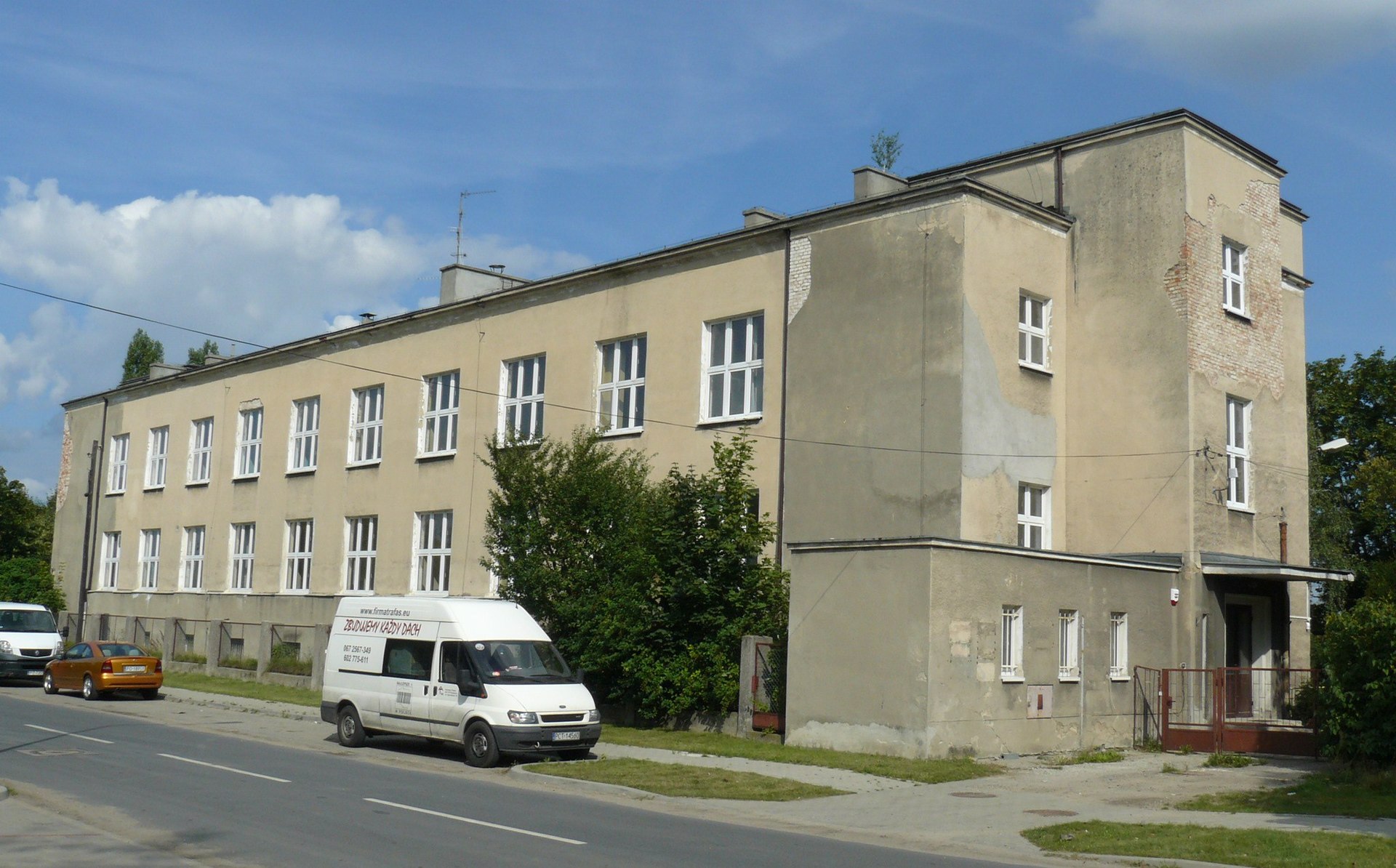 Shelter for homeless people in Poznan, Poland There are various places where a homeless person might seek refuge: 24-hour Internet cafes are now used by over 5,000 Japanese "Net cafe refugees". An estimated 75 percent of Japan's 3,200 all-night internet cafes cater to regular overnight guests, who in some cases have become their main source of income.[297] 24-hour McDonald's restaurants are used by "McRefugees" in Japan, China, and Hong Kong. There are about 250 McRefugees in Hong Kong.[298] Couch surfing: temporary sleeping arrangements in dwellings of friends or family members ("couch surfing"). This can also include housing in exchange for labor or sex. Couch surfers may be harder to recognize than street homeless people and are often omitted from housing counts.[299] Homeless shelters: including emergency cold-weather shelters opened by churches or community agencies, which may consist of cots in a heated warehouse, or temporary Christmas Shelters. More elaborate homeless shelters such as Pinellas Hope in Florida provide residents with a recreation tent, a dining tent, laundry facilities, outdoor tents, casitas, and shuttle services that help inhabitants get to their jobs each day.[300] Inexpensive boarding houses: have also been called flophouses. They offer cheap, low-quality temporary lodging. Inexpensive motels offer cheap, low-quality temporary lodging. However, some who can afford housing live in a motel by choice. For example, David and Jean Davidson spent 22 years at various U.K. Travelodges.[301] Public places: Parks, bus or train stations, public libraries, airports, public transportation vehicles (by continual riding where unlimited passes are available), hospital lobbies or waiting areas, college campuses, and 24-hour businesses such as coffee shops. Many public places use security guards or police to prevent people from loitering or sleeping at these locations for a variety of reasons, including image, safety, and comfort of patrons.[302][303] Shantytowns: ad hoc dwelling sites of improvised shelters and shacks, usually near rail yards, interstates and high transportation veins. Some shantytowns have interstitial tenting areas, but the predominant feature consists of hard structures. Each pad or site tends to accumulate roofing, sheathing, plywood, and nailed two-by-fours. Single room occupancy (more commonly abbreviated to SRO): a form of housing that is typically aimed at residents with low or minimal incomes who rent small, furnished single rooms with a bed, chair, and sometimes a small desk.[304] SRO units are rented out as permanent residence or primary residence[305] to individuals, within a multi-tenant building where tenants share a kitchen, toilets or bathrooms. In the 2010s, some SRO units may have a small refrigerator, microwave, and sink.[304] (also called a "residential hotel"). Squatting in an unoccupied structure where a homeless person may live without payment and the owner's knowledge or permission. Often these buildings are long abandoned and not safe to occupy. Tent cities: ad hoc campsites of tents and improvised shelters consisting of tarpaulins and blankets, often near industrial and institutionally zoned real estate such as rail yards, highways and high transportation veins. A few more elaborate tent cities, such as Dignity Village, are hybrids of tent cities and shantytowns. Tent cities frequently consist only of tents and fabric-improvised structures, with no semi-permanent structures at all. Outdoors: on the ground or in a sleeping bag, tent, or improvised shelter, such as a large cardboard box, under a bridge, in an urban doorway, in a park, or in a vacant lot. Tunnels such as abandoned subway, maintenance, or train tunnels are popular among long-term or permanent homeless people.[306][307] The inhabitants of such refuges are called in some places, like New York City, "Mole People". Natural caves beneath urban centers allow for places where people can congregate. Leaking water pipes, electric wires, and steam pipes allow for some of the essentials of living. Vehicles: cars or trucks used as temporary or sometimes long-term living quarters, for example by those recently evicted from a home. Some people live in recreational vehicles (RVs), school buses, vans, sport utility vehicles, covered pickup trucks, station wagons, sedans, or hatchbacks. The vehicular homeless, according to homeless advocates and researchers, comprise the fastest-growing segment of the homeless population.[308] Many cities have safe parking programs in which lawful sites are permitted at churches or in other out-of-the-way locations. For example, because it is illegal to park on the street in Santa Barbara, California, the New Beginnings Counseling Center worked with the city to make designated parking lots available to homeless people.[300] Other housing options Transitional housing provides temporary housing for certain segments of the homeless population, including the working homeless, and is meant to transition residents into permanent, affordable housing. This is usually a room or apartment in a residence with support services. The transitional time can be relatively short, for example, one or two years, and in that time the person must file for and obtain permanent housing along with gainful employment or income, even if Social Security or assistance. Sometimes transitional housing programs charge a room and board fee, maybe 30 percent of an individual's income, which is sometimes partially or fully refunded after the person procures a permanent residence. In the U.S., federal funding for transitional housing programs was originally allocated in the McKinney–Vento Homeless Assistance Act of 1986.[309][310][311] Foyers are a specific type of transitional housing designed for homeless or at-risk teens. Foyers are generally institutions that provide affordable accommodation as well as support and training services for residents. They were pioneered in the 1990s in the United Kingdom, but have been adopted in areas in Australia and the United States as well. Supportive housing is a combination of housing and services intended as a cost-effective way to help people live more stable, productive lives. Supportive housing works well for those who face the most complex challenges – individuals and families confronted with homelessness who also have very low incomes or serious, persistent issues such as substance use disorder, addictions, alcohol use disorder, mental illness, HIV/AIDS, or other serious challenges. A 2021 systematic review of 28 interventions, mostly in North America, showed that interventions with the highest levels of support led to improved outcomes for both housing stability, and health outcomes.[312] Government initiatives: In South Australia, the state government of Premier Mike Rann (2002–2011) committed substantial funding to a series of initiatives designed to combat homelessness. Advised by Social Inclusion Commissioner David Cappo and the founder of New York's Common Ground program, Rosanne Haggerty, the Rann government established Common Ground Adelaide,[313] building high-quality inner city apartments (combined with intensive support) for "rough sleeping" homeless people. The government also funded the Street to Home program and a hospital liaison service designed to assist homeless people admitted to the emergency departments of Adelaide's major public hospitals. Rather than being released back into homelessness, patients identified as rough sleepers were found accommodation backed by professional support. Common Ground and Street to Home now operate across Australia in other States.[314] |
避難所と代替施設 ポーランド、ポズナンのホームレスのためのシェルター ホームレスが避難する場所はさまざまだ: 24時間営業のネットカフェは、現在5,000人以上の日本の「ネットカフェ難民」が利用している。日本にある3,200の終夜営業のネットカフェのう ち、推定75%が常連の宿泊客に対応しており、彼らが主な収入源になっているケースもある[297]。 24時間営業のマクドナルド・レストランは、日本、中国、香港の「マック難民」によって利用されている。香港には約250人のマック難民がいる [298]。 カウチ・サーフィン:友人や家族の住居で一時的に寝泊まりすること(「カウチ・サーフィン」)。これには、労働やセックスと引き換えに住居を提供すること も含まれる。カウチサーファーは路上ホームレスよりも認識されにくい場合があり、住宅数のカウントから漏れることが多い[299]。 ホームレス・シェルター:教会や地域機関が開設する緊急の寒冷地用シェルターで、暖房の効いた倉庫に簡易ベッドを置いただけのものや、一時的なクリスマ ス・シェルターなどがある。フロリダ州のピネラス・ホープのような、より手の込んだホームレス・シェルターは、居住者にレクリエーション用テント、ダイニ ング用テント、ランドリー施設、屋外テント、カシータを提供し、居住者が毎日仕事に行くためのシャトルサービスも行っている[300]。 安価な下宿:フロフハウスとも呼ばれる。安価で質の低い一時的な宿泊施設を提供する。 安価なモーテルは、安価で質の低い一時的な宿泊施設を提供する。しかし、住居に余裕のある人の中には、自分の意志でモーテルに住む人もいる。例えば、デイ ヴィッドとジーン・デイヴィッドソン夫妻は、英国の様々なトラベルッジで22年間を過ごした[301]。 公共の場所: 公園、バスや鉄道の駅、公共図書館、空港、公共交通機関(乗り放題パスが利用できる場合は乗り続ける)、病院のロビーや待合室、大学のキャンパス、コー ヒーショップなどの24時間営業の店。多くの公共の場では、イメージ、安全性、利用者の快適さなど、さまざまな理由から、警備員や警察を使って、こうした 場所でのうろつきや睡眠を防止している[302][303]。 シャンティタウン(Shantytowns):即席のシェルターや掘っ立て小屋からなるその場しのぎの居住地で、通常、鉄道操車場、州間高速道路、交通の 要衝の近くにある。シャンティタウンのなかには、間にテントを張る場所もあるが、主な特徴は堅固な構造物からなることである。各パッドや敷地には、屋根 材、下地材、合板、釘打ちされたツーバイフォー材などが集積している傾向がある。 シングル・ルーム・タイプ(より一般的にはSROと略される):通常、低所得または最低限の所得しかない居住者を対象とした住宅の形態で、ベッド、椅子、 場合によっては小さな机が備わった、家具付きの小さなシングル・ルームを借りる[304]。SROのユニットは、キッチン、トイレ、またはバスルームを入 居者が共有するマルチテナント・ビル内で、永住用または主な住居[305]として個人に貸し出される。2010年代には、小型冷蔵庫、電子レンジ、流し台 を備えているSROユニットもある[304](「レジデンシャル・ホテル」とも呼ばれる)。 不法占拠(Squatting) 無人建築物において、ホームレスが支払いや所有者の認識や許可なしに居住すること。多くの場合、こうした建物は長い間放置されており、安全な場所ではな い。 テント村:テントや、防水シートや毛布でできた即席のシェルターで構成されるその場限りのキャンプ場で、鉄道駅や高速道路、交通の要衝など、工業用地や施 設用地の近くに設置されることが多い。ディグニティ・ヴィレッジのような、より手の込んだテント村は、テント村とシャントタウンのハイブリッドである。テ ント村は、テントや布製の仮設建築物だけで構成され、半永久的な建築物はまったくないことが多い。 屋外:地面の上、または寝袋、テント、大きな段ボール箱などの即席シェルター、橋の下、都市の出入り口、公園、空き地。 廃線になった地下鉄や整備工場、列車のトンネルなどのトンネルは、長期的または永続的なホームレスの間で人気がある[306][307]。このような避難 所の住人は、ニューヨークのような一部の場所では「モグラ人間」と呼ばれている。都市の中心部の地下にある自然の洞窟には、人々が集まる場所がある。漏水 している水道管、電線、蒸気管によって、生活に必要なものを確保することができる。 乗り物:車やトラックは、最近家を追い出された人などが、一時的な、あるいは時には長期的な住居として使用する。RV車、スクールバス、バン、スポーツ用 多目的車、幌付きピックアップトラック、ステーションワゴン、セダン、ハッチバックなどに住む人もいる。ホームレス擁護団体や研究者によると、自動車を利 用するホームレスは、ホームレス人口の中で最も急速に増加している層である[308]。多くの都市では、教会やその他の人目につかない場所に合法的な場所 を確保する安全駐車プログラムを実施している。例えば、カリフォルニア州サンタバーバラでは路上駐車が違法であるため、ニュー・ビギニングス・カウンセリ ング・センターが市と協力して、ホームレスの人々が利用できる駐車場を指定した[300]。 その他の住居の選択肢 トランジショナル・ハウジングは、働くホームレスを含む特定のホームレス層に一時的な住居を提供するもので、居住者を恒久的で手頃な価格の住居に移行させ ることを目的としている。これは通常、支援サービス付きの住居の一室またはアパートである。移行期間は比較的短く、例えば1年または2年で、その間に、社 会保障や扶助がある場合でも、有給の雇用または収入とともに、恒久的な住居を申請し、取得しなければならない。過渡的住居プログラムでは、部屋代と食事代 を請求されることがあり、その額は個人の収入の30%程度になることもあるが、永住権取得後に一部または全額が返金されることもある。米国では、1986 年のマッキニー・ヴェント・ホームレス支援法(McKinney-Vento Homeless Assistance Act of 1986)において、移行住宅プログラムに対する連邦政府の資金援助が元々割り当てられていた[309][310][311]。 フォイヤーは、ホームレスまたはリスクのある10代の若者のために設計された特定のタイプの移行住宅である。ホワイエは一般に、手頃な価格の宿泊施設であ ると同時に、居住者に支援や訓練サービスを提供する施設である。1990年代に英国で先駆的に導入されたが、オーストラリアや米国の地域でも採用されてい る。 サポーティブ・ハウジングは、住居とサービスを組み合わせたもので、人々がより安定した生産的な生活を送れるようにするための、費用対効果の高い方法であ る。支援型住宅は、最も複雑な課題に直面している人々、つまり、ホームレス状態に直面している個人や家族でありながら、収入が非常に低かったり、薬物使用 障害、依存症、アルコール使用障害、精神疾患、HIV/AIDSなどの深刻で持続的な問題を抱えていたり、その他の深刻な課題を抱えている人々にとって効 果的である。2021年に行われた、主に北米における28の介入策に関する系統的レビューによると、最高レベルの支援を伴う介入策は、住居の安定と健康上 の転帰の両方において、転帰の改善につながったことが示されている[312]。 政府の取り組み 南オーストラリア州では、マイク・ラン州首相(2002年~2011年)の州政府が、ホームレス対策を目的とした一連の取り組みに多額の資金を投入した。 ラン州政府は、社会的包摂委員会のデビッド・カッポ(David Cappo)とニューヨークのコモン・グラウンド・プログラムの創設者であるロザンヌ・ハガティ(Rosanne Haggerty)の助言を受け、コモン・グラウンド・アデレード(Common Ground Adelaide)を設立し[313]、「ラフ・スリーピング」状態にあるホームレスのために(集中的な支援と組み合わせた)質の高い都心のアパートを建 設した。政府はまた、Street to Homeプログラムと、アデレードの主要公立病院の救急部門に収容されたホームレスの人々を支援するための病院連絡サービスにも資金を提供した。ラフ・ス リーパーと認定された患者は、ホームレスに戻されるのではなく、専門家のサポートを受けながら住居を見つけることができた。コモン・グラウンドとストリー ト・トゥ・ホームは現在、オーストラリア全土の他の州で運営されている[314]。 |
| Assistance and resources Main article: Homelessness services Further information: List of homelessness organizations Most countries provide a variety of services to assist homeless people. Provisions of food, shelter, and clothing may be organized and run by community organizations, often with the help of volunteers, or by government departments. Assistance programs may be supported by the government, charities, churches, and individual donors. However, not all homeless people can access these resources. In 1998, a study by Koegel and Schoeni of a homeless population in Los Angeles, California, found that a significant minority of homeless did not participate in government assistance programs, with high transaction costs being a likely contributing factor.[315] Social supports See also: Wall of kindness While some homeless people are known to have a community with one another,[316] providing each other various types of support,[317] people who are not homeless also may provide them friendship, relational care, and other forms of assistance. Such social support may occur through a formal process, such as under the auspices of a non-governmental organization, religious organization, or homeless ministry, or may be done on an individual basis. Income Employment The United States Department of Labor has sought to address one of the main causes of homelessness, a lack of meaningful and sustainable employment, through targeted training programs and increased access to employment opportunities that can help homeless people develop sustainable lifestyles.[318] This has included the development of the United States Interagency Council on Homelessness, which addresses homelessness on the federal level in addition to connecting homeless individuals to resources at the state level.[319] All individuals who are in need of assistance are able, in theory, to access employment and training services under the Workforce Investment Act (WIA), although this is contingent upon funding and program support by the government.[318] Income sources outside of regular employment Waste management Homeless people can also use waste management services to earn money. Some homeless people find returnable bottles and cans and bring them to recycling centers to earn money. They can sort out organic trash from other trash or separate out trash made of the same material (for example, different types of plastics, and different types of metal). In addition, rather than picking waste at landfills, they can also collect litter found on/beside the road to earn an income.[320] Street newspapers 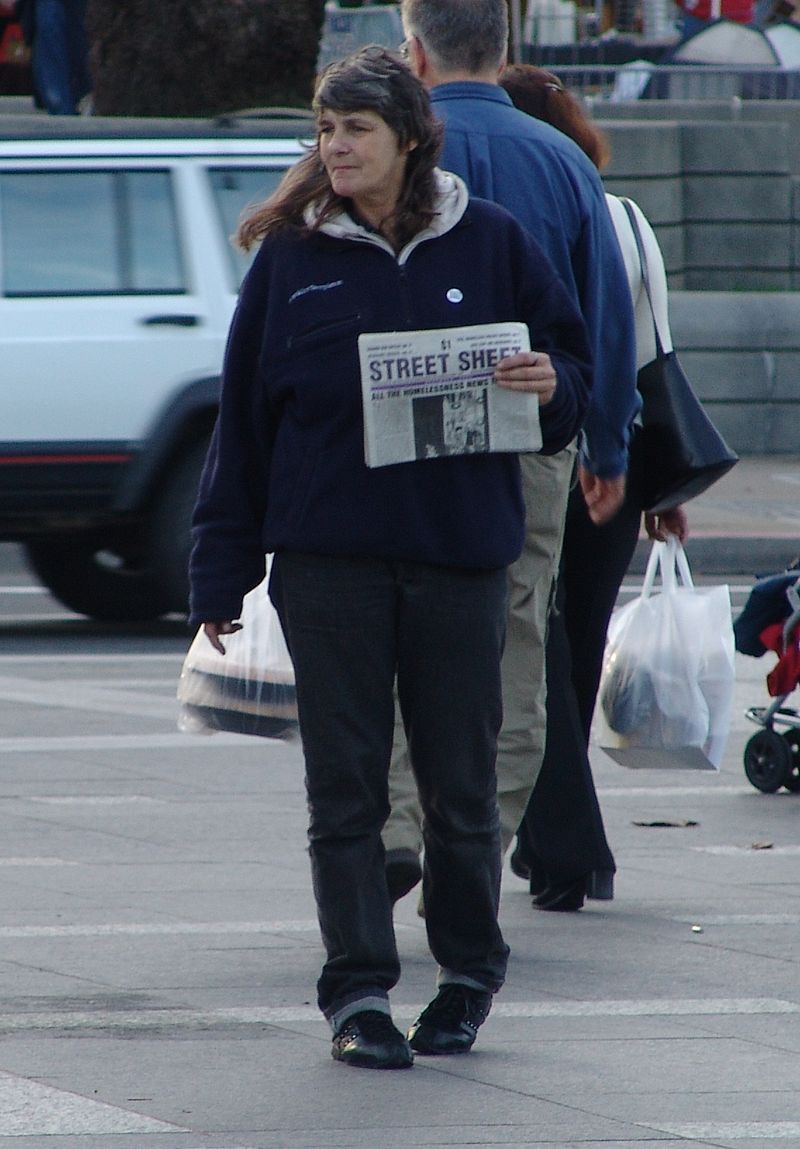 A street newspaper vendor, selling Street Sheet, in San Francisco, United States Main article: Street newspaper Street newspapers are newspapers or magazines sold by homeless or poor individuals and produced mainly to support these populations. Most such newspapers primarily provide coverage of homelessness and poverty-related issues and seek to strengthen social networks within homeless communities, making them a tool for allowing homeless individuals to work.[321] Medicine The 2010 passage of the Patient Protection and Affordable Care Act could provide new healthcare options for homeless people in the United States, particularly through the optional expansion of Medicaid. A 2013 Yale study indicated that a substantial proportion of the chronically homeless population in America would be able to obtain Medicaid coverage if states expanded Medicaid under the Affordable Care Act.[322] In 1985, the Boston Health Care for the Homeless Program was founded to assist the growing numbers of homeless people living on the streets and in shelters in Boston who were suffering from a lack of effective medical services.[323][324] In 2004, Boston Health Care for the Homeless in conjunction with the National Health Care for the Homeless Council published a medical manual called The Health Care of Homeless Persons, edited by James J. O'Connell, M.D., specifically for the treatment of the homeless population.[325] In June 2008 in Boston, the Jean Yawkey Place, a four-story, 7,214.2-square-metre (77,653 sq ft) building, was opened by the Boston Health Care for the Homeless Program. It is an entire full-service building on the Boston Medical Center campus dedicated to providing healthcare for homeless people. It also contains a long-term care facility, the Barbara McInnis House, which expanded to 104 beds and is the first and largest medical respite program for homeless people in the United States.[326][327][328] In Los Angeles, a collaboration between the Ostrow School of Dentistry of the University of Southern California and the Union Rescue Mission shelter offers homeless people in the Skid Row area free dental services.[329] Studies on the effects of intensive mental health interventions have demonstrated some improvements in housing stability and to be economically beneficial on cost-analysis.[330] Housing Permanent supportive housing (PSH) interventions appear to have improvements in housing stability for people living with homelessness even in the long term.[331][330] Savings from housing homeless in the US In 2013, a Central Florida Commission on Homelessness study indicated that the region spends $31,000 a year per homeless person to cover "salaries of law enforcement officers to arrest and transport homeless individuals – largely for nonviolent offenses such as trespassing, public intoxication or sleeping in parks – as well as the cost of jail stays, emergency room visits and hospitalization for medical and psychiatric issues. This did not include "money spent by nonprofit agencies to feed, clothe and sometimes shelter these individuals". In contrast, the report estimated the cost of permanent supportive housing at "$10,051 per person per year" and concluded that "[h]ousing even half of the region's chronically homeless population would save taxpayers $149 million over the next decade – even allowing for ten percent to end up back on the streets again." This particular study followed 107 long-term-homeless residents living in Orange, Osceola, and Seminole Counties.[332] Similar studies are showing large financial savings in Charlotte, North Carolina, and southeastern Colorado from focusing on simply housing homeless people.[333] In general, housing interventions had mixed economic results in cost-analysis studies.[330] Innovative solutions Los Angeles, California conducted a competition promoted by Mayor Eric Garcetti soliciting ideas from developers to use bond money more efficiently in building housing for the city's homeless population. The top five winners were announced on 1 February 2019 and the concepts included using assembly-ready molded polymer panels that can be put together with basic tools, prefabricated 5-story stack-able houses, erecting privately financed modular buildings on properties that do not require City Council approval, using bond money to convert residential garages into small apartments which are then dedicated to homeless rentals, and the redeveloping of Bungalow-court units, the small low-income iconic buildings that housed seven percent of the city's population in the 1920s.[334] In the neighborhood of Westlake, Los Angeles, the city is funding the first transitionally homeless housing building using "Cargotecture", or "architecture built from repurposed shipping containers." The Hope on Alvarado micro-apartment building will consist of four stories of 84 containers stacked together like Lego bricks on top of a traditionally constructed ground floor. Completion is anticipated by the end of 2019.[335] Political action Voting for elected officials is important for the population of homeless people to have a voice in the democratic process.[336] There are also many community organizations and social movements around the world which are taking action to reduce homelessness. They have sought to counteract the causes and reduce the consequences by starting initiatives that help homeless people transition to self-sufficiency. Social movements and initiatives tend to follow a grassroots, community-based model of organization – generally characterized by a loose, informal, and decentralized structure, with an emphasis on radical protest politics. By contrast, an interest group aims to influence government policies by relying on more of a formal organizational structure.[336] These groups share a common element: they are both made up of and run by a mix of allies of the homeless population and former or current members of the homeless population. Both grassroots groups and interest groups aim to break stereotyped images of homeless people as being weak and hapless, or defiant criminals and drug addicts, and to ensure that the voice of homeless people and their representatives are heard by policymakers. Organizing in homeless shelters Homeless shelters can become grounds for community organization and the recruitment of homeless individuals into social movements for their cause. Cooperation between the shelter and an elected representative from the homeless community at each shelter can serve as the backbone of this type of initiative. The representative presents and forwards problems raises concerns and provides new ideas to the director and staff of the shelters. Examples of possible problems are ways to deal with substance use disorders by certain shelter users, and the resolution of interpersonal conflicts. SAND, the Danish National Organization for Homeless People, is one example of an organization that uses this empowerment approach.[337] Issues reported at the homeless shelters are then addressed by SAND at the regional or national level. To open further dialogue, SAND organizes regional discussion forums where staff and leaders from the shelters, homeless representatives, and local authorities meet to discuss issues and good practices at the shelters.[336] Veteran specific Main article: Homeless veterans in the United States 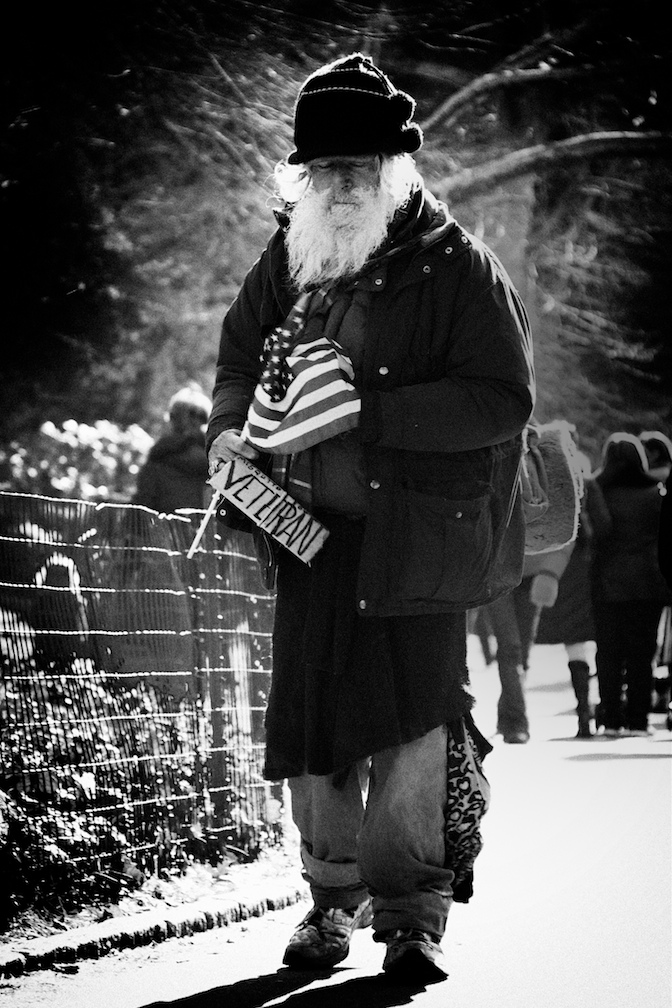 Homeless veteran man in New York United States Many homeless organizations support homeless veterans, an issue most commonly seen in the United States.[338][339] Non-governmental organizations house or redirect homeless veterans to care facilities. Social Security Income/Social Security Disability Income, Access, Outreach, Recovery Program (SOAR) is a national project funded by the Substance Abuse and Mental Health Services Administration. It is designed to increase access to SSI/SSDI for eligible adults who are homeless or at risk of becoming homeless and have a mental illness or a co-occurring substance use disorder. Using a three-pronged approach of Strategic Planning, Training, and Technical Assistance (TA), the SOAR TA Center coordinates this effort at the state and community level.[340] The United States Department of Housing and Urban Development and Veterans Administration have a special Section 8 housing voucher program called VASH (Veterans Administration Supported Housing), or HUD-VASH, which gives out a certain number of Section 8 subsidized housing vouchers to eligible homeless and otherwise vulnerable US armed forces veterans.[341] The HUD-VASH program has shown success in housing many homeless veterans.[342] The support available to homeless veterans varies internationally, however. For example, in England, where there is a national right to housing, veterans are only prioritized by local authority homelessness teams if they are found to be vulnerable due to having served in the Armed Forces.[343] Under the Department of Labor, the Veterans' Employment and Training Service (VETS) offers a variety of programs targeted at ending homelessness among veterans.[318] The Homeless Veterans Reintegration Program (HVRP) is the only national program that is exclusively focused on assisting veterans as they reenter the workforce.[318] The VETS program also has an Incarcerated Veterans' Transition Program, as well as services that are unique to female Veterans.[318] Mainstream programs initiated by the Department of Labor have included the Workforce Investment Act, One-Stop Career Centers, and a Community Voice Mail system that helps to connect homeless individuals around the United States with local resources.[344] Targeted labor programs have included the Homeless Veterans Reintegration Project, the Disability Program Navigator Initiative, efforts to end chronic homelessness through providing employment and housing projects, Job Corps, and the Veterans Workforce Investment Program (VWIP).[344] |
支援とリソース 主な記事 ホームレス支援サービス さらに詳しい情報 ホームレス支援団体一覧 ほとんどの国では、ホームレスの人々を支援するために様々なサービスを提供している。食料、シェルター、衣料品の提供は、地域団体(多くの場合、ボラン ティアの協力を得て)、または政府部門によって組織・運営されている。支援プログラムは、政府、慈善団体、教会、個人の寄付によって支えられている場合も ある。しかし、すべてのホームレスがこうした資源を利用できるわけではない。1998年、KoegelとSchoeniがカリフォルニア州ロサンゼルスの ホームレス人口を調査したところ、政府の支援プログラムに参加しないホームレスはかなり少数派であり、取引コストが高いことが一因である可能性が高いこと がわかった[315]。 社会的支援 以下も参照: 優しさの壁 ホームレス同士がコミュニティを形成し[316]、様々な支援を提供し合っていることが知られているが[317]、ホームレスではない人々もまた、彼らに 友情、関係性のケア、その他の形態の支援を提供している場合がある。このような社会的支援は、非政府組織、宗教団体、ホームレスの聖職の支援など、正式な プロセスを通じて行われる場合もあれば、個人単位で行われる場合もある。 収入 雇用 米国労働省は、ホームレスの主な原因のひとつである、有意義で持続可能な雇用の欠如に対処するため、的を絞った訓練プログラムを実施し、ホームレスの人々 が持続可能なライフスタイルを築けるような雇用機会へのアクセスを増やそうとしている。 [318]これには、ホームレスの個人を州レベルの資源につなげることに加えて、連邦レベルでホームレス問題に取り組む米国ホームレス問題省庁間協議会 (United States Interagency Council on Homelessness)の発展が含まれる[319]。支援を必要とするすべての個人は、理論的には、政府による資金とプログラムの支援に左右されるも のの、労働力投資法(WIA)の下で雇用と訓練のサービスを利用することができる[318]。 通常の雇用以外の収入源 廃棄物処理 ホームレスの人々は、廃棄物処理サービスを利用して収入を得ることもできる。ホームレスの中には、リターナブルびんや缶を見つけてリサイクル・センターに 持ち込み、収入を得る人もいる。彼らは、有機ゴミとその他のゴミを分別したり、同じ素材のゴミ(例えば、異なる種類のプラスチックと異なる種類の金属)を 分別したりすることができる。さらに、埋立地でゴミを拾うのではなく、道路上や道路脇のゴミを集めて収入を得ることもできる[320]。 ストリート新聞  アメリカ、サンフランシスコでストリート・シートを売る路上新聞売り。 主な記事 ストリート新聞 ストリート新聞とは、ホームレスや貧困層が販売する新聞や雑誌のことで、主にこれらの人々を支援するために作られる。このような新聞の多くは、主にホーム レスや貧困に関連する問題を報道し、ホームレス・コミュニティ内の社会的ネットワークを強化しようとするもので、ホームレスが働くためのツールとなってい る[321]。 医療 2010年に成立した「患者の保護と医療費負担の軽減に関する法律(Patient Protection and Affordable Care Act)」は、特にメディケイドの任意拡大を通じて、米国のホームレスの人々に新たな医療の選択肢を提供する可能性がある。2013年のイェール大学の研 究によると、アフォーダブル・ケア法に基づいて各州がメディケイドを拡大した場合、アメリカの慢性的なホームレス人口のかなりの割合がメディケイドの適用 を受けられるようになると指摘されている[322]。 1985年、ボストン・ヘルスケア・フォー・ザ・ホームレス・プログラムは、ボストンの路上やシェルターで生活するホームレスの数が増加し、効果的な医療 サービスの欠如に苦しんでいる人々を支援するために設立された[323][324]。2004年、ボストン・ヘルスケア・フォー・ザ・ホームレス・プログ ラムは、全米ホームレス医療協議会と共同で、ジェームズ・J・オコネル医学博士が編集した『ホームレスの医療』という医療マニュアルを出版した、 325]2008年6月、ボストンでは、ホームレスのためのボストン医療プログラムによって、4階建て、7,214.2平方メートル(77,653平方 フィート)の建物であるジーン・ヨーキー・プレイスがオープンした。ボストン・メディカル・センター・キャンパス内にある、ホームレスの人々のためのヘル スケアに特化したフルサービスの建物である。また、長期療養施設であるバーバラ・マクニスハウスも併設されており、104床まで拡張されたこの施設は、 ホームレスのための医療レスパイト・プログラムとしては米国初で最大のものである[326][327][328]。 ロサンゼルスでは、南カリフォルニア大学オストロー歯学部とユニオン・レスキュー・ミッション・シェルターが協力して、スキッドロウ地区のホームレスの人 々に無料の歯科サービスを提供している[329]。 集中的なメンタルヘルス介入の効果に関する研究では、住居の安定性がある程度改善し、費用分析上も経済的に有益であることが実証されている[330]。 住宅 恒久的支援住宅(PSH)への介入は、長期的にみてもホームレス状態にある人々の住居の安定性を改善するようである[331][330]。 米国におけるホームレス収容による節約 2013年、フロリダ州中部ホームレス対策委員会の調査によると、同地域ではホームレス1人あたり年間31,000ドルを費やしており、その内訳は「ホー ムレス(主に不法侵入、公共での酩酊、公園での寝泊まりなど非暴力犯罪)を逮捕・移送するための法執行官の給与、刑務所での滞在費、緊急外来への受診費、 医療・精神疾患による入院費」である。これには、「これらの人々を養い、衣服を着せ、時には保護するために非営利団体が費やした費用」は含まれていない。 対照的に、報告書は恒久的支援住宅のコストを「一人当たり年間10,051ドル」と見積もり、「地域の慢性的ホームレス人口の半分でも収容すれば、今後 10年間で1億4,900万ドルの税金を節約できる。この特別な研究は、オレンジ郡、オセオラ郡、セミノール郡に住む107人の長期ホームレス住民を追跡 調査したものである[332]。同様の研究は、ノースカロライナ州シャーロットやコロラド州南東部でも、単にホームレスの住居を確保することに注力するこ とで、大きな財政節約効果があることを示している[333]。 一般的に、住宅への介入は、コスト分析研究において様々な経済的結果を示している[330]。 革新的な解決策 カリフォルニア州ロサンゼルス市では、エリック・ガルセッティ市長の推進により、同市のホームレス人口のための住宅建設に債券資金をより効率的に使用する ためのアイデアを開発業者から募るコンペティションが実施された。上位5人の受賞者は2019年2月1日に発表され、そのコンセプトには、基本的な工具で 組み立てることができる組み立て式の成型ポリマーパネル、プレハブ式の5階建ての積み重ね可能な住宅、市議会の承認を必要としない物件に民間資金でモ ジュール化された建物を建てること、債券資金を使って住宅のガレージを小さなアパートに改築し、それをホームレスの賃貸住宅に充てること、1920年代に 市の人口の7パーセントを収容していた低所得者向けの象徴的な小さな建物であるバンガローコートのユニットの再開発などが含まれていた[334]。 ロサンゼルスのウェストレイク地区では、「カーゴテクチャー」、つまり「輸送用コンテナを再利用して建築された建築物」を使用した初の移行型ホームレス住 宅に市が資金を提供している。ホープ・オン・アルバラド・マイクロアパートメント・ビルは、伝統的な構造の1階部分の上に、84個のコンテナをレゴブロッ クのように積み上げた4階建てで構成される。完成は2019年末を予定している[335]。 政治活動 選挙で選ばれた議員に投票することは、ホームレスの人々が民主的なプロセスにおいて発言権を持つために重要である[336]。 また、ホームレスの減少のために行動を起こしているコミュニティ組織や社会運動は世界中に数多く存在する。彼らは、ホームレスの人々が自給自足に移行でき るような取り組みを始めることで、その原因に対抗し、その結果を軽減しようとしている。社会運動やイニシアチブは、草の根的で地域に根ざした組織モデルを とる傾向がある。一般的に、緩やかで非公式、分散化された構造を特徴とし、急進的な抗議政治を重視する。対照的に、利益団体は、より正式な組織構造に頼る ことで、政府の政策に影響を与えることを目的としている[336]。これらの団体には共通する要素がある。それは、ホームレスの人々の味方や、元ホームレ スや現ホームレスが混在して構成され、運営されているということである。草の根団体も利益団体も、ホームレスの人々は弱く無様であるとか、反抗的な犯罪者 や薬物中毒者であるといった固定観念を打ち破り、ホームレスの人々とその代表者の声を政策立案者に確実に届けることを目的としている。 ホームレス・シェルターでの組織化 ホームレス・シェルターは、地域社会を組織化し、ホームレスの人々をその大義のための社会運動に参加させる場となりうる。シェルターと、各シェルターの ホームレス・コミュニティから選出された代表者との協力は、この種のイニシアチブのバックボーンとして機能する。代表者は、シェルターの所長やスタッフに 問題を提示し、懸念を伝え、新しいアイデアを提供する。例えば、特定のシェルター利用者による薬物使用障害への対処法や、対人関係の対立の解決などであ る。デンマークのホームレスのための全国組織であるSANDは、このエンパワーメント・アプローチを採用している組織の一例である[337]。さらに対話 を深めるために、SANDは地域ディスカッション・フォーラムを開催し、シェルターのスタッフやリーダー、ホームレスの代表者、地方自治体が集まり、シェ ルターにおける問題や優れた実践について議論している[336]。 退役軍人に特化した活動 主な記事 米国のホームレス退役軍人  ニューヨークのホームレス退役軍人の男性(米国) 多くのホームレス団体がホームレスの退役軍人を支援しており、これは米国で最もよく見られる問題である[338][339]。 非政府組織はホームレスの退役軍人を収容したり、介護施設に向かわせたりしている。社会保障所得/社会保障障害所得、アクセス、アウトリーチ、回復プログ ラム(SOAR)は、薬物乱用・精神衛生サービス庁が資金を提供する国家プロジェクトである。ホームレスまたはホームレスになる恐れがあり、精神疾患また は薬物使用障害を併発している成人のSSI/SSDIへのアクセスを向上させることを目的としている。SOAR TAセンターは、戦略的計画、訓練、技術支援(TA)という3つの柱からなるアプローチを用いて、この取り組みを州や地域レベルで調整している [340]。 米国住宅都市開発省と退役軍人管理局は、VASH(退役軍人管理局支援住宅)、またはHUD-VASHと呼ばれる特別なセクション8住宅バウチャー・プロ グラムを持っており、資格のあるホームレスの退役軍人やその他の弱い立場にある米軍退役軍人に、一定数のセクション8補助住宅バウチャーを提供している [341]。例えば、国家的な住宅への権利があるイギリスでは、退役軍人は、軍隊に所属していたために脆弱であると認められた場合にのみ、地方自治体の ホームレス支援チームによって優先的に収容される[343]。 労働省のもと、退役軍人雇用訓練局(VETS)は、退役軍人のホームレス状態を解消することを目的とした様々なプログラムを提供している[318]。ホー ムレス退役軍人再統合プログラム(HVRP)は、退役軍人の再就職支援に特化した唯一の全国的プログラムである[318]。VETSプログラムには、女性 退役軍人に特化したサービスだけでなく、投獄退役軍人移行プログラムもある。 [労働省が開始した主流プログラムには、労働力投資法、ワンストップ・キャリアセンター、全米のホームレス個人を地域の資源につなげるコミュニティ・ボイ スメール・システムなどがある[344]。的を絞った労働プログラムには、ホームレス退役軍人の社会復帰プロジェクト、障害者プログラム・ナビゲーター・ イニシアチブ、雇用と住宅プロジェクトの提供を通じて慢性的ホームレス状態を終わらせる取り組み、ジョブ・コープス、退役軍人労働力投資プログラム (VWIP)などがある[344]。 |
Popular culture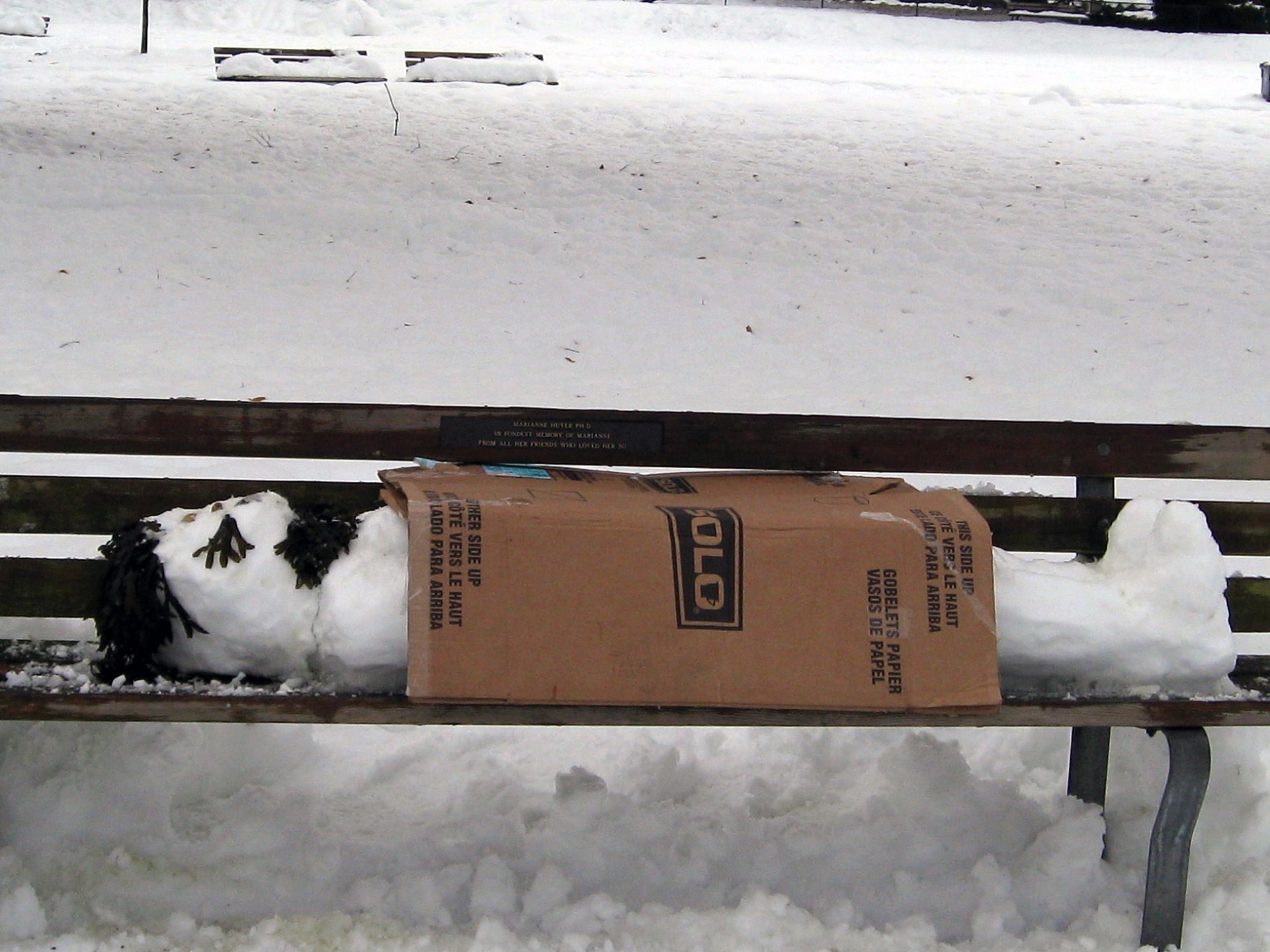 A street bench in Kitsilano, British Columbia, Canada, with a snowman depicting a homeless person Homelessness is frequently described as an invisible problem,[345] despite its prevalence.[346] Writers and other artists play a role in bringing the issue to public attention. Homelessness is the central theme of many works; in other works homelessness is secondary, added to advance the story or contribute to dramatic effect. Homelessness is the central subject in most of the works of art listed here. Films Little Tramp, Chaplin provides light-hearted humor through lovable personalities. Fred Glass writes the social type of Chaplin's character represented was familiar and emotionally appealing. One account given is that Chaplin based his character on a man whom he had met in San Francisco in 1914.[347] Modern Times, a 1936 film, shows the negative effects of vagrancy laws. Cathy Come Home, 1966, shows the effects of homelessness on parenthood. God Bless the Child, 1988, a made-for-TV movie about single mother (Mare Winningham) living on the streets of New York City with her young daughter. Homeless Sam & Sally, a 2020 dark comedy film and television series with the same name released in 2019, is story about a mother named Sally Silver and her mentally ill son Sam Silver who comes up with ways to live normal lives while being homeless in Koreatown, Los Angeles. Dark Days, 2000, a documentary by Marc Singer, who followed the lives of people living in the Freedom Tunnel, an Amtrak tunnel in New York City. Homeless to Harvard: The Liz Murray Story, a 2003 film about a homeless girl, Liz Murray, who works her way up to admission to Harvard University. 66 Months, a 2011 British documentary film about a homeless man who makes it on his own for six years without any government programs helping him. The Pursuit of Happyness, a 2006 biographical film where a father and son get a job and end up homeless after an eviction and later a tax garnishment. After several weeks living from place to place in 1981 San Francisco, he lands a permanent position in a brokerage firm after completing an unpaid internship. Same Kind of Different as Me, a 2017 American film about a successful art dealer, his wife, and an initially violent member of a homeless shelter community. It is based on the 2006 book of the same name. Curly Sue, a 1991 comedy-drama that focuses on a homeless con artist and his friend who gets lucky with a roof over their heads by tricking a wealthy attorney. Life Stinks, a 1991 comedy about a wealthy businessman who bets a corporate rival that he can live his life as a homeless man, but finds out later on in the story that being homeless is not easy or fun. The Saint of Fort Washington, a 1993 drama where a homeless disabled man gets guidance from a friendly veteran as they cope with the realities of living on the streets. Documentaries 1978. The Agony of Jimmy Quinlan is a National Film Board documentary about homeless alcoholics in Montreal (video online in full). 1984. Streetwise—follows homeless Seattle youth. 1993. It Was a Wonderful Life at IMDb Edit this at Wikidata—chronicles the lives of six articulate, educated, "hidden homeless" women as they struggle from day to day. Narrated by Jodie Foster. 1997. The Street: A Film with the Homeless about the Canadian homeless in Montreal. New York Times Review, 2000. Dark Days—A film following the lives of homeless adults living in the Amtrak tunnels in New York. 2001. Children Underground—Following the lives of homeless children in Bucharest, Romania. 2002. Bumfights—Documentary series criticized as exploitative, mondo films 2003. À Margem da Imagem at IMDb Edit this at Wikidata—about the homeless in São Paulo, Brazil. Its English title is "On the Fringes of São Paulo: Homeless". 2004. Homeless in America at IMDb Edit this at Wikidata 2005. The Children of Leningradsky—About homeless children in Moscow. 2005. Reversal of Fortune—A homeless person is given $100,000 and is free to do whatever he wishes with the money. 2006. Homeless—About Homeless people and homelessness in England. 2007. Easy Street—about the homeless in St. Petersburg, Florida. 2008. The Oasis—an observational documentary about homeless youths in Sydney, Australia, filmed over two years. 2008. Carts of Darkness is a documentary by Murray Siple about extreme shopping cart racing by homeless men. (Video online in full.) 2008. - "Centered on the troubled friendship between Robert and Harvey, the film exposes the unique hardships and common humanity of people who live among us but are virtually unknown."[348] Songs 1915. "Those Charlie Chaplin feet" by Edgar Leslie and Archie Gottler.[349] 1930. "Singing a Vagabond Song" by Harry Richman, Val Burton and Sam Messenheimer.[350] 1987. "Day-In Day-Out" by David Bowie.[351] The song was written about the treatment of the homeless in the US, and the video, which was shot in Los Angeles,[352] was nominated for a 1987 MTV Video Music award in the category of "Best Male Video".[353] 1991. Something in the Way, music by Nirvana, written by Kurt Cobain when he was young, homeless and sleeping under a bridge at the age of fifteen.[354][355] Popular music albums 2007. Give US Your Poor. It has 17 recordings to help end homelessness with artists such as Jon Bon Jovi, Natalie Merchant, Pete Seeger, Bruce Springsteen, Sonya Kitchell, Bonnie Raitt, and actors Danny Glover and Tim Robbins.[356] TV and radio Documentaries 1977. Underneath the Arches, a ground-breaking documentary produced by Owen Spencer-Thomas on BBC Radio London in which London's homeless people were enabled to tell their own stories. 1988. Home Sweet Homeless at IMDb Edit this at Wikidata—a CBS Schoolbreak Special about a mother and her son who find themselves having to live in their car. Entertainment and comedy 1951–1971. The Red Skelton Show features Freddie the Freeloader, played by Red Skelton. 1951. An episode entitled "The Quiz Show" of I Love Lucy features Lucy (played by Lucille Ball), who in order to win $1,000 has to trick her husband, Ricky (played by Desi Arnaz), that she has a long lost previous husband. Harold the Tramp (played by John Emery) is mistaken by Lucy for the actor hired by the game show producers. 1961. An episode entitled "Opie's Hobo Friend" of the second season of The Andy Griffith Show deals with Opie's (played by Ron Howard) friendship with an immoral homeless individual, David Browne (played by Buddy Ebsen). 1963. An episode entitled "Beaver's Good Deed" of the sixth season of "Leave it to Beaver" features Beaver (played by Jerry Mathers) who befriends and cares for a homeless individual, Jeff (played by Frank Ferguson), while his parents are away. 1972. An episode entitled "The Show Must Go On??" of the fourth season of The Brady Bunch features the mom, Carol (Florence Henderson), and her daughter, Marcia (Maureen McCormick), play two homeless individuals, as they sing "Together (Wherever We Go)." 1977. "The Easter Bunny Is Comin' to Town" features Hallelujah Jones who is a lovable tramp who befriends Sunny and suggests that he sell his eggs in a town called Town. 1987. "Brother, Can You Spare A Dime", of the sitcom, Kate & Allie, Allie gets stranded in the north end of Manhattan and has to make it back to Greenwich Village with no money. At one point, Allie asks herself where homeless people go to the bathroom. The episode ends with a special tribute to the homeless. 1991. "The Library" of the sitcom, Seinfeld, surrounds itself on George's former teacher, Mr. Heyman, whom he learns became homeless. 2002. Released in March, SpongeBob SquarePants episode “Can You Spare a Dime?” is about Squidward Tentacles' temporary state of homelessness and living with SpongeBob until he gets his job back at the Krusty Krab. 2007. "Night of the Living Homeless" was an episode that appeared on Comedy Central's South Park. It was first broadcast on April 18, 2007. Theater 1728. The Beggar's Opera, a play by John Gay . 1902. The Lower Depths, a play by Maxim Gorky, inspired by the residents of a Nizhny Novgorod homeless shelter. 1985. Stinkfoot, a Comic Opera—a musical which includes the homeless Mrs. Bag Bag. Books  A homeless man in Paris Fiction 1853. Bleak House by Charles Dickens. 1905. "The Cop and the Anthem" (short story) by O. Henry. 1983. Ironweed by William Kennedy. 1993. Stone Cold by Robert Swindells. 1996. Junk by Melvin Burgess. 2010. Street Logic by Steve Sundberg, Bookstand Publishing, 2010. ISBN 978-1-58909-680-6 Nonfiction 1907. Tramping with Tramps by Josiah Flynt.[357] 1933. Down and Out in Paris and London by George Orwell. 1998. The homeless in Paris: a representative sample survey of users of services for the homeless, in Dragana Avramov, ed, Coping with homelessness : issues to be tackled and best practices in Europe, Ashgate Publishing, by Maryse Marpsat and Jean-Marie Firdion. 2005. Without a Net: Middle Class and Homeless (With Kids) in America by Michelle Kennedy. 2005. The Glass Castle: A Memoir by Jeannette Walls. ISBN 0-7432-4753-1 2005. Under the Overpass: A Journey of Faith on the Streets of America by Mike Yankoski. Visual arts 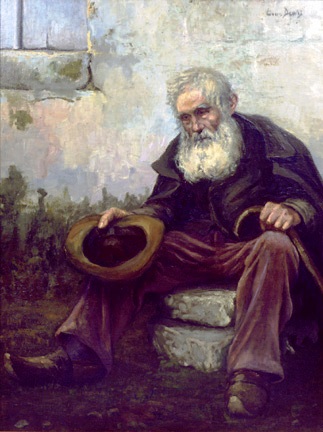 "Old Beggar" by Louis Dewis, 1916 1568. "The Beggars" by Pieter Bruegel the Elder. 17th-Century. Woodcarved beggars by various Italian woodcarvers. 1856. The Blind Girl by John Everett Millais. 2005. Photographic expose by Michel Mersereau entitled "Between The Cracks". Jesus the Homeless See also Ghost town repopulation Grave dwellers Homeless Jesus, a bronze sculpture by Canadian sculptor Timothy Schmalz depicting Jesus as a homeless person sleeping on a park bench, which since 2013 has been installed in many places across the world Hunter-gatherers Internally displaced person Nomads Right to housing |
大衆文化 ホームレスの雪だるまが描かれたカナダ、ブリティッシュコロンビア州キツラノにある路上のベンチ ホームレス問題は、その蔓延にもかかわらず、目に見えない問題[345]としてしばしば語られる。ホームレスは多くの作品の中心的なテーマであり、他の作 品ではホームレスは二次的なもので、物語を進展させたり、劇的な効果をもたらすために付け加えられる。ここに挙げた芸術作品の多くでは、ホームレス問題が 中心的なテーマとなっている。 映画 リトル・トランプ』チャップリンは、愛すべき個性を通して軽快なユーモアを提供する。フレッド・グラスは、チャップリンが表現したキャラクターの社会的な タイプは、身近で感情的に訴えかけるものだったと書いている。チャップリンは、1914年にサンフランシスコで出会った人物をモデルにしたという証言もあ る[347]。 1936年の映画『モダン・タイムス』は、浮浪者法の弊害を示している。 Cathy Come Home』(1966年)は、ホームレスが子育てに与える影響を描いている。 1988年の『God Bless the Child』は、幼い娘とニューヨークの路上で暮らすシングルマザー(メア・ウィニンガム)を描いたテレビ映画。 2020年公開のダークコメディ映画『Homeless Sam & Sally』と2019年公開の同名のテレビシリーズ『Homeless Sam & Sally』は、ロサンゼルスのコリアンタウンでホームレス生活を送りながら、普通の生活を送る方法を考え出す母親サリー・シルバーと精神疾患の息子サ ム・シルバーの物語である。 マーク・シンガーによるドキュメンタリー『Dark Days』(2000年)は、ニューヨークにあるアムトラックのトンネル、フリーダム・トンネルで暮らす人々の生活を追った。 ホームレスからハーバードへ: 2003年、ホームレスの少女リズ・マーレイがハーバード大学に入学するまでの道のりを描いた映画。 66 Months』:2011年のイギリスのドキュメンタリー映画で、政府の援助なしに6年間自力で生きてきたホームレスの男性を描く。 2006年の伝記映画『幸せの追求』では、父と息子が仕事を見つけ、立ち退きとその後の税金差し押さえの後にホームレスになる。1981年のサンフランシ スコで数週間あちこちを転々とした後、無給のインターンシップを終え、証券会社で正社員の職を得る。 2017年のアメリカ映画『セイム・カインド・オブ・ディファレント・アズ・ミー』は、成功した画商とその妻、そしてホームレス・シェルター・コミュニ ティの当初暴力的だったメンバーを描いている。2006年に出版された同名の本が原作。 1991年のコメディドラマ『カーリー・スー』。ホームレスの詐欺師とその友人が、裕福な弁護士を騙して屋根を手に入れ、幸運を手にする。 Life Stinks』(1991年):裕福なビジネスマンが、ホームレスとして生きていけるか会社のライバルに賭けるが、物語の後半でホームレスが楽でも楽しく もないことを知る。 1993年のドラマ『フォート・ワシントンの聖人』は、ホームレスの障害者が、親切な退役軍人の指導を受けながら、路上生活の現実に対処していく。 ドキュメンタリー 1978. The Agony of Jimmy Quinlan(ジミー・クインランの苦悩)』は、モントリオールのホームレス・アルコール依存症患者を扱ったナショナル・フィルム・ボードのドキュメン タリーである(全編オンライン動画)。 1984. シアトルのホームレスの若者たちを追ったドキュメンタリー。 1993. It Was a Wonderful Life at IMDb Edit this at Wikidata-6人の明晰で教養のある "隠れホームレス "の女性たちの日々を描く。ナレーションはジョディ・フォスター。 1997. ザ・ストリート モントリオールのカナダ人ホームレスについての映画。ニューヨーク・タイムズ・レビュー、 2000. ニューヨークのアムトラック・トンネルに住むホームレスの大人たちの生活を追った映画。 2001. ルーマニア、ブカレストのホームレスの子供たちの生活を追った作品。 2002. Bumfights- 搾取的なモンド映画と批判されたドキュメンタリー・シリーズ。 2003. À Margem da Imagem at IMDb ウィキデータで編集-ブラジル、サンパウロのホームレスを描く。英語タイトルは "On the Fringes of São Paulo: Homeless"。 2004. IMDbで「Homeless in America」を検索 ウィキデータで編集 2005. モスクワのホームレスの子どもたち。 2005. Reversal of Fortune-10万ドルを与えられたホームレスは、そのお金で何をしようと自由。 2006. イギリスのホームレスとホームレス生活について。 2007. Easy Street-フロリダ州セント・ピーターズバーグのホームレスについて。 2008. オアシス』:オーストラリアのシドニーで2年間撮影された、ホームレスの若者についての観察ドキュメンタリー。 2008. ホームレスの男たちによる過激なショッピングカートレースを追ったドキュメンタリー。(ビデオ・オンライン・フル) 2008. - "ロバートとハーヴェイの問題を抱えた友情を中心に、この映画は、私たちの中に住んでいながら、ほとんど知られていない人々のユニークな苦難と共通の人間 性を暴露している"[348]。 歌 1915. エドガー・レスリーとアーチー・ゴトラーによる "Those Charlie Chaplin feet"[349]。 1930. ハリー・リッチマン、ヴァル・バートン、サム・メッセンハイマーによる "Singing a Vagabond Song"[350]。 1987. デヴィッド・ボウイによる "Day-In Day-Out"。[351]この曲はアメリカにおけるホームレスの扱いについて書かれたもので、ロサンゼルスで撮影されたビデオは[352]、1987 年のMTVビデオ・ミュージック賞の「最優秀男性ビデオ」部門にノミネートされた[353]。 1991. ニルヴァーナによる音楽『サムシング・イン・ザ・ウェイ』。カート・コバーンが若くしてホームレスとなり、15歳の時に橋の下で寝ていた時に書いた [354][355]。 人気音楽アルバム 2007. Give US Your Poor」。ジョン・ボン・ジョヴィ、ナタリー・マーチャント、ピート・シーガー、ブルース・スプリングスティーン、ソーニャ・キッチェル、ボニー・レ イット、俳優のダニー・グローヴァーやティム・ロビンスなどのアーティストとホームレス撲滅のための17のレコーディングを行った[356]。 テレビとラジオ ドキュメンタリー 1977. ロンドンのホームレスが自らの物語を語るという画期的なドキュメンタリー『Underneath the Arches』(オーウェン・スペンサー=トーマス制作、BBCラジオ・ロンドン)。 1988. Home Sweet Homeless at IMDb Edit this at Wikidata- 母と息子が車の中で暮らすことになるCBSのスクールブレイク・スペシャル。 エンターテインメントとコメディ 1951-1971. レッド・スケルトン・ショー』(The Red Skelton Show)では、レッド・スケルトンが演じるフリーローダーのフレディが登場。 1951. I Love Lucy』の「The Quiz Show」と題されたエピソードでは、ルーシー(演:ルシル・ボール)が登場し、1,000ドルを獲得するために、夫のリッキー(演:デシ・アーナズ)を 騙して、長い間行方不明だった前の夫がいることを伝えなければならない。ハロルド・ザ・トランプ(演:ジョン・エメリー)は、ルーシーにゲームショーのプ ロデューサーが雇った俳優と間違われる。 1961. アンディ・グリフィス・ショー』第2シーズンの "Opie's Hobo Friend "というエピソードで、ロン・ハワード演じるオピーとバディ・エプセン演じる不道徳なホームレス、デヴィッド・ブラウンとの友情が描かれる。 1963. Leave it to Beaver』第6シーズンの「Beaver's Good Deed(ビーバーの善行)」と題されたエピソードでは、ビーバー(演:ジェリー・マザーズ)が、両親が留守の間、ホームレスのジェフ(演:フランク・ ファーガソン)と親しくなり、世話をする。 1972. ブレイディ・バンチ』第4シーズンの "The Show Must Go On? "と題されたエピソードでは、母親のキャロル(フローレンス・ヘンダーソン)と娘のマーシャ(モーリーン・マコーミック)が2人のホームレスを演じ、 "Together (Wherever We Go) "を歌う。 1977. "The Easter Bunny Is Comin' to Town "では、ハレルヤ・ジョーンズが、サニーと親しくなり、タウンと呼ばれる町で卵を売るよう勧める愛すべき浮浪者を演じている。 1987. シットコム『ケイト&アリー』の "Brother, Can You Spare A Dime"、アリーはマンハッタンの北の端で足止めを食らい、お金もないのにグリニッジ・ヴィレッジまで戻らなければならない。ある時アリーは、ホームレ スの人たちはどこでトイレに行くのかと自問する。このエピソードはホームレスへの特別賛辞で終わる。 1991. シットコム『となりのサインフェルド』の "The Library "で、ジョージの恩師ヘイマン先生がホームレスになったことを知る。 2002. 3月に公開されたSpongeBob SquarePantsのエピソード "Can You Spare a Dime? "は、Squidward Tentaclesが一時的にホームレスになり、Krusty Krabで仕事を取り戻すまでSpongeBobと暮らすという話。 2007. "ナイト・オブ・ザ・リビング・ホームレス "はコメディ・セントラルのサウスパークに登場したエピソード。初回放送は2007年4月18日。 劇場 1728. ジョン・ゲイの戯曲『乞食オペラ』。 1902. ニジニ・ノヴゴロドのホームレス・シェルターの住人から着想を得たマキシム・ゴーリキーの戯曲『下層』。 1985. Stinkfoot, a Comic Opera-ホームレスのMrs.Bag Bagが登場するミュージカル。 書籍  パリのホームレス フィクション 1853. チャールズ・ディケンズ著『荒涼館』。 1905. 「警官と賛歌」(短編)O・ヘンリー著。 1983. ウィリアム・ケネディ著「Ironweed」。 1993. ストーンコールド by ロバート・スウィンデルズ。 1996. ジャンク by メルビン・バージェス. 2010. スティーブ・サンドバーグ著『ストリート・ロジック』ブックスタンド出版、2010年。ISBN 978-1-58909-680-6 ノンフィクション 1907. ジョサイア・フリント著『Tramping with Tramps』[357]。 1933. ジョージ・オーウェル著『Down and Out in Paris and London』。 1998. パリのホームレス:ホームレス向けサービス利用者の代表サンプル調査』(Dragana Avramov, ed, Coping with homelessness : issues to be tackled and best practices in Europe, Ashgate Publishing, by Maryse Marpsat and Jean-Marie Firdion. 2005. Without a Net: ミシェル・ケネディ著『Without a Net: Middle Class and Homeless (With Kids) in America』Ashgate Publishing。 2005. ガラスの城: ジネット・ウォールズ著。ISBN 0-7432-4753-1 2005. 陸橋の下: マイク・ヤンコスキー著『アメリカの路上における信仰の旅』。 ビジュアル・アート  ルイス・デューイス作 "Old Beggar" 1916年 1568. Pieter Bruegel the Elderによる "The Beggars"。 17世紀。様々なイタリアの木彫り職人による木彫りの乞食たち。 1856. ジョン・エヴァレット・ミレイ作「盲目の少女」。 2005. Michel Mersereauによる「Between The Cracks」と題された露出写真。 ホームレスのイエス 関連記事 ゴーストタウンの再繁殖 墓場の住人 カナダの彫刻家ティモシー・シュマルツがイエスを公園のベンチで眠るホームレスとして描いたブロンズ像。 狩猟採集民 国内避難民 遊牧民 住居を得る権利 |
| https://en.wikipedia.org/wiki/Homelessness |
リ ンク
文 献
そ の他の情報
Copyleft, CC, Mitzub'ixi Quq Chi'j, 1996-2099
☆
 ☆
☆